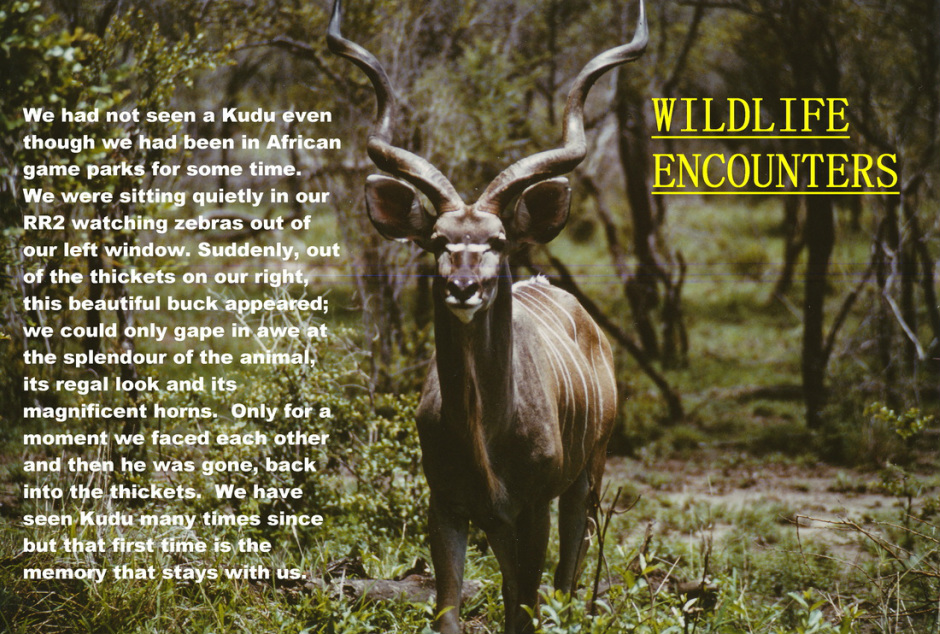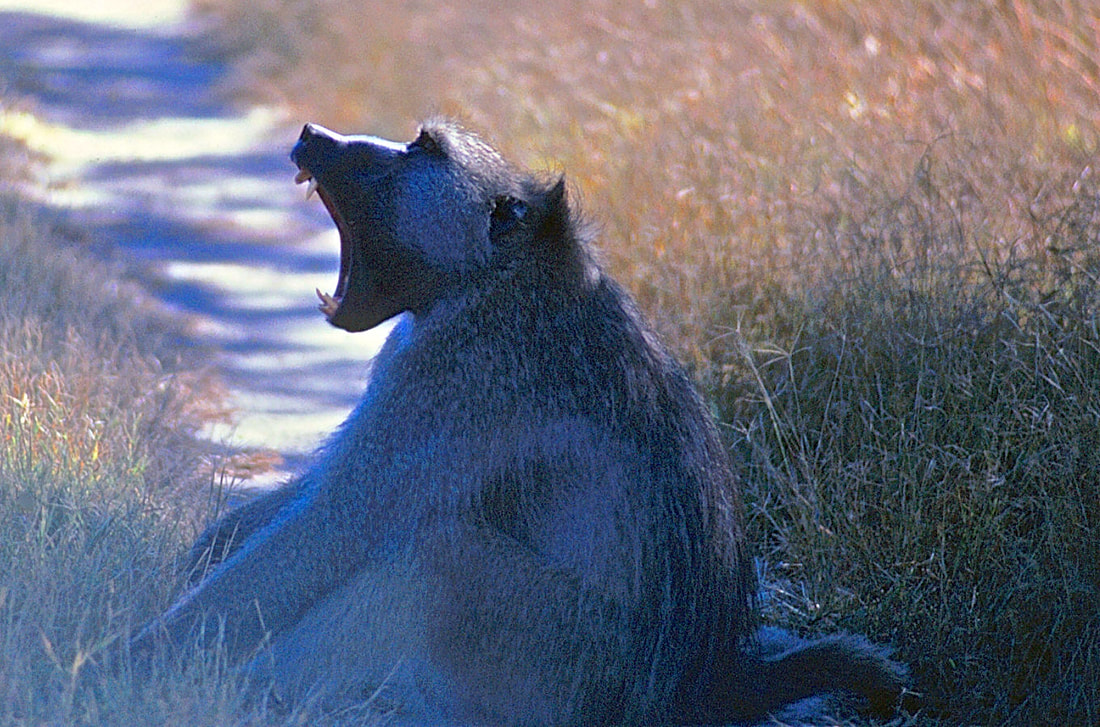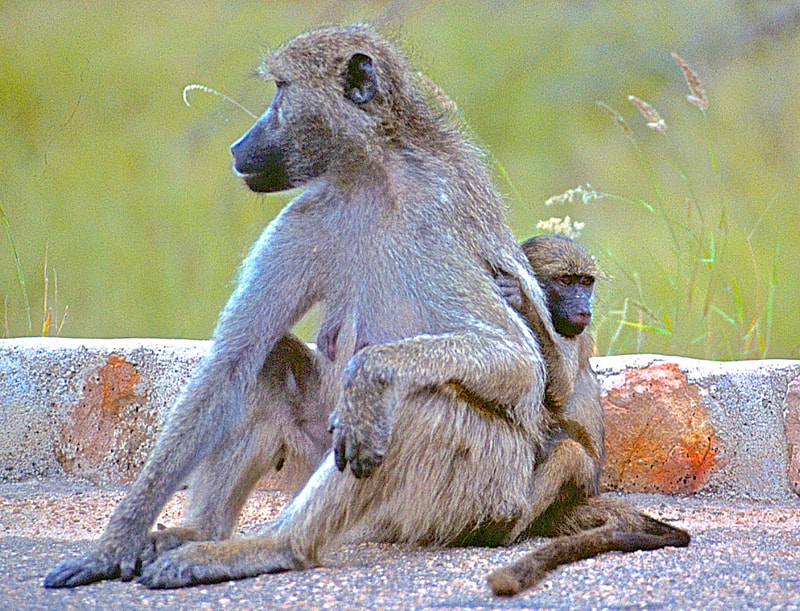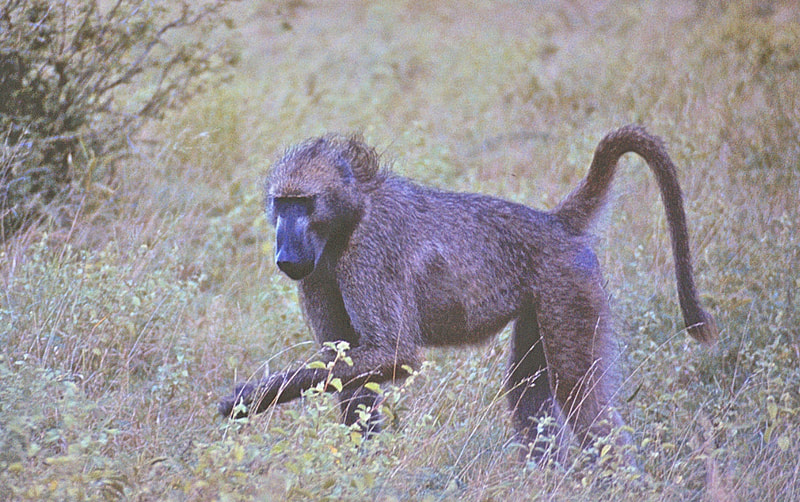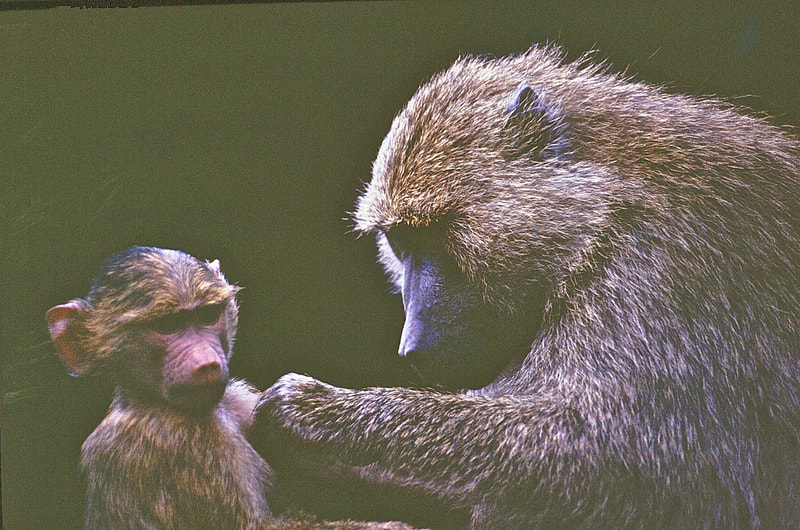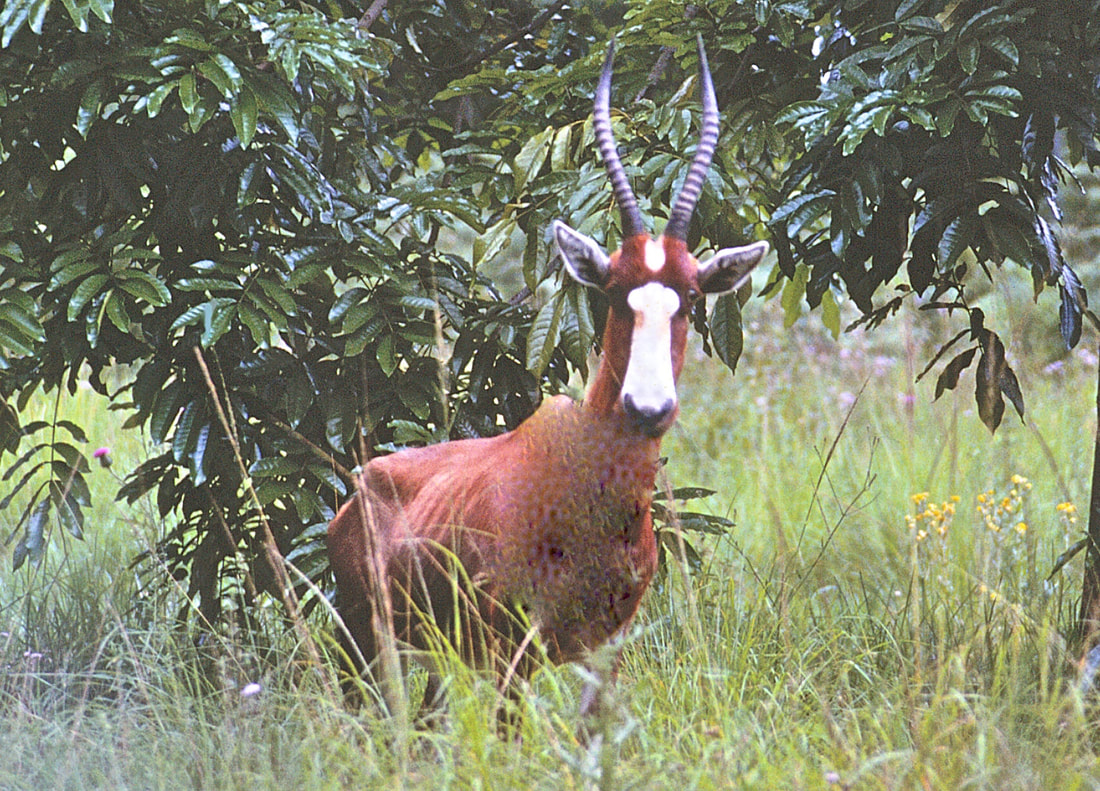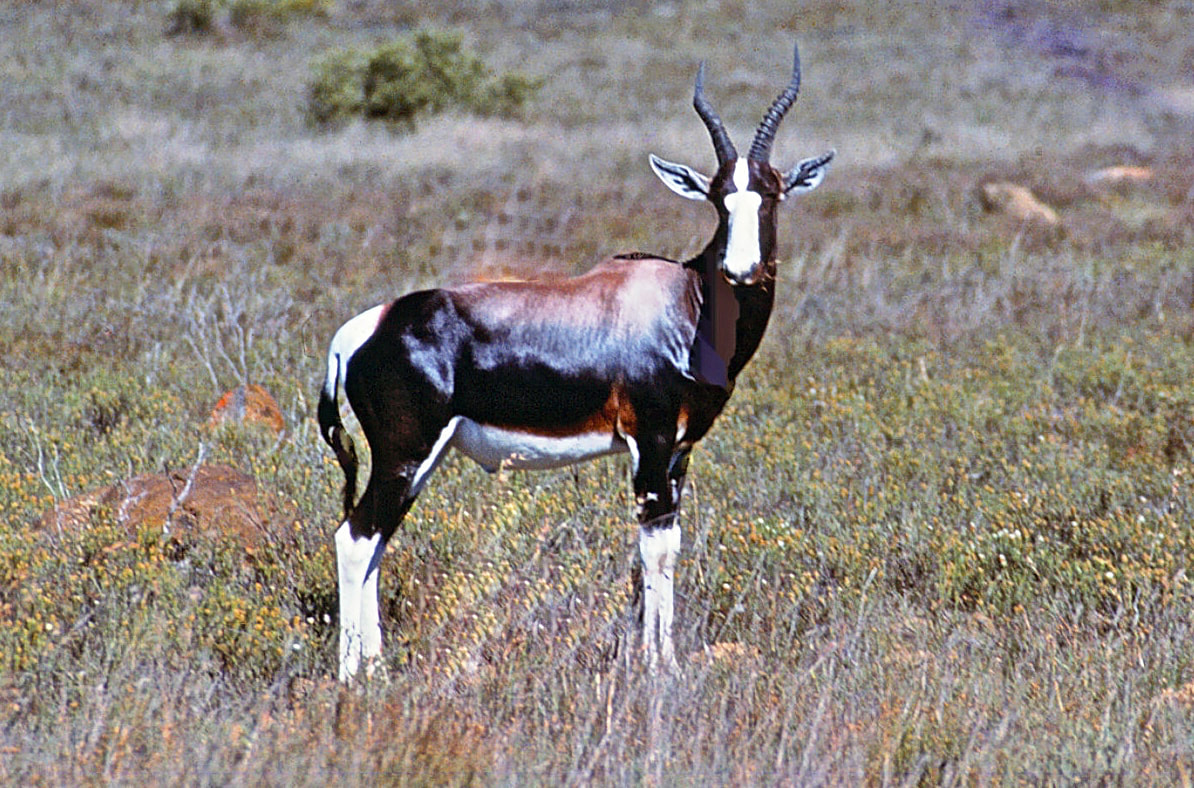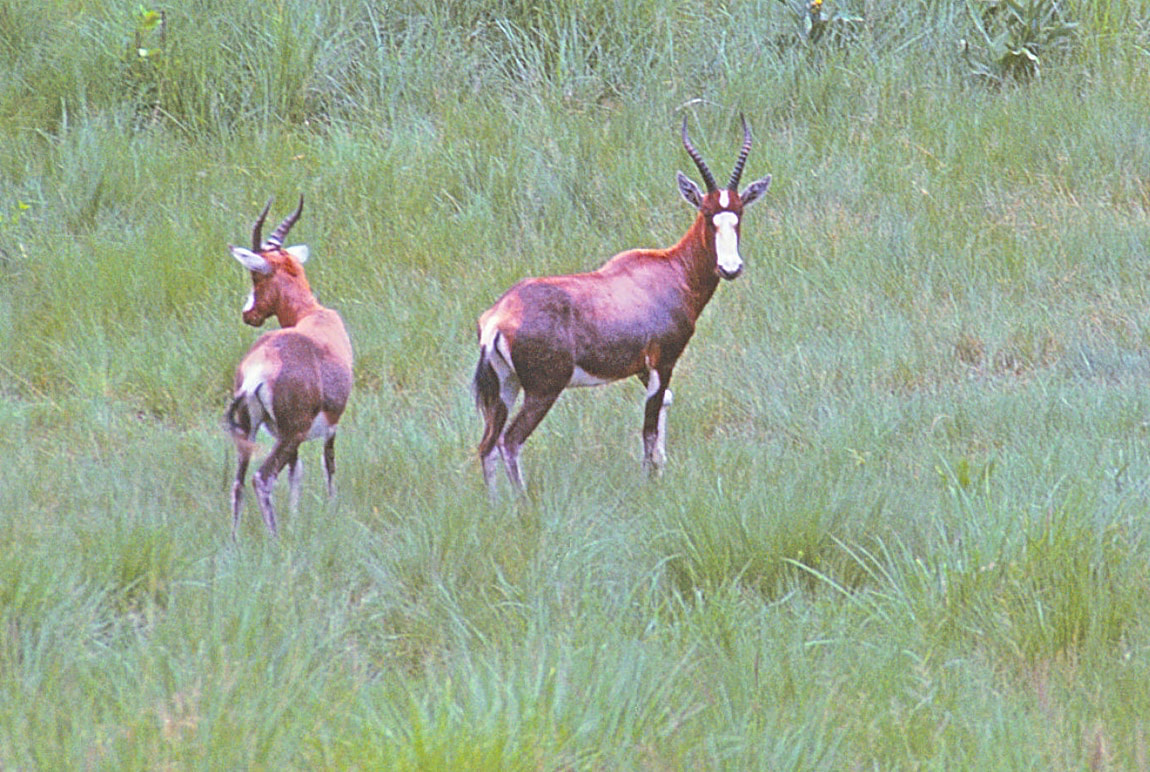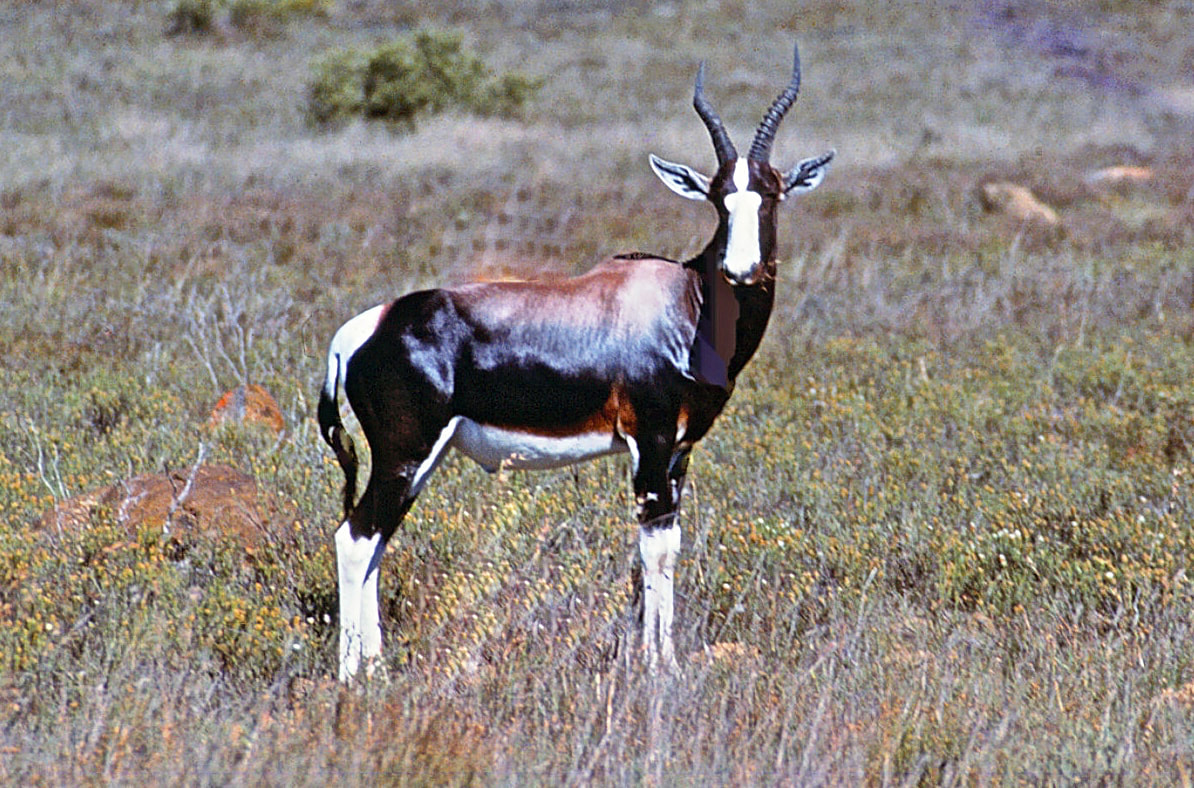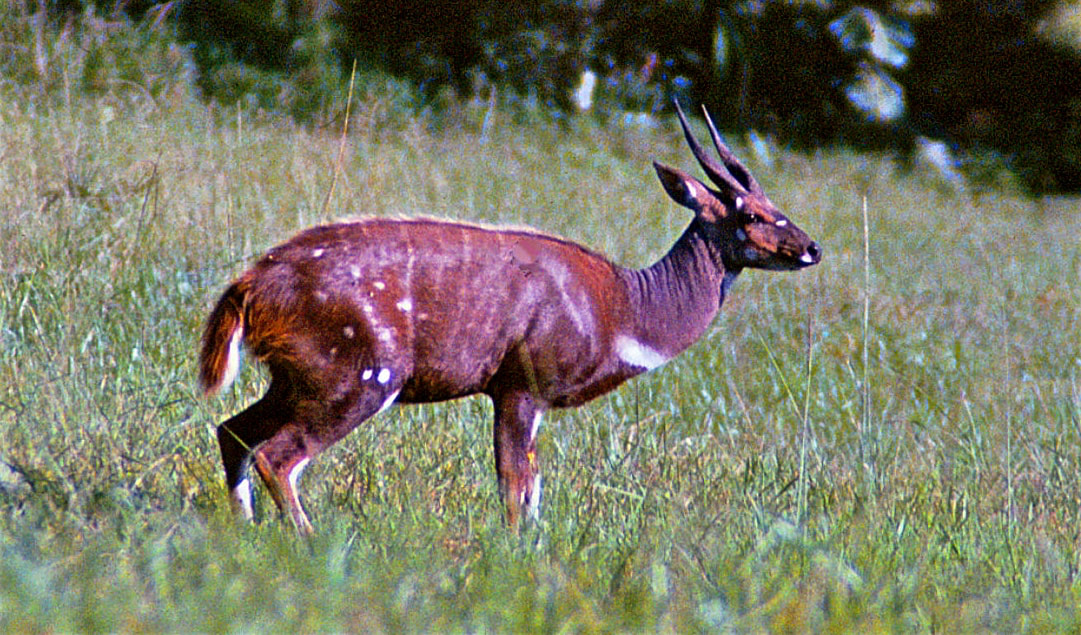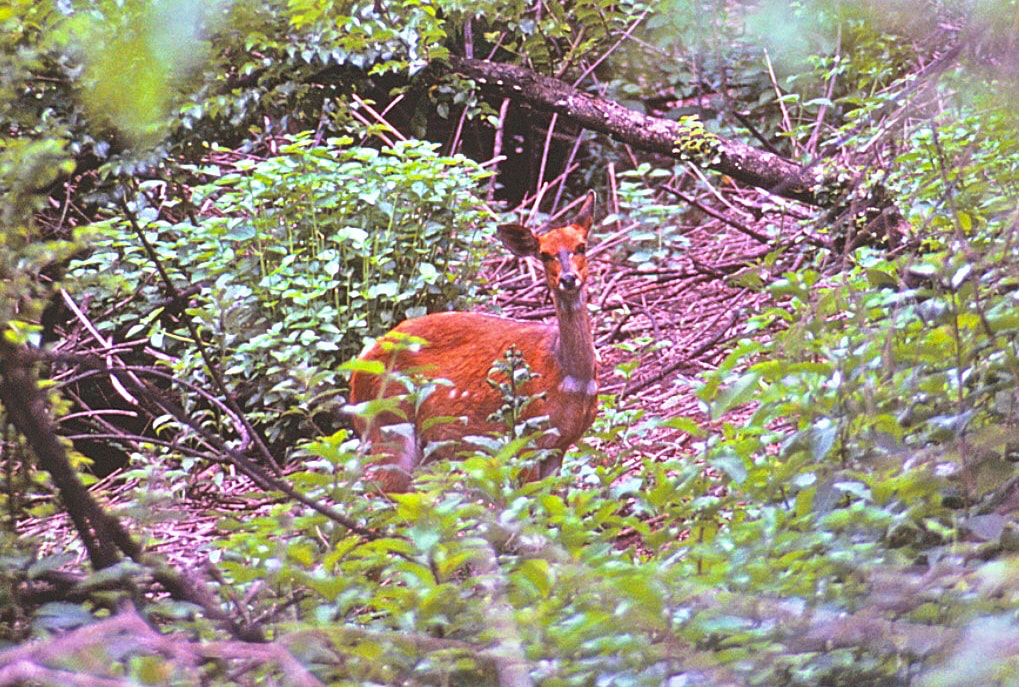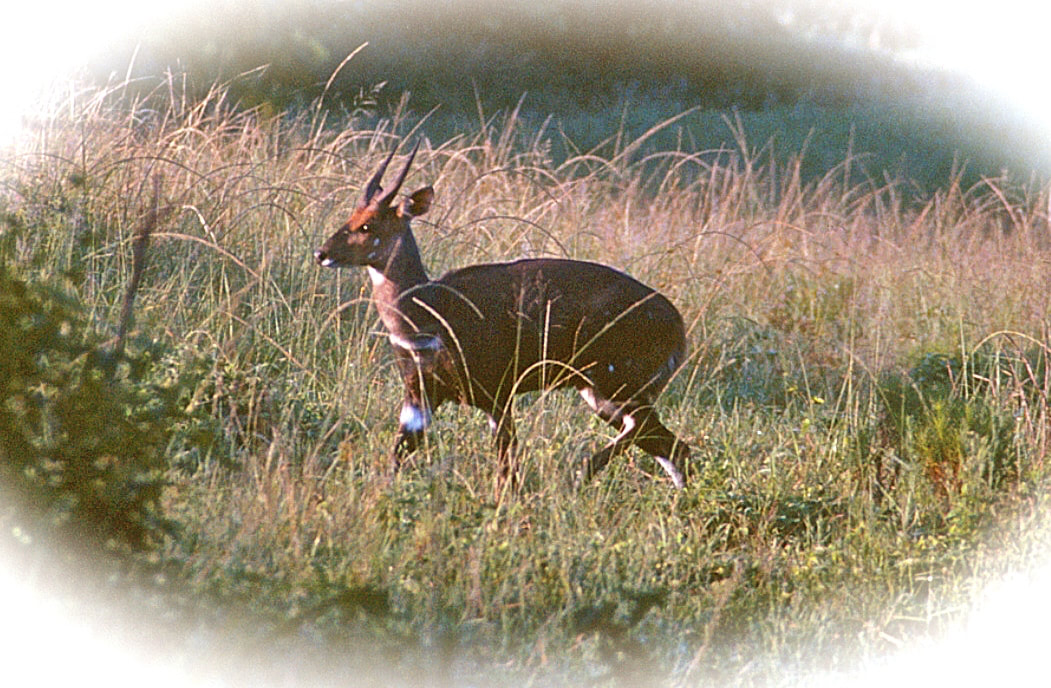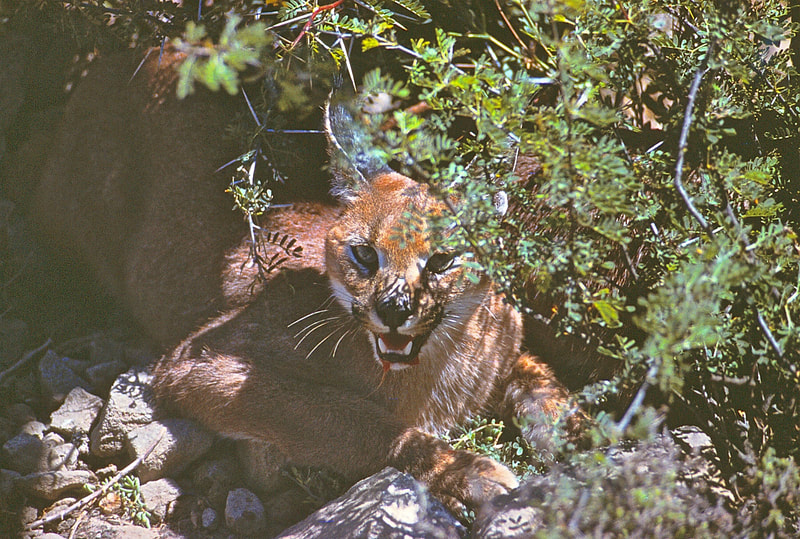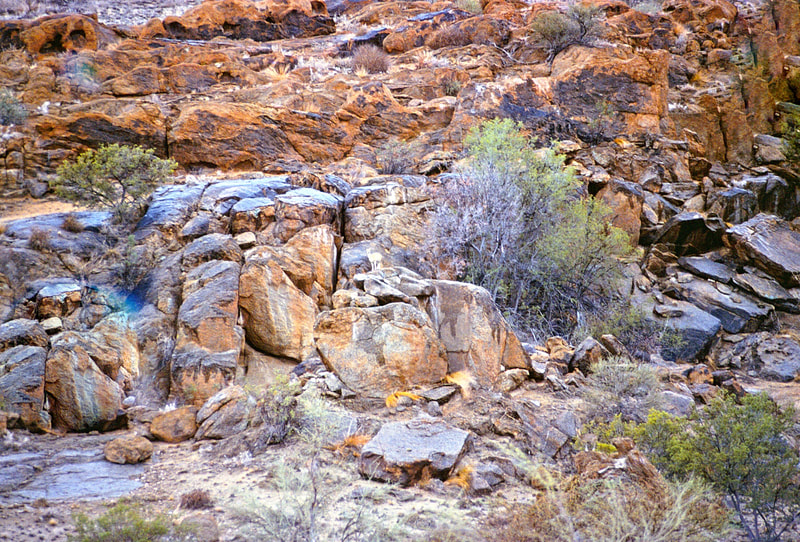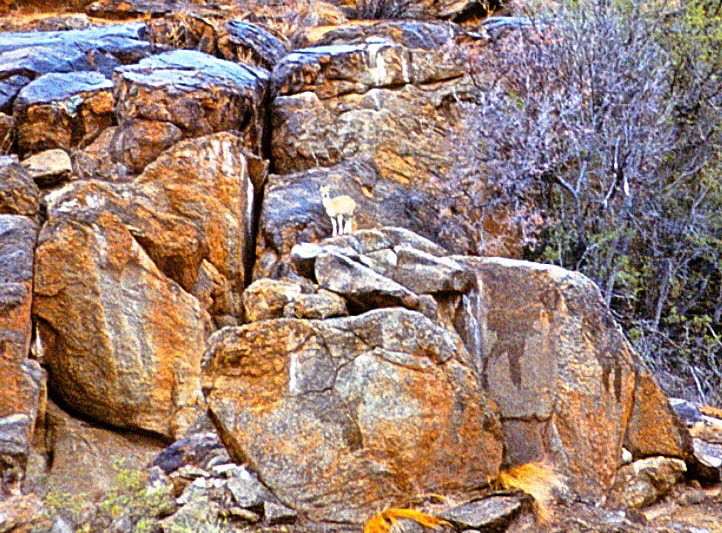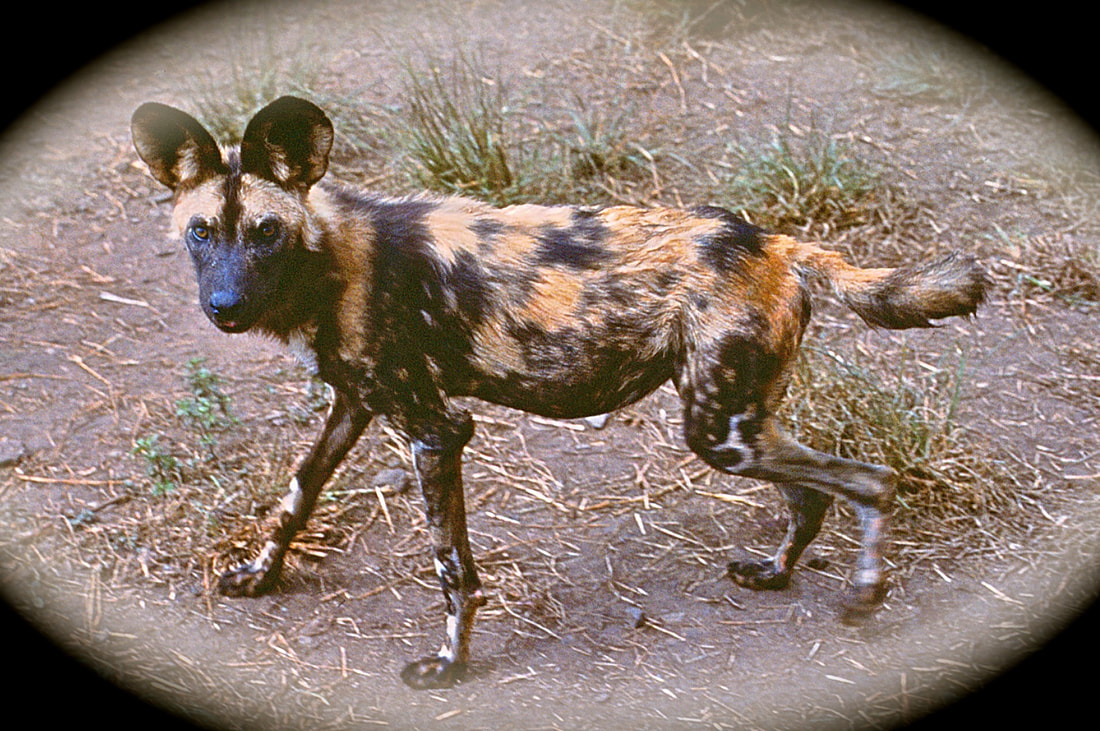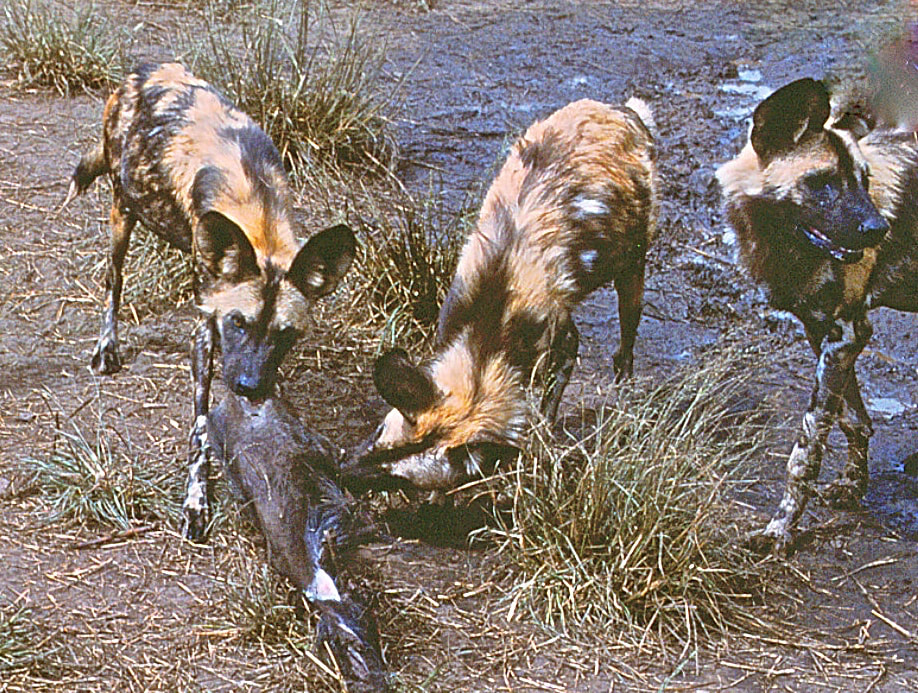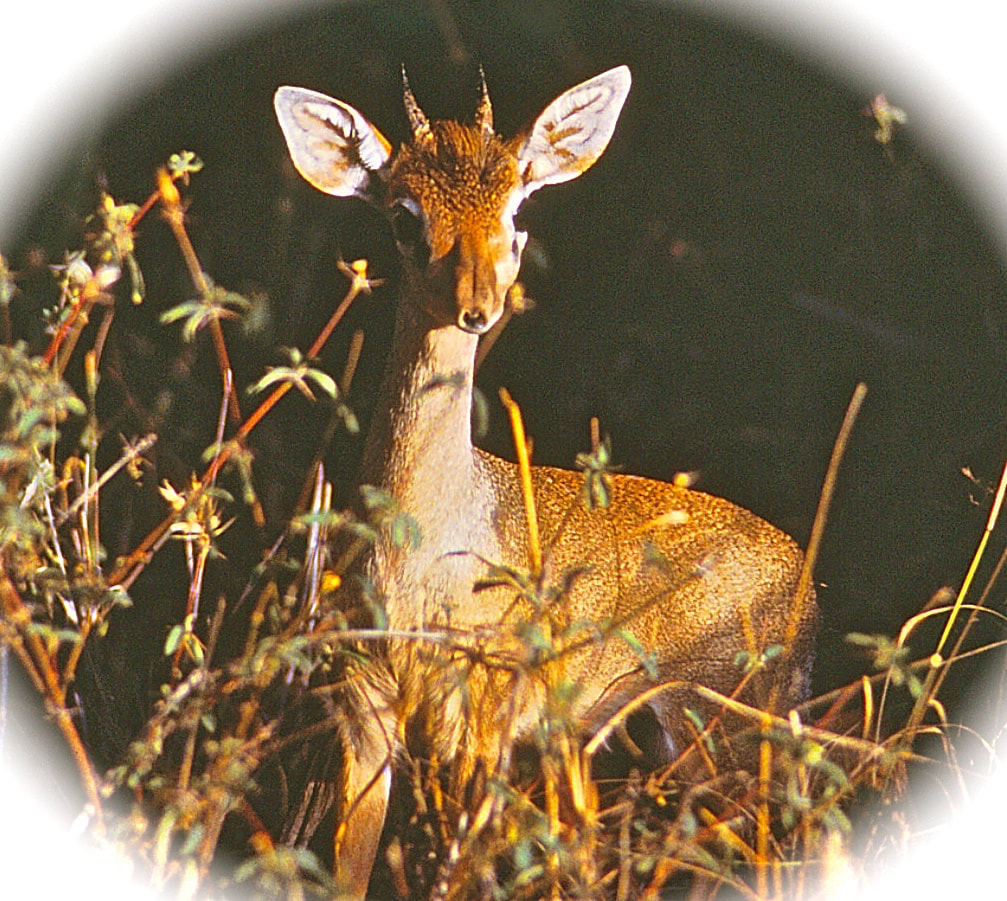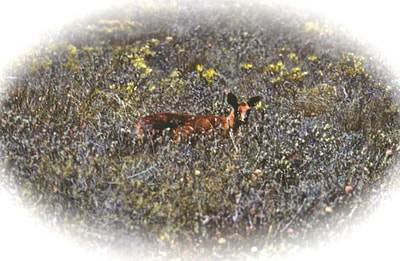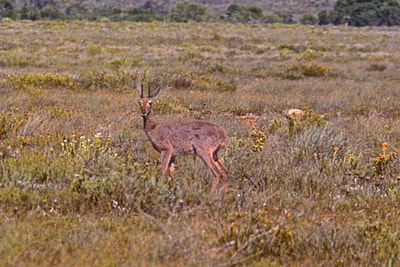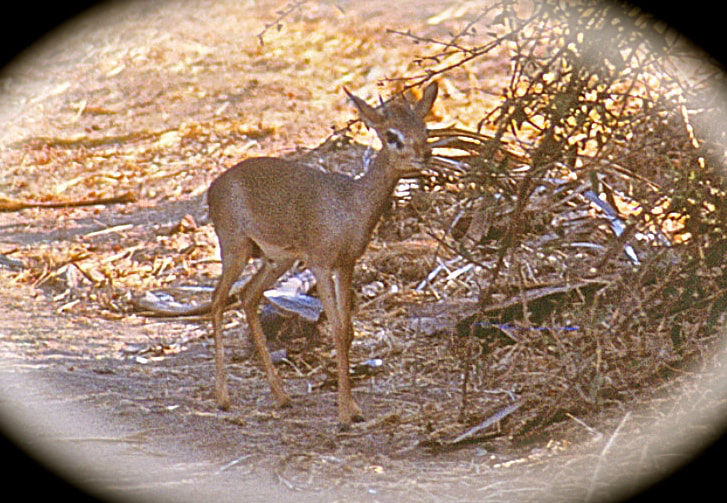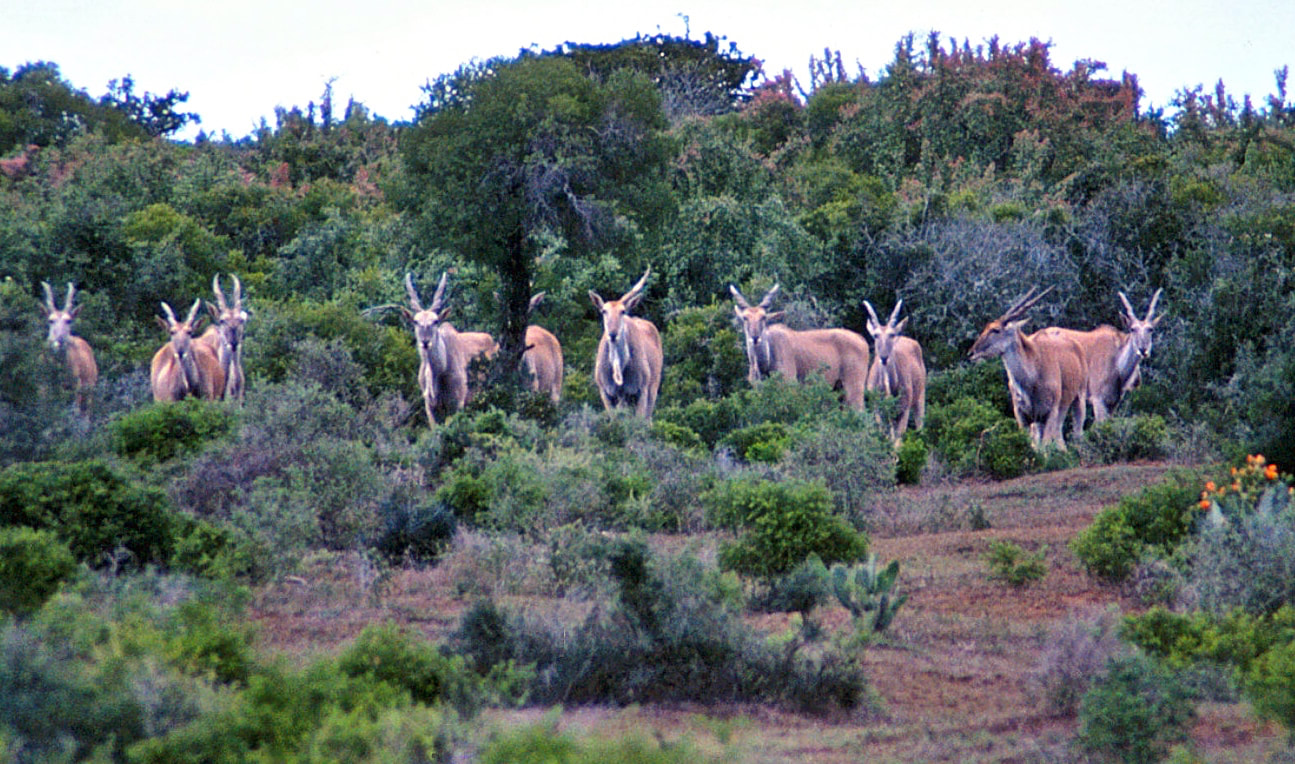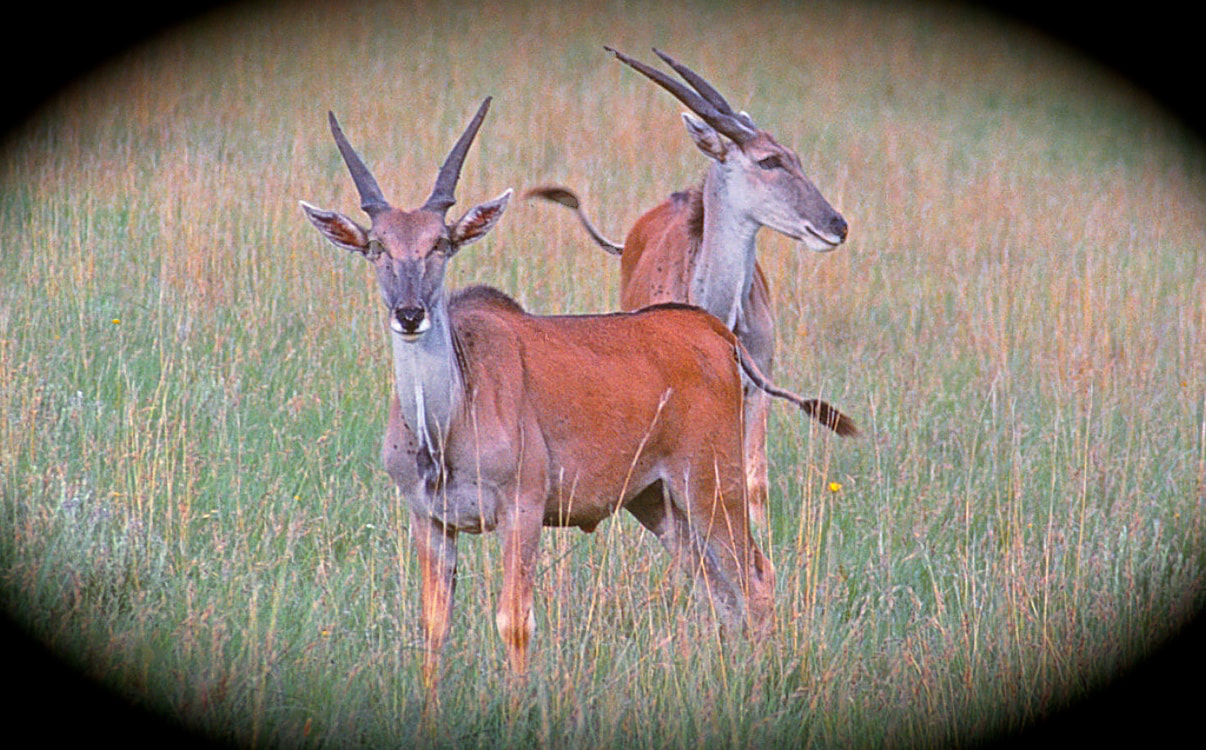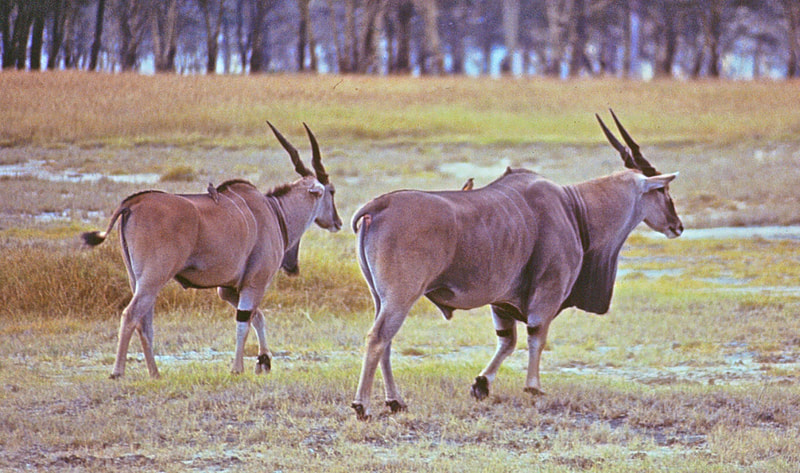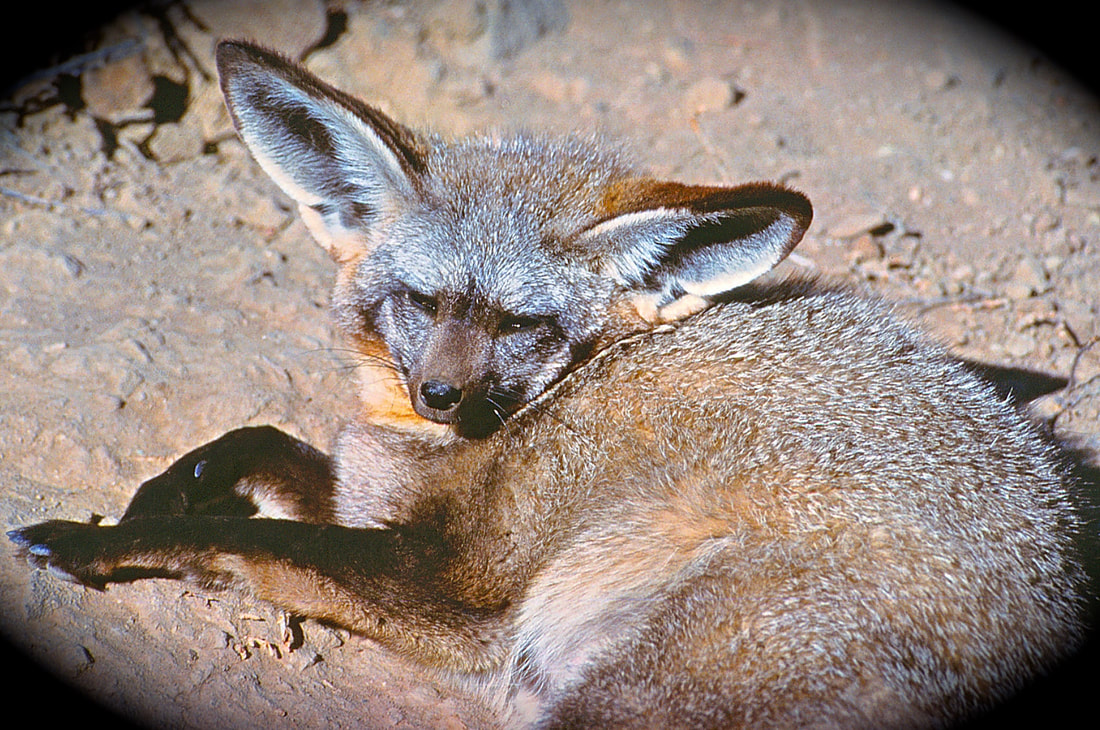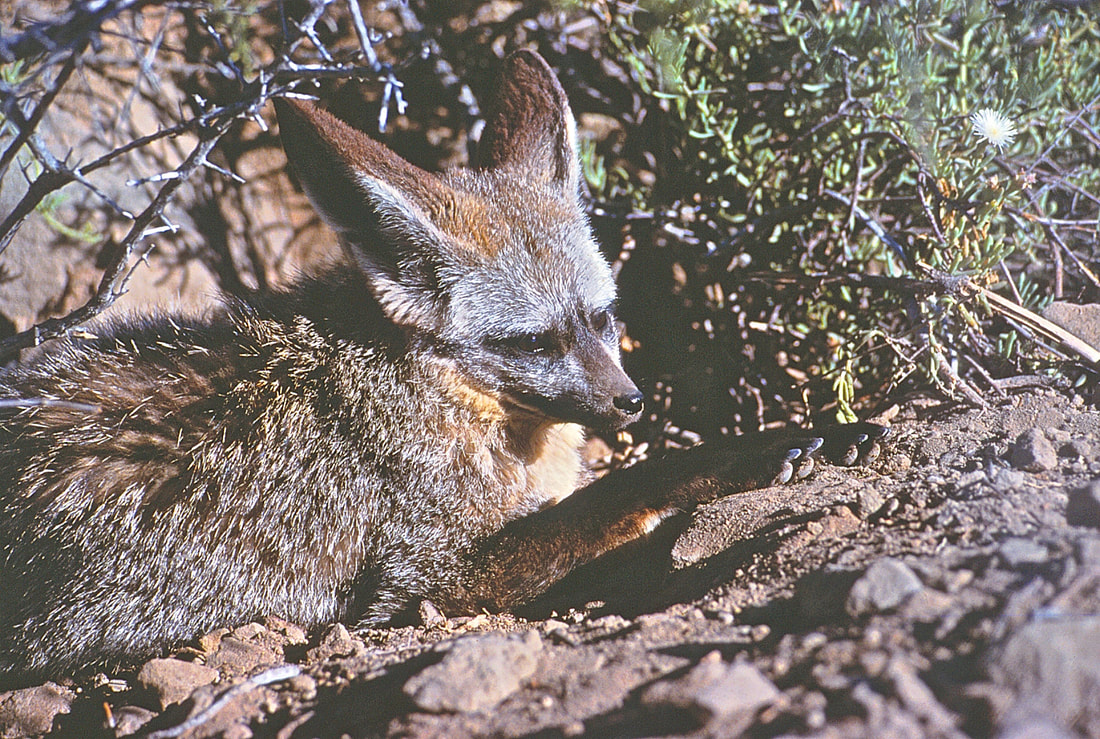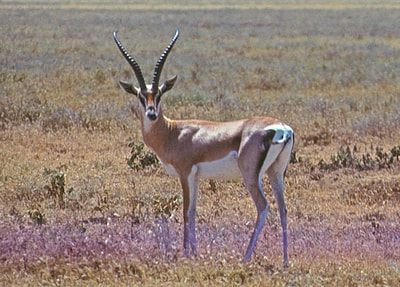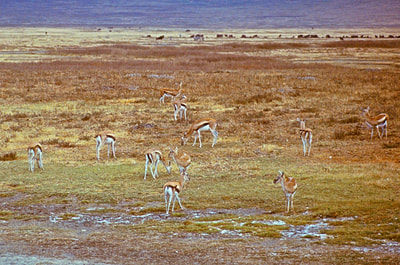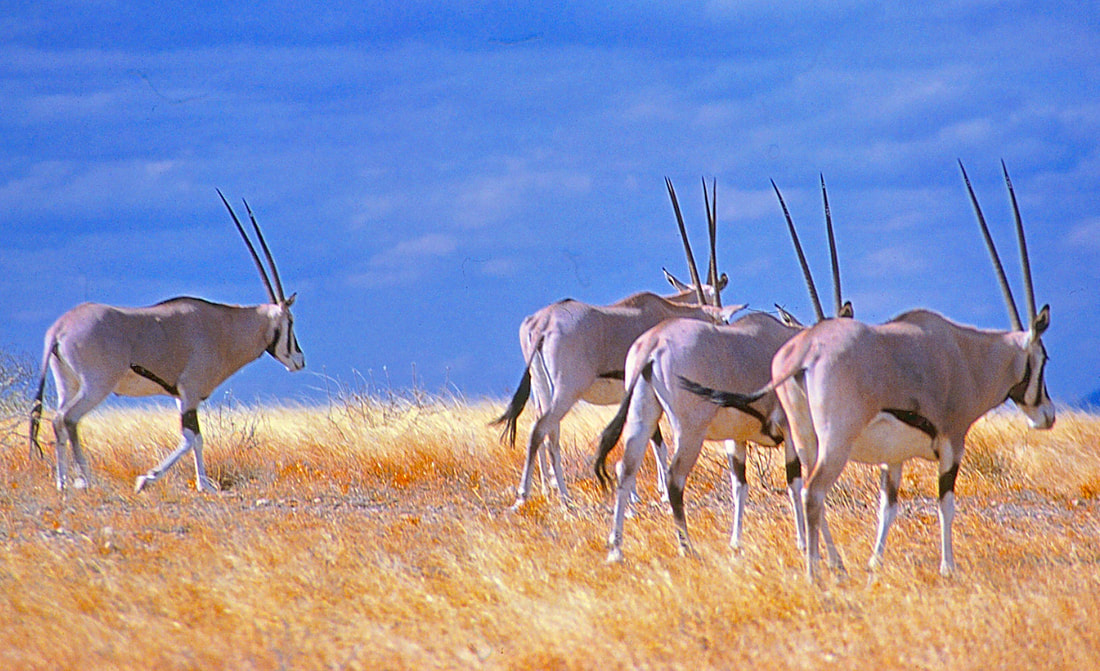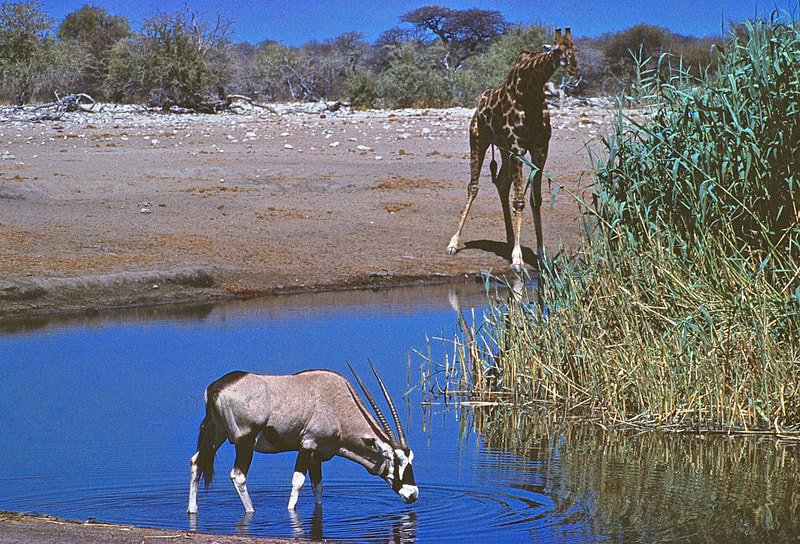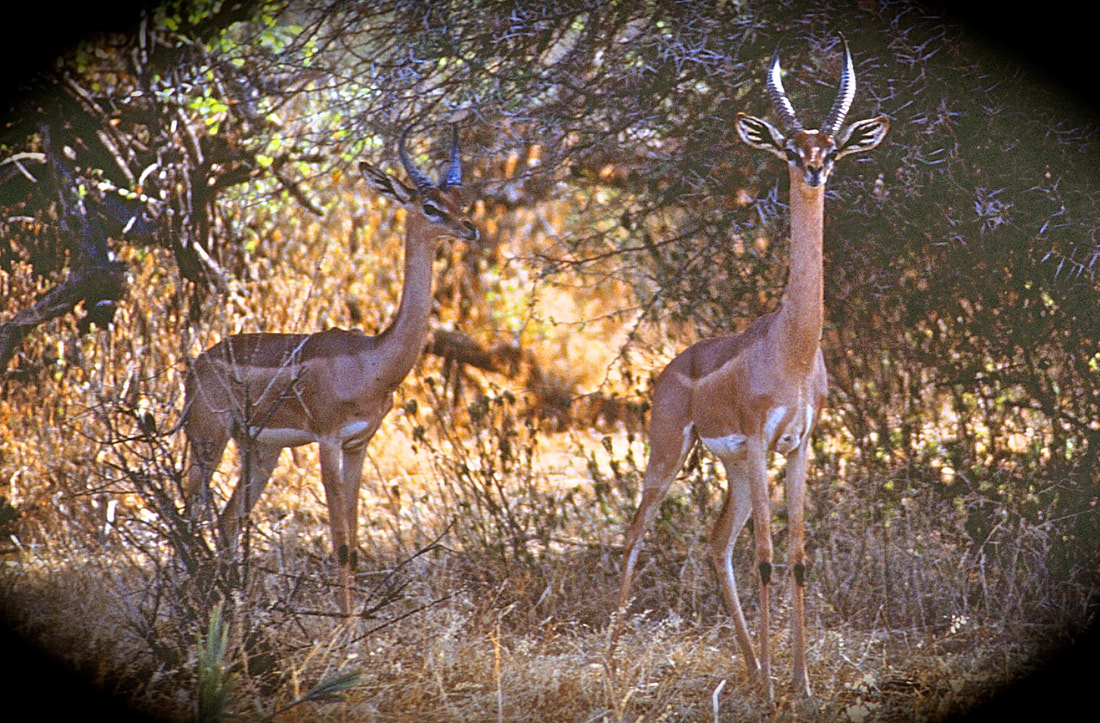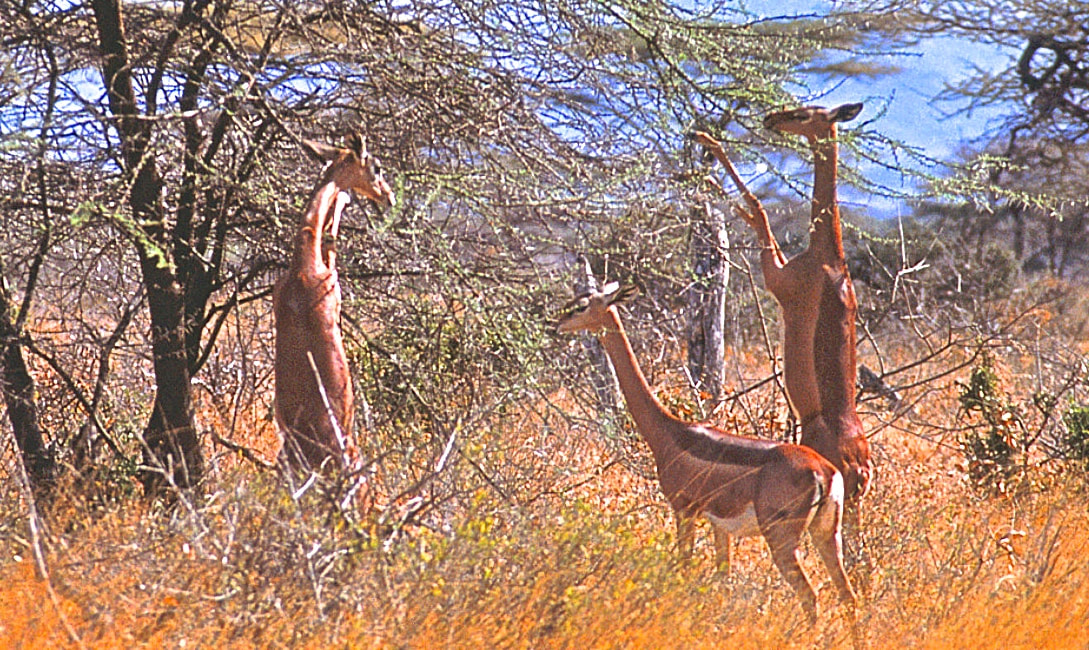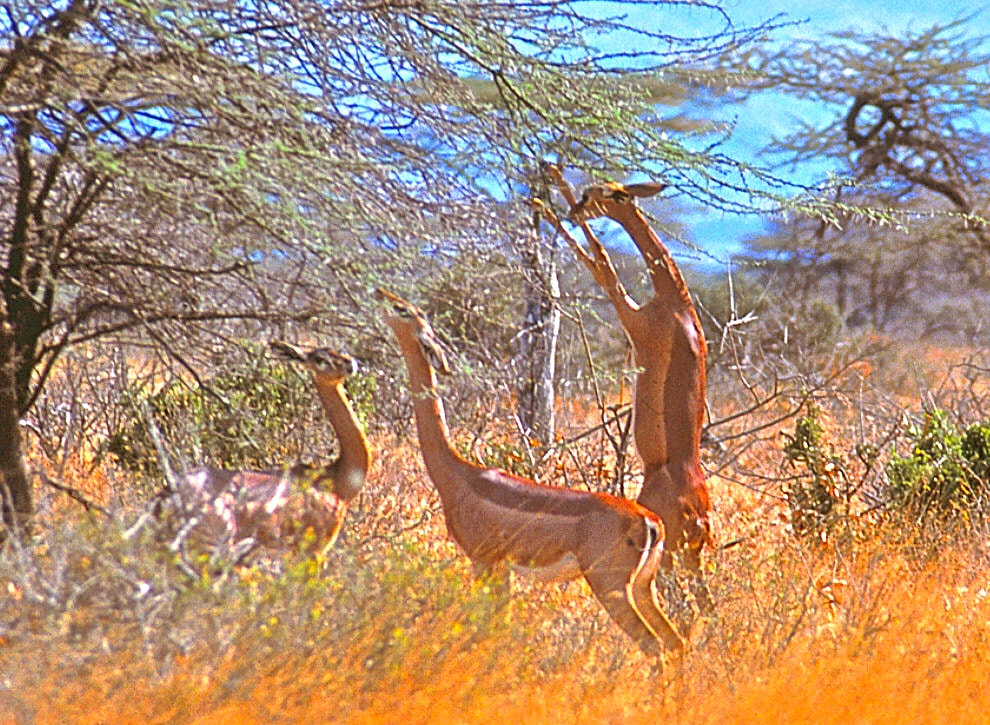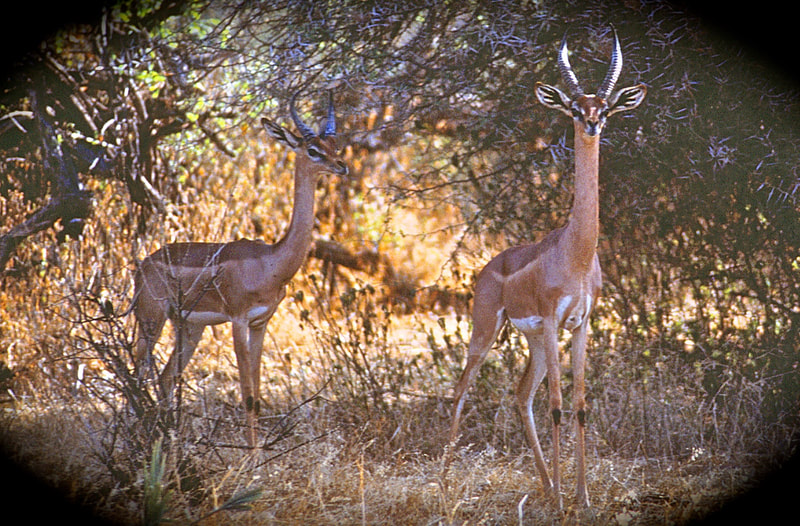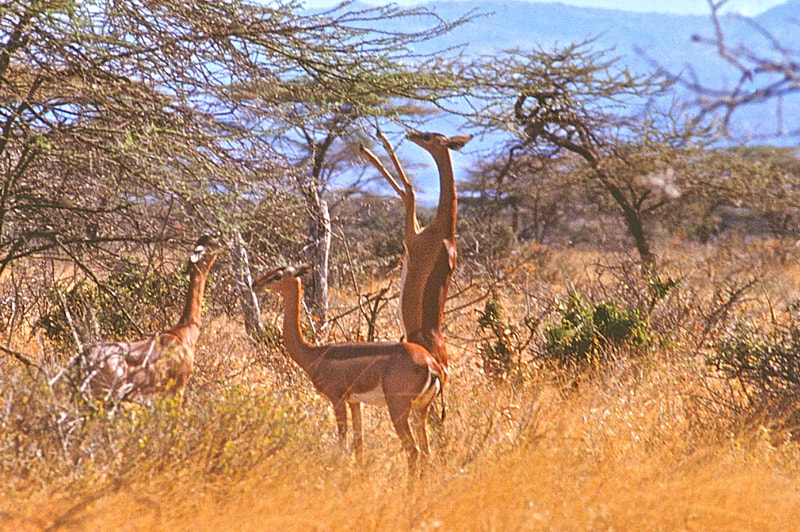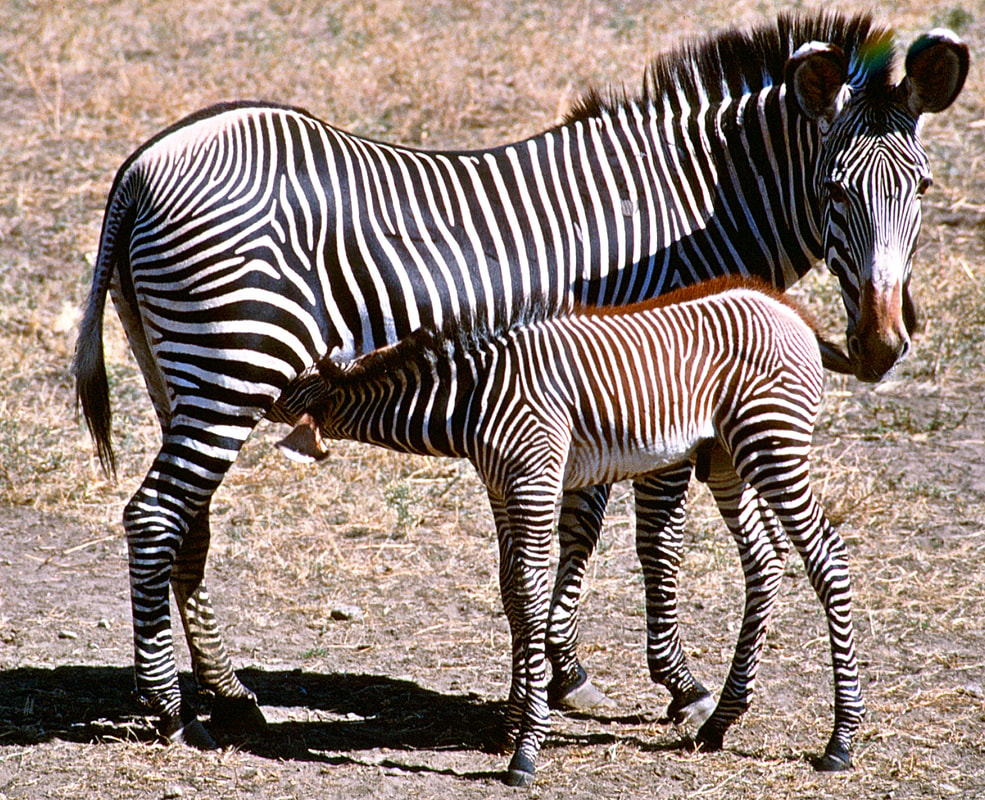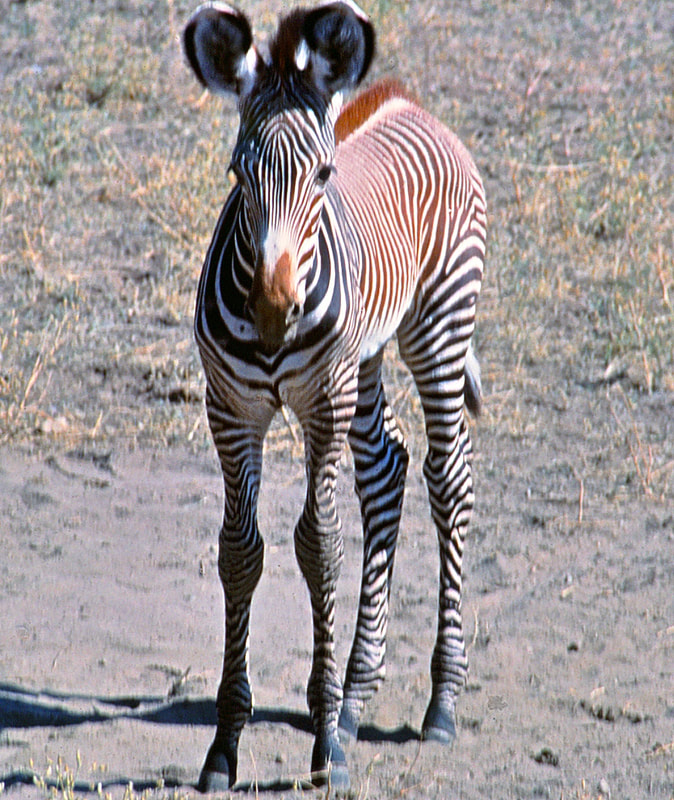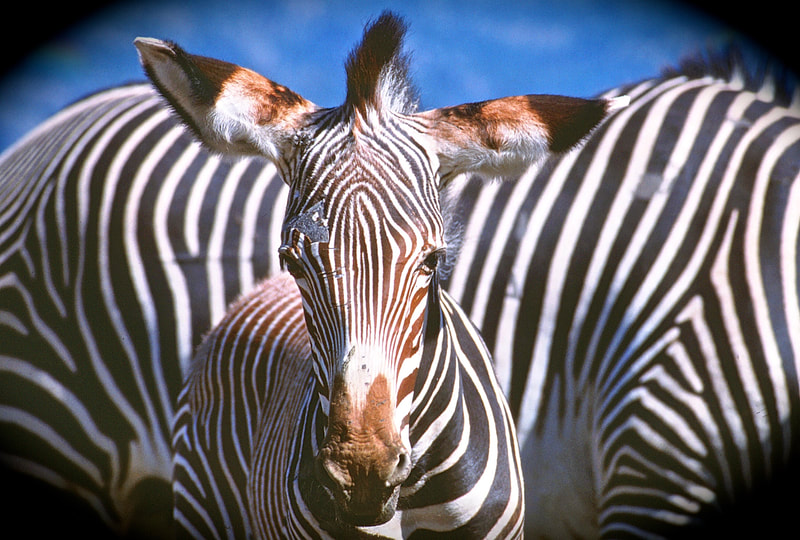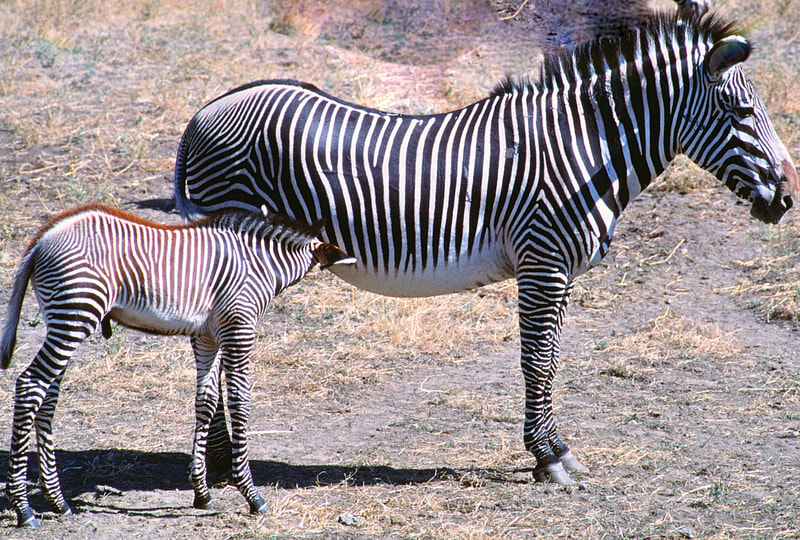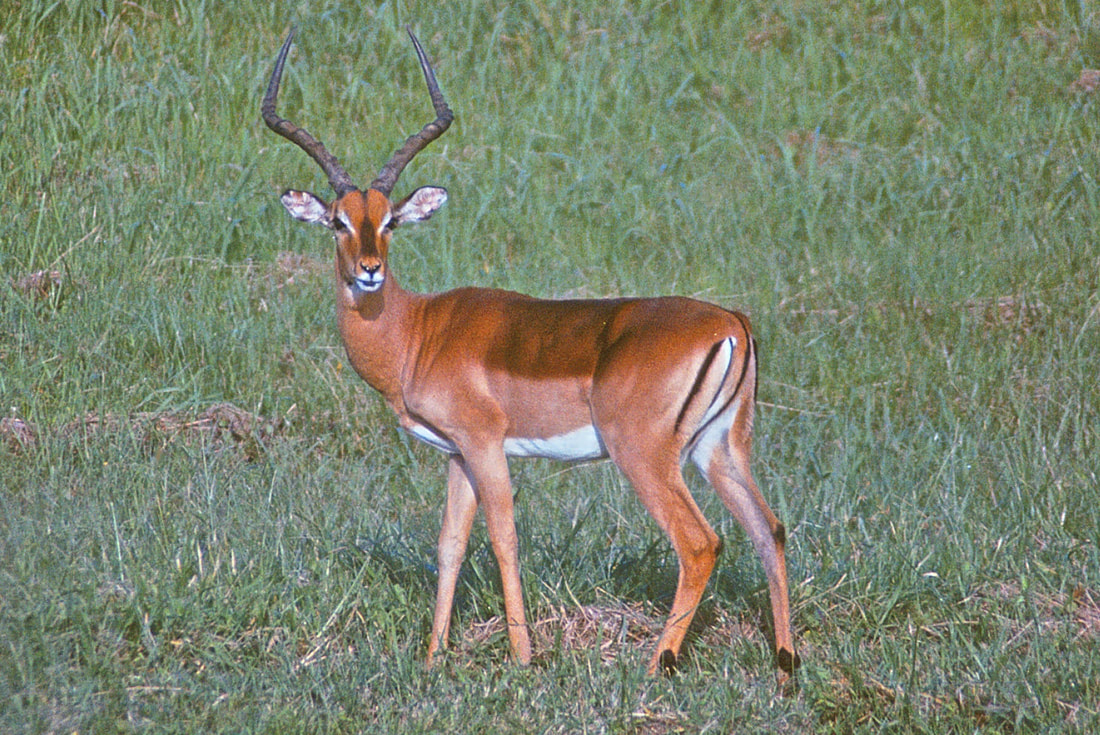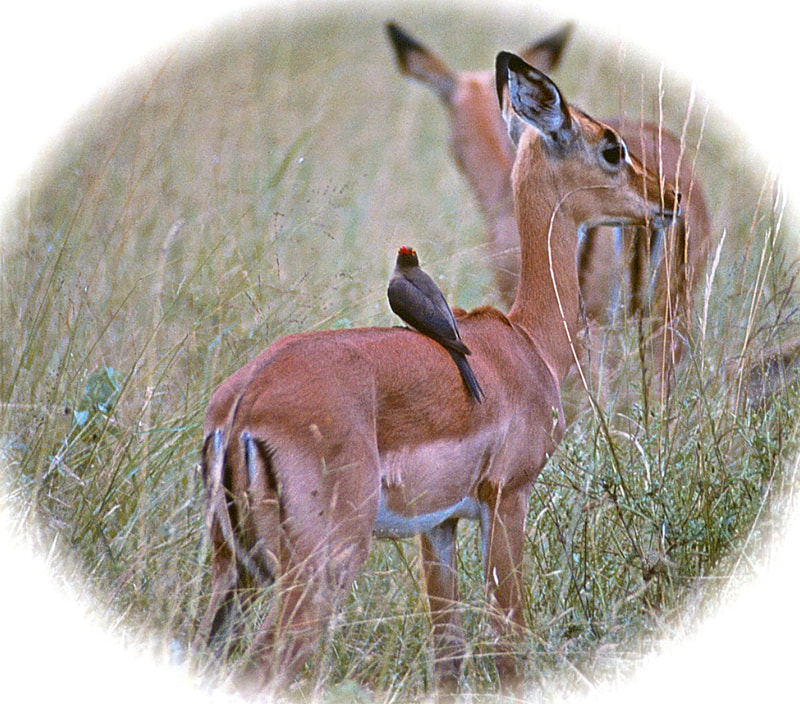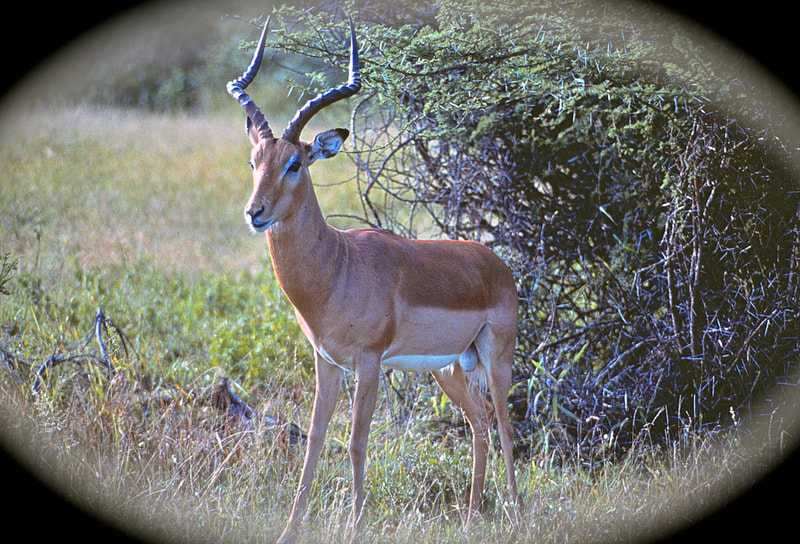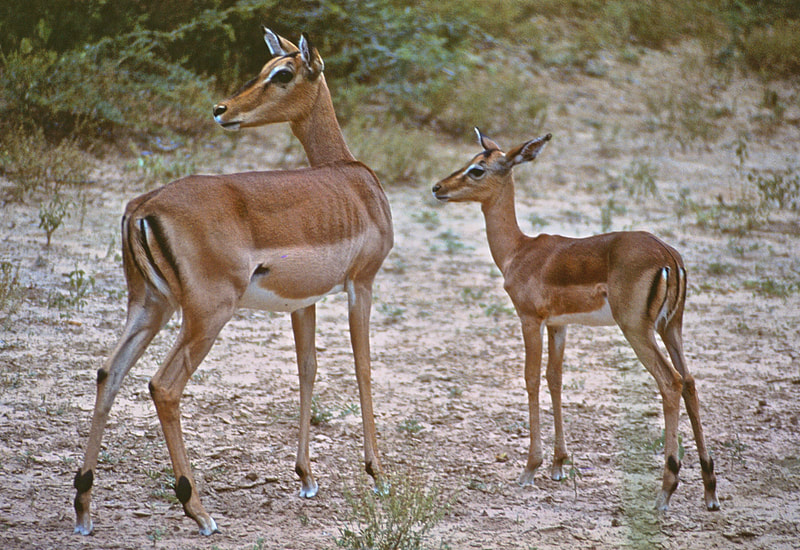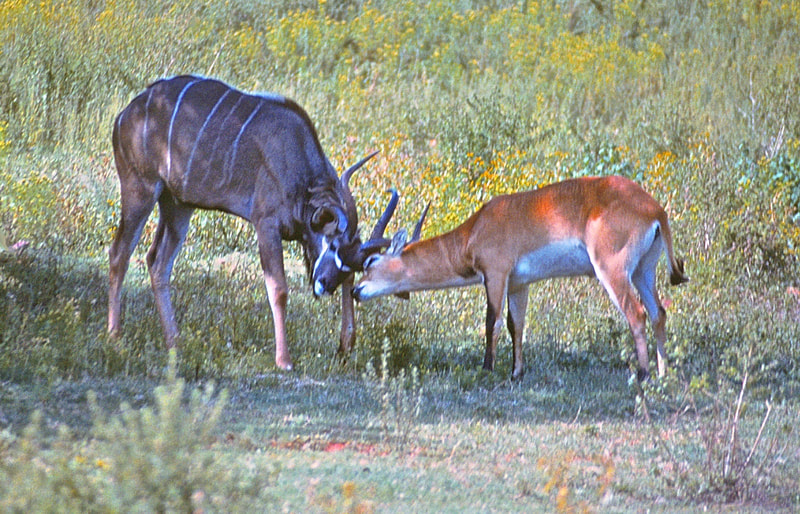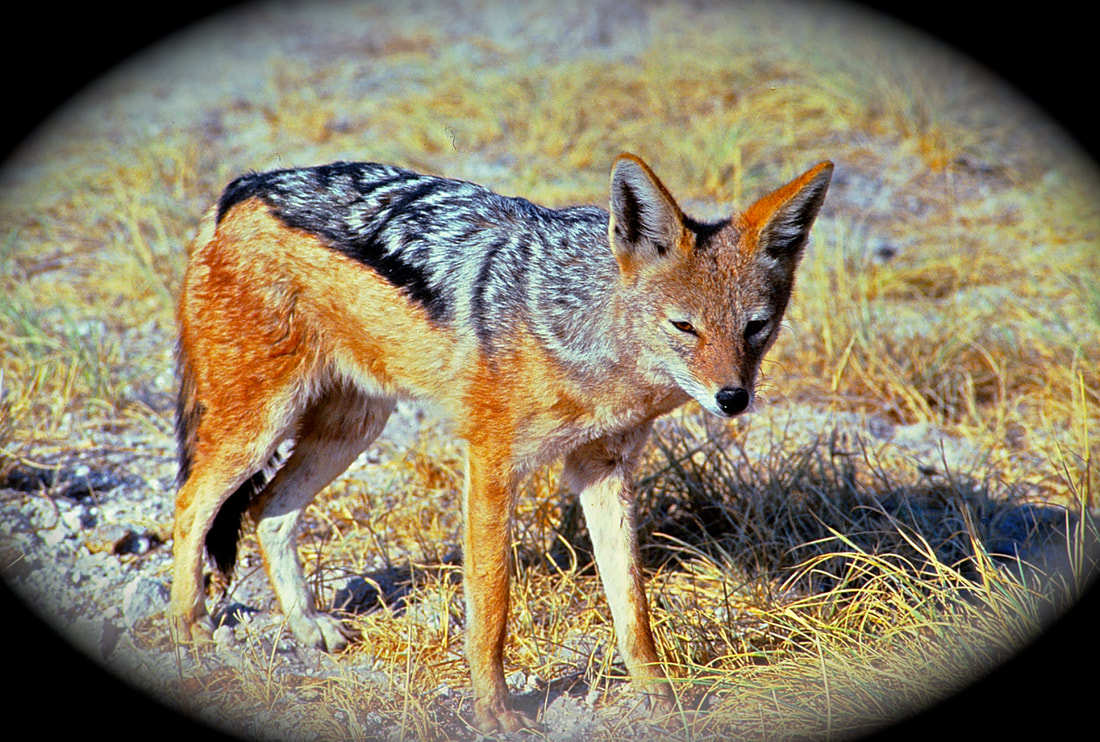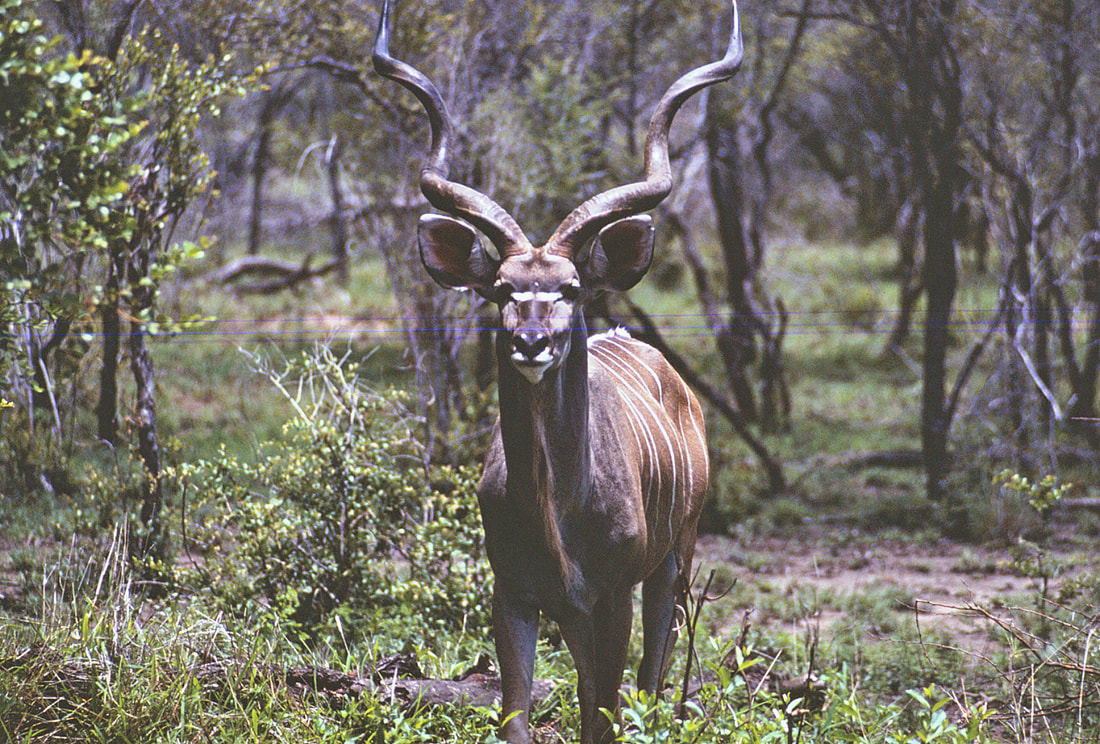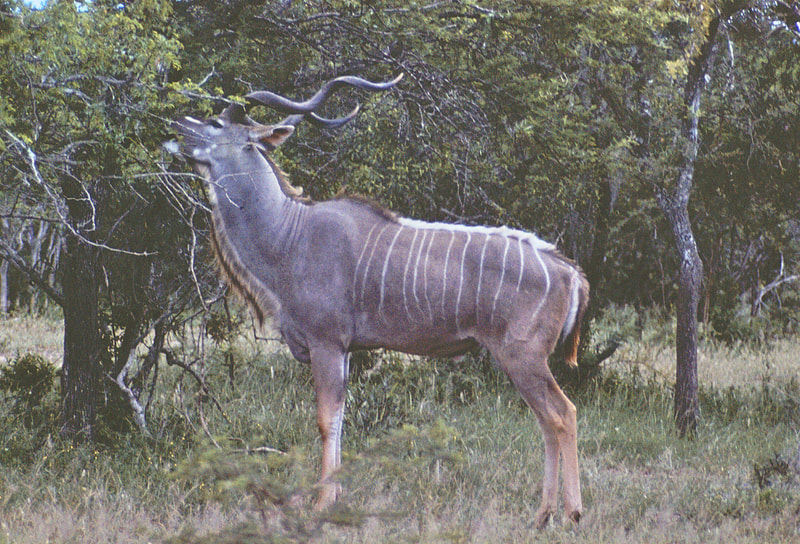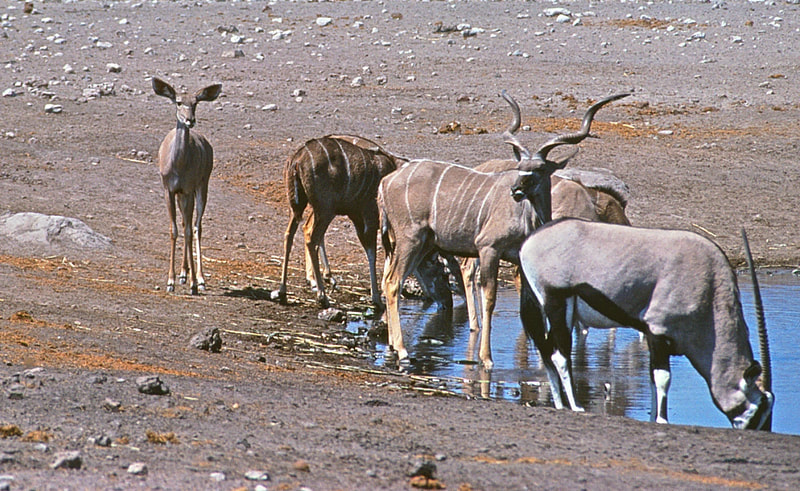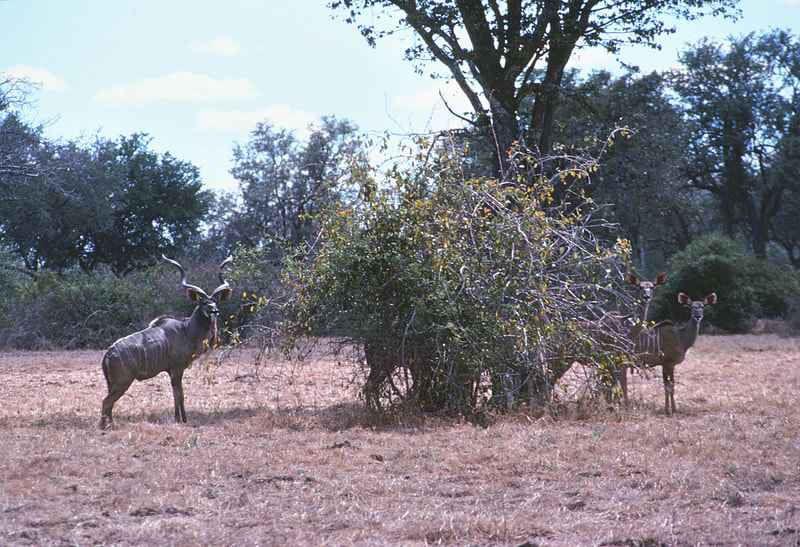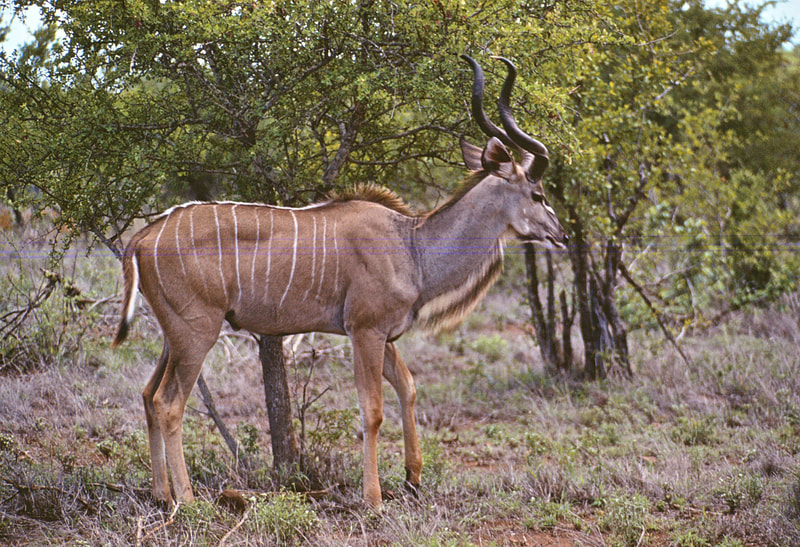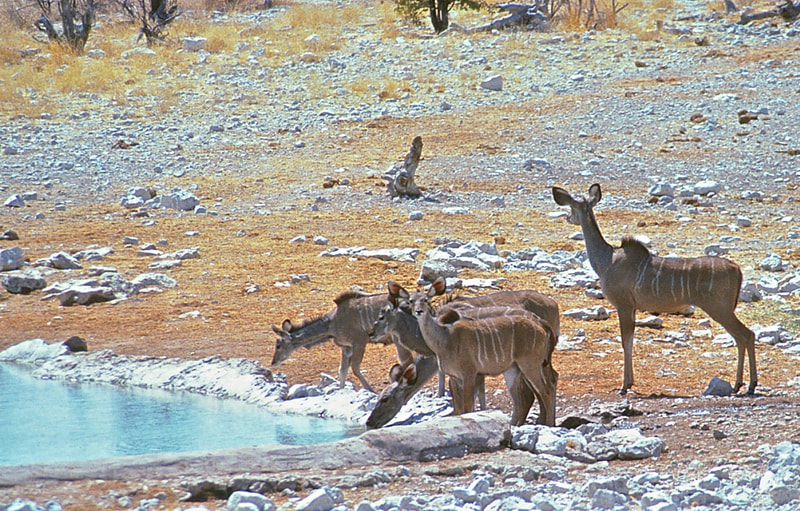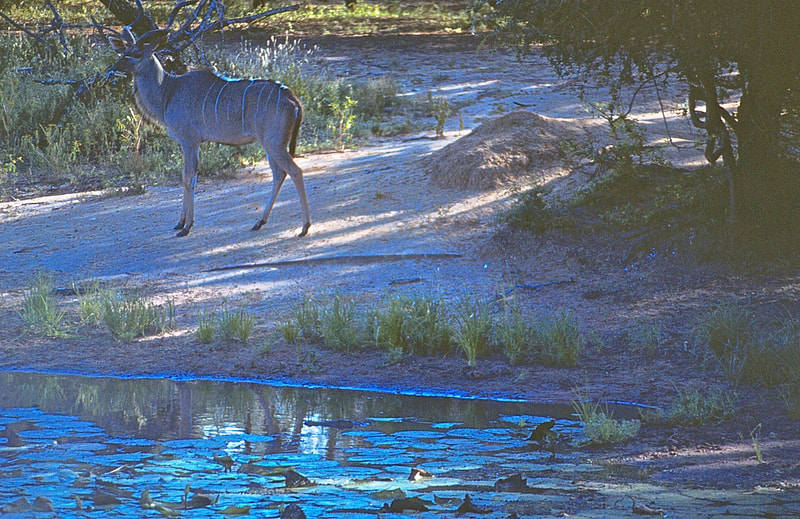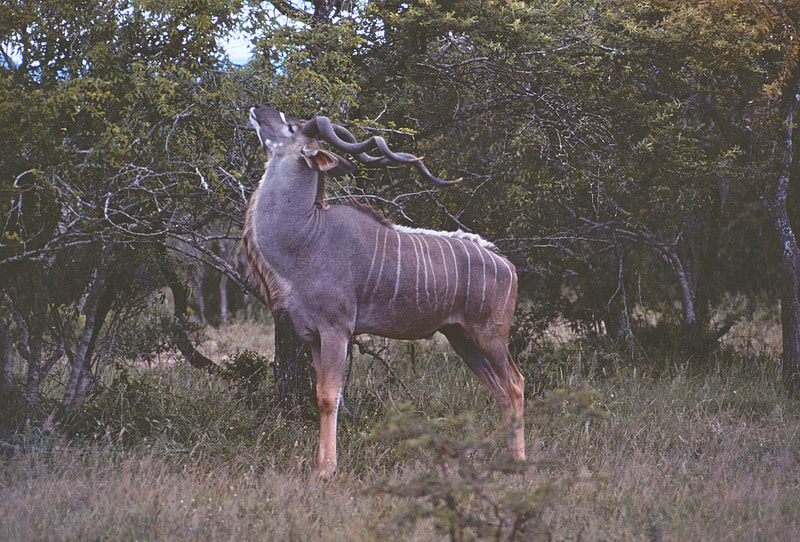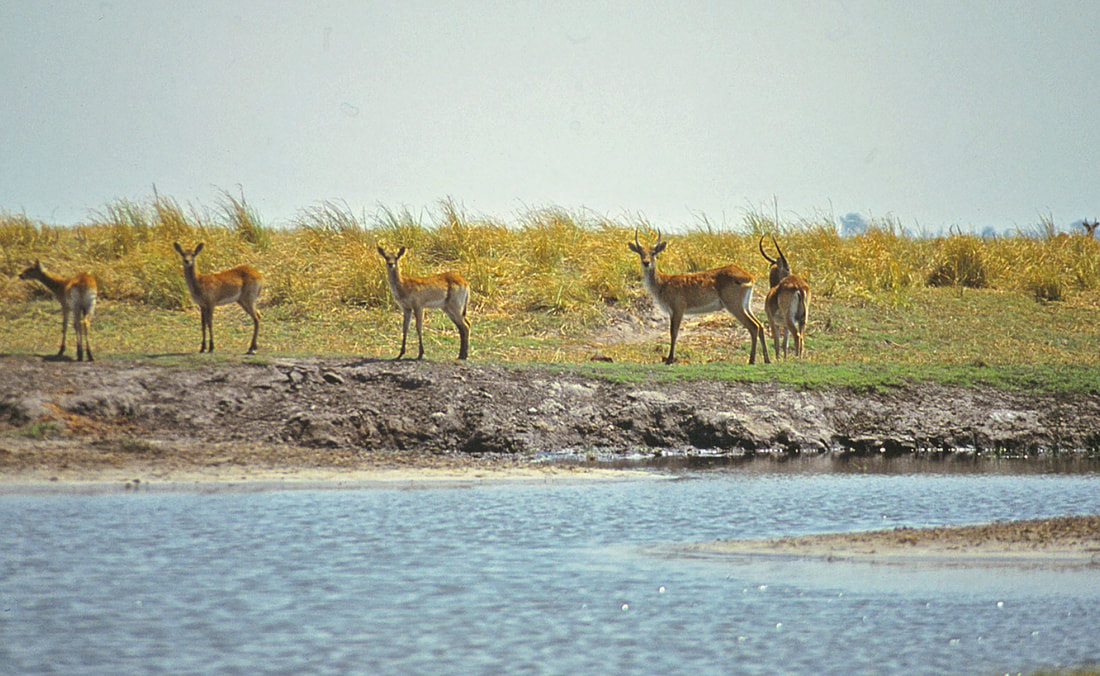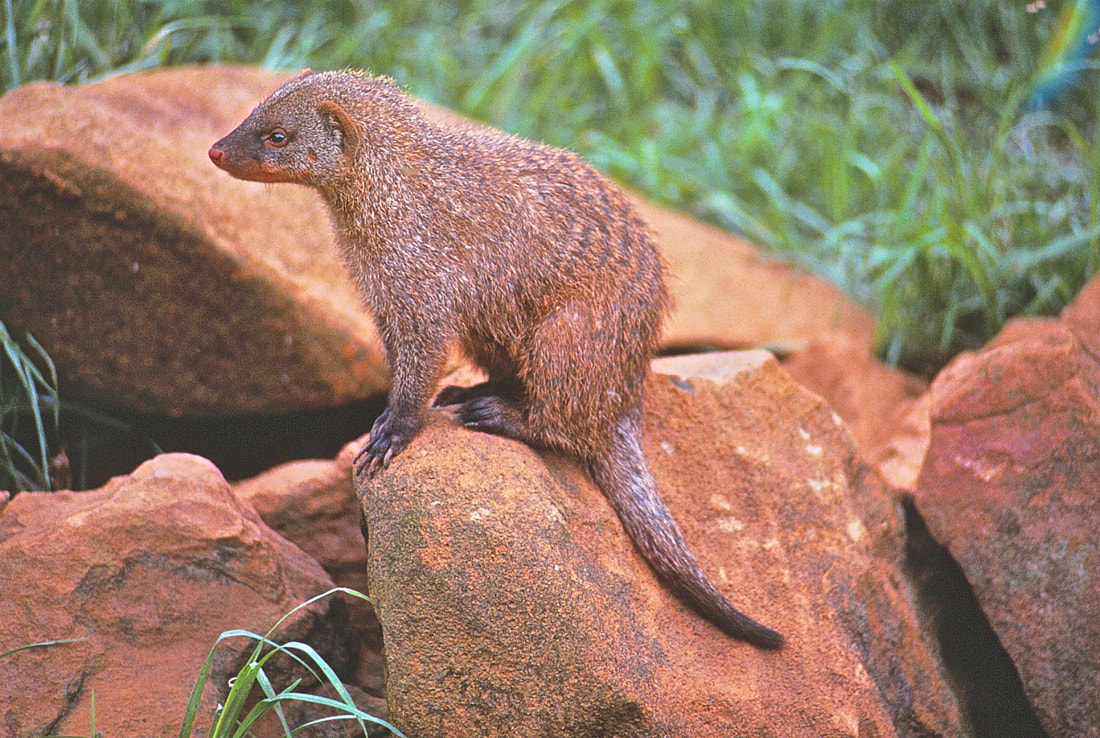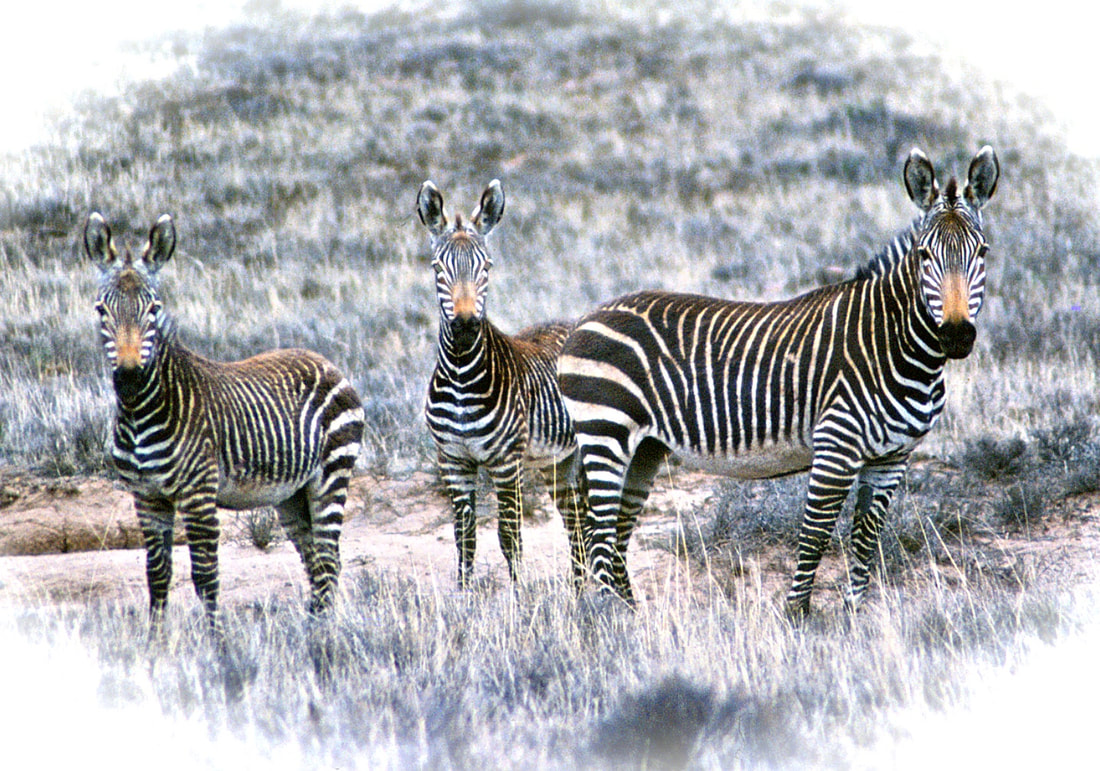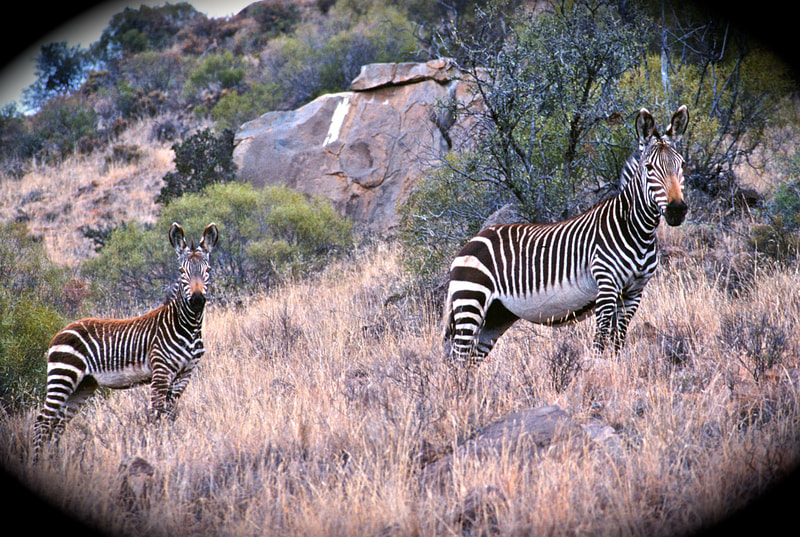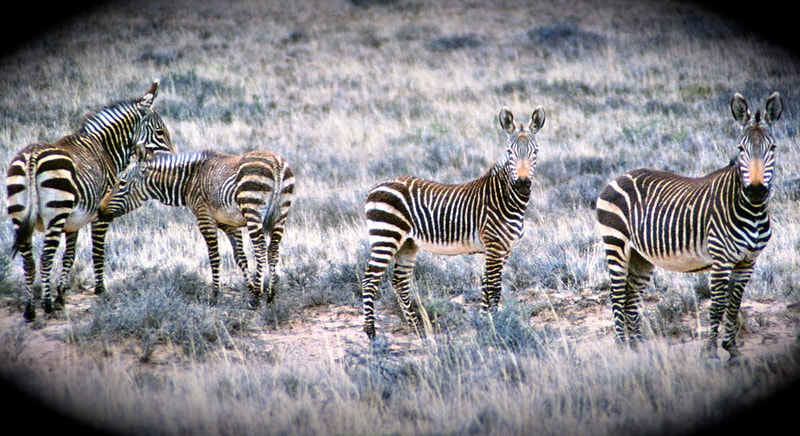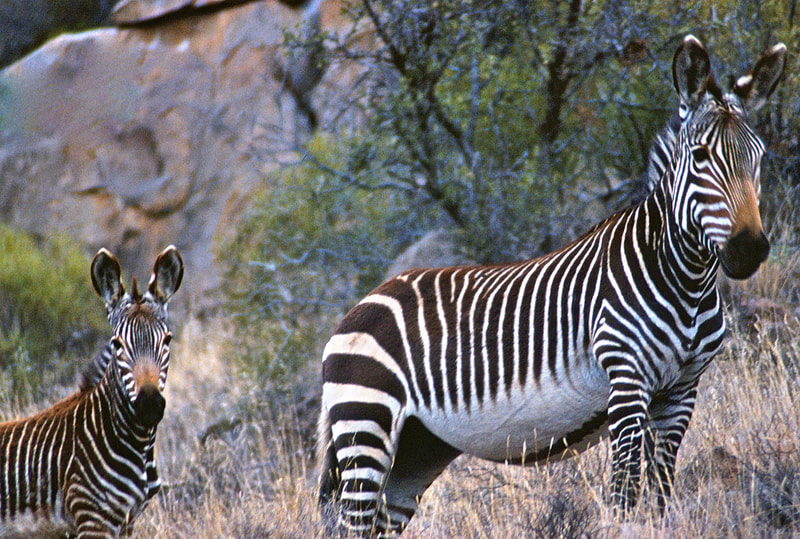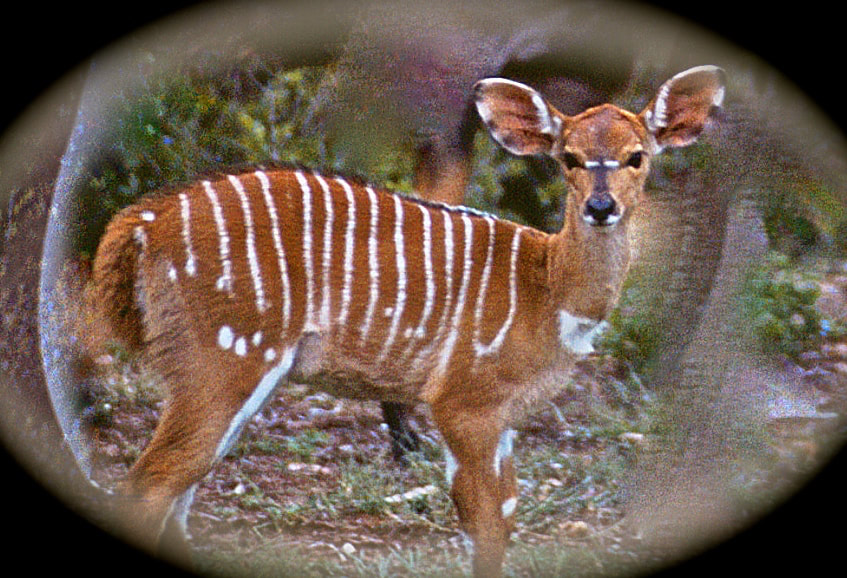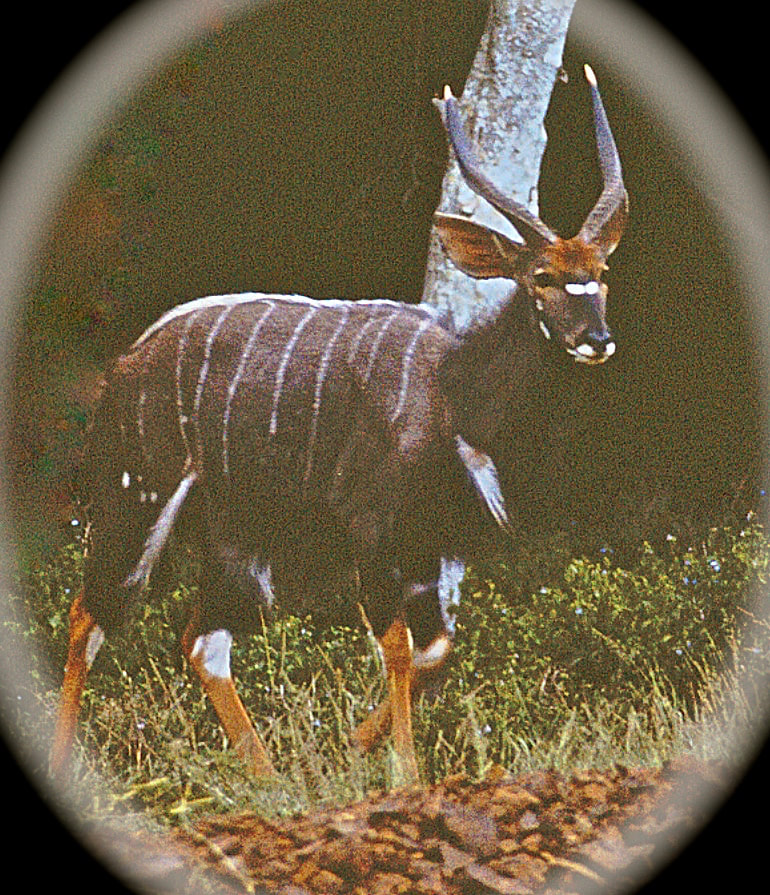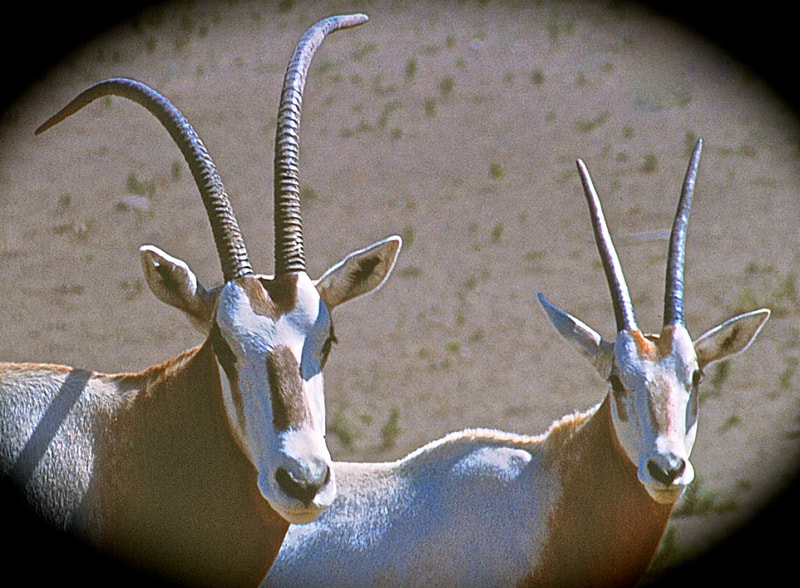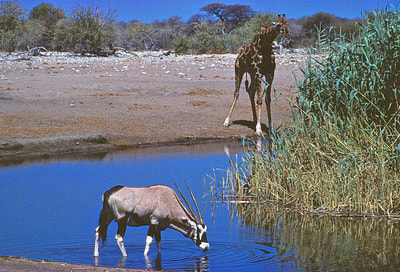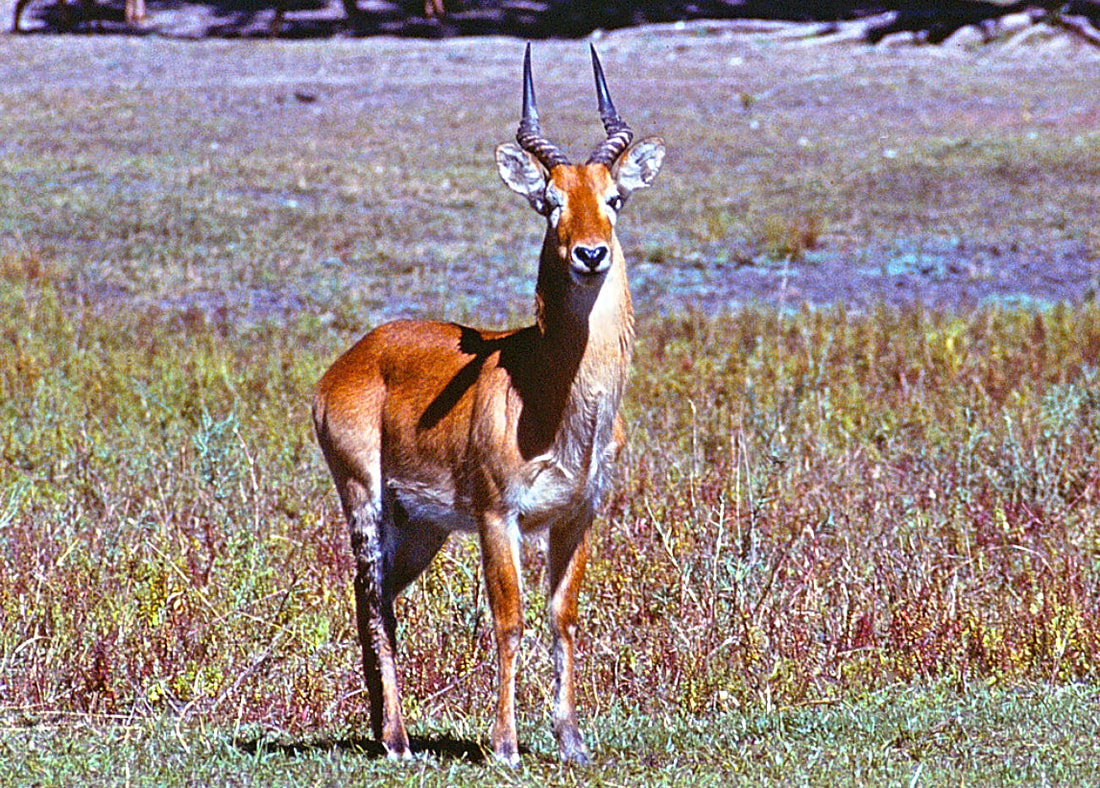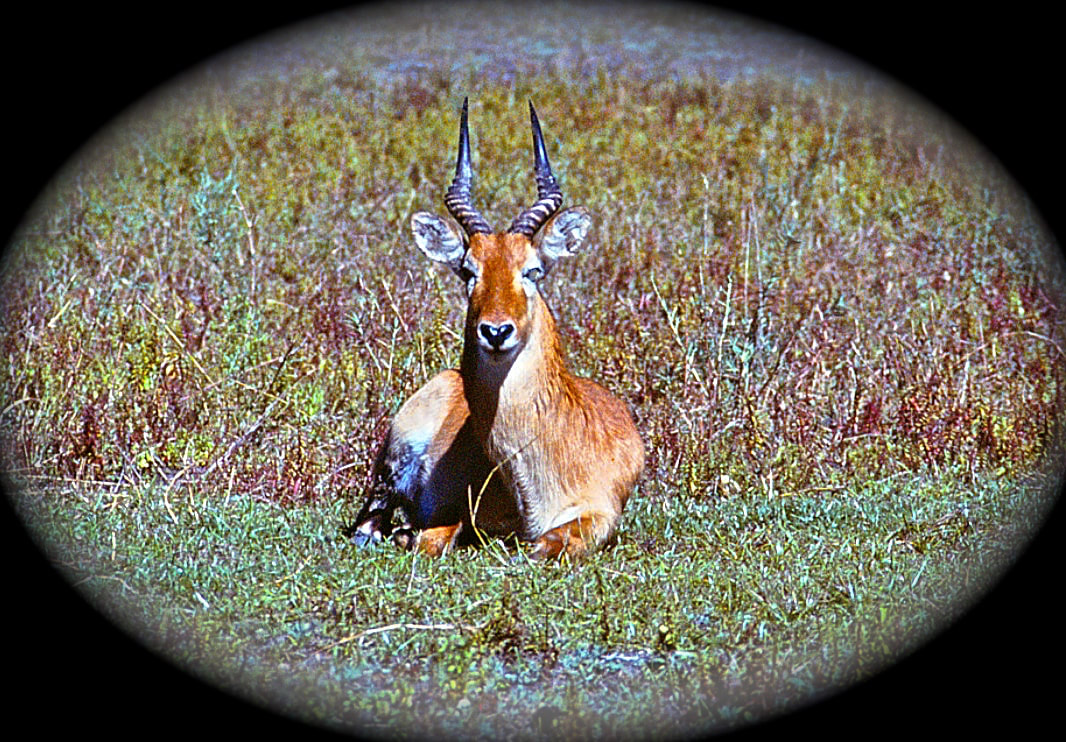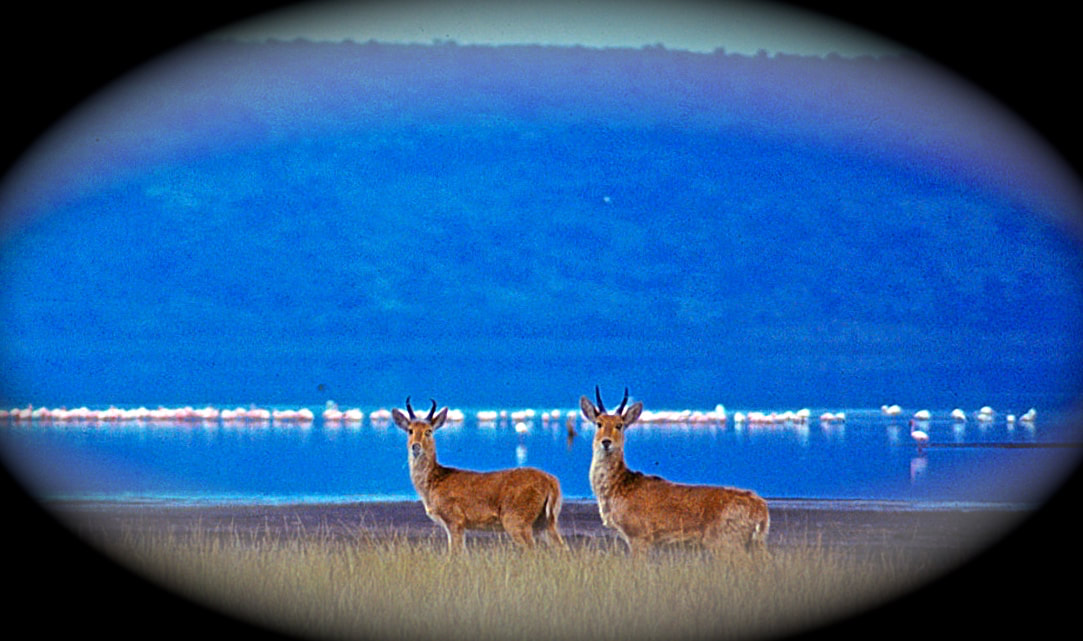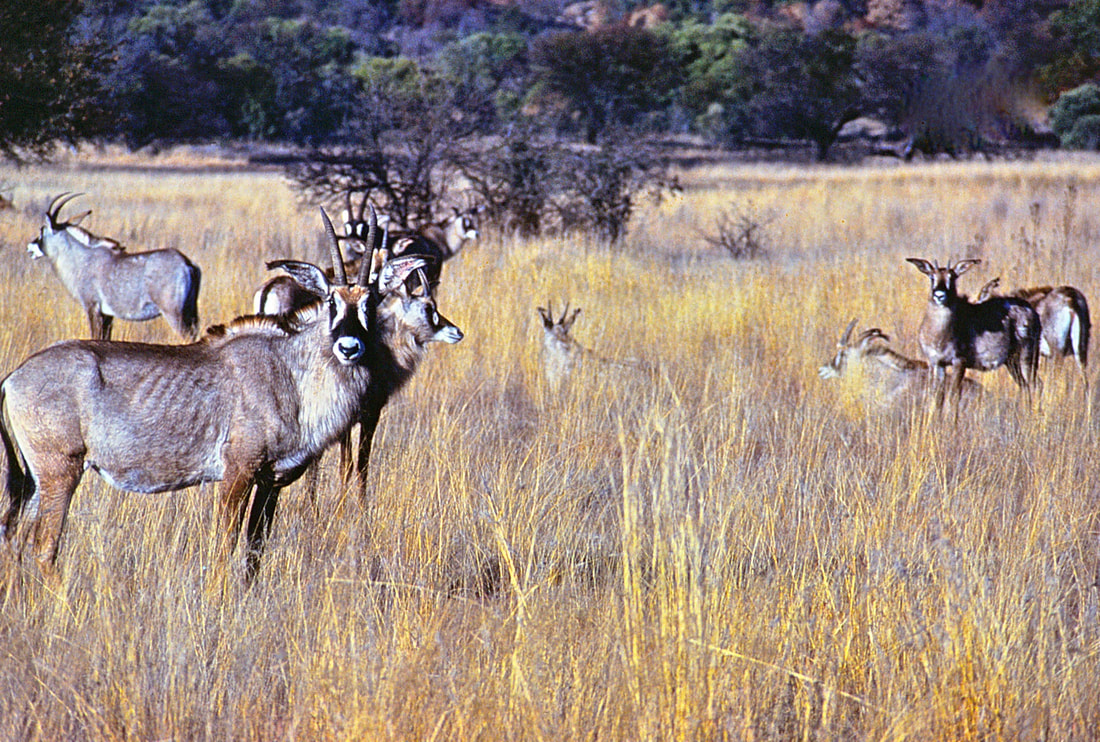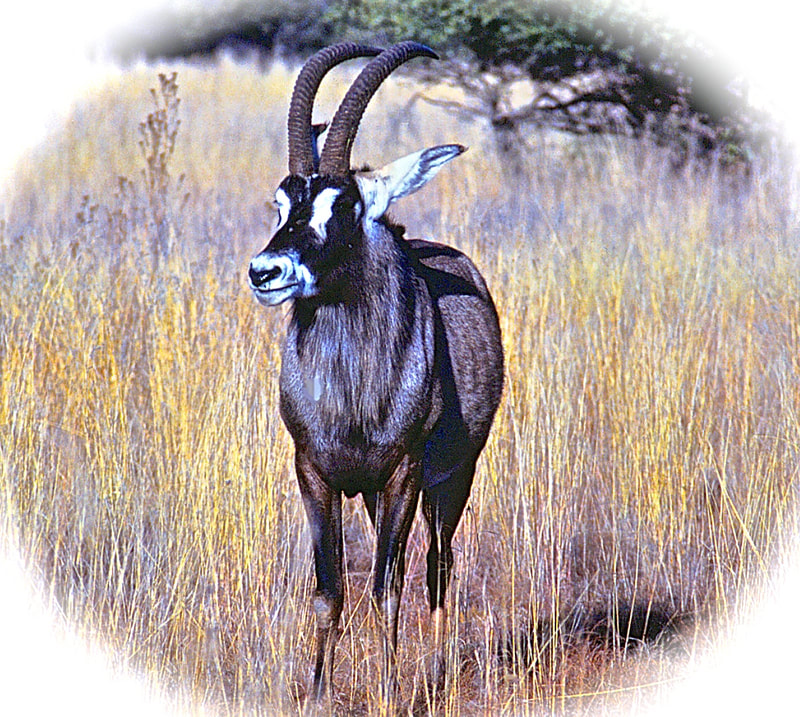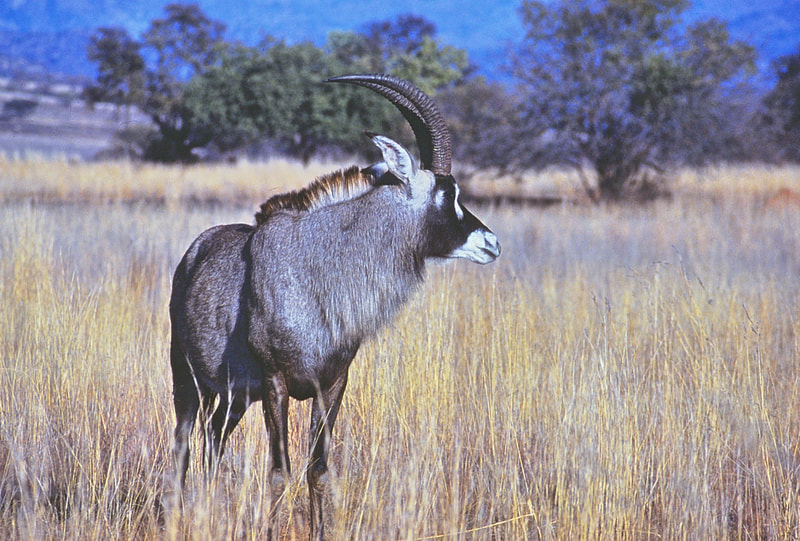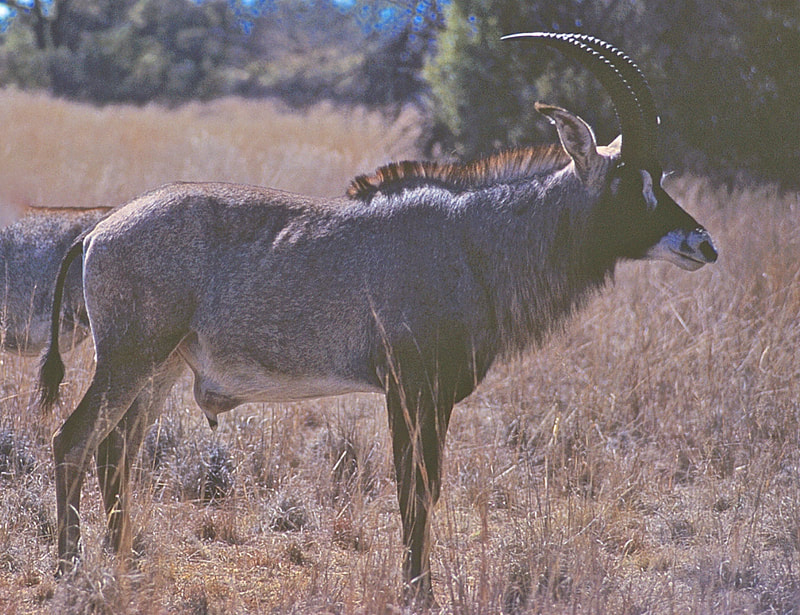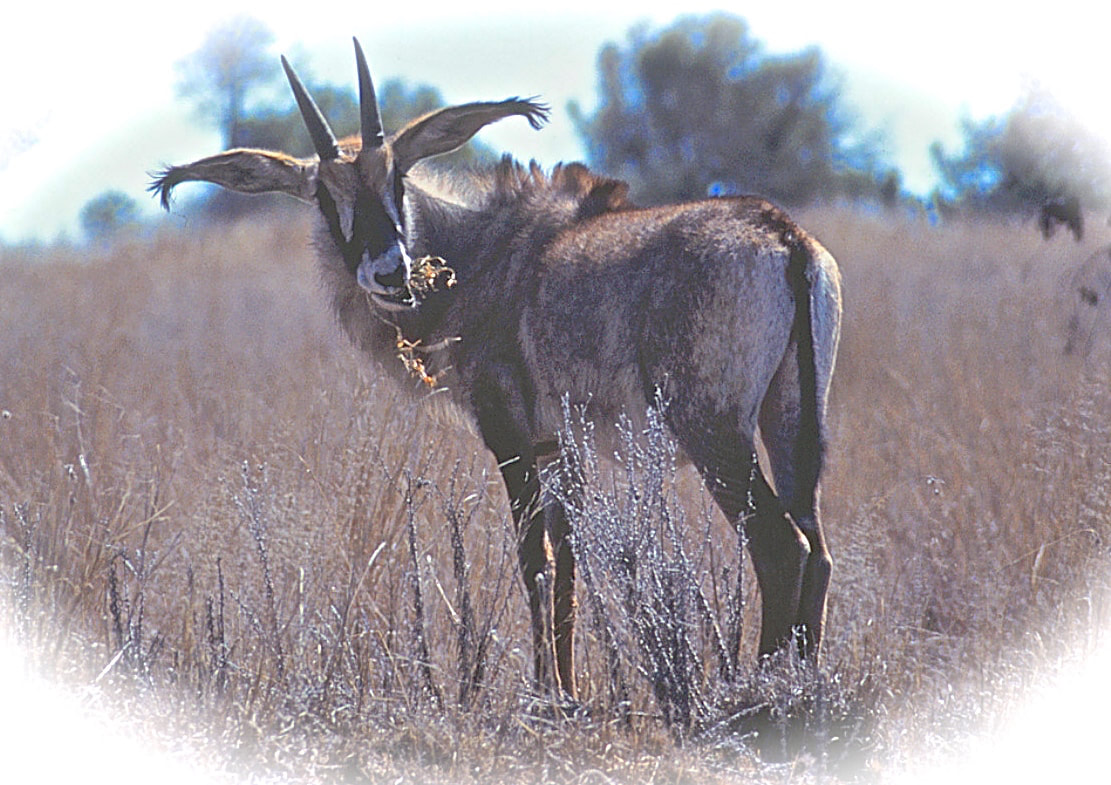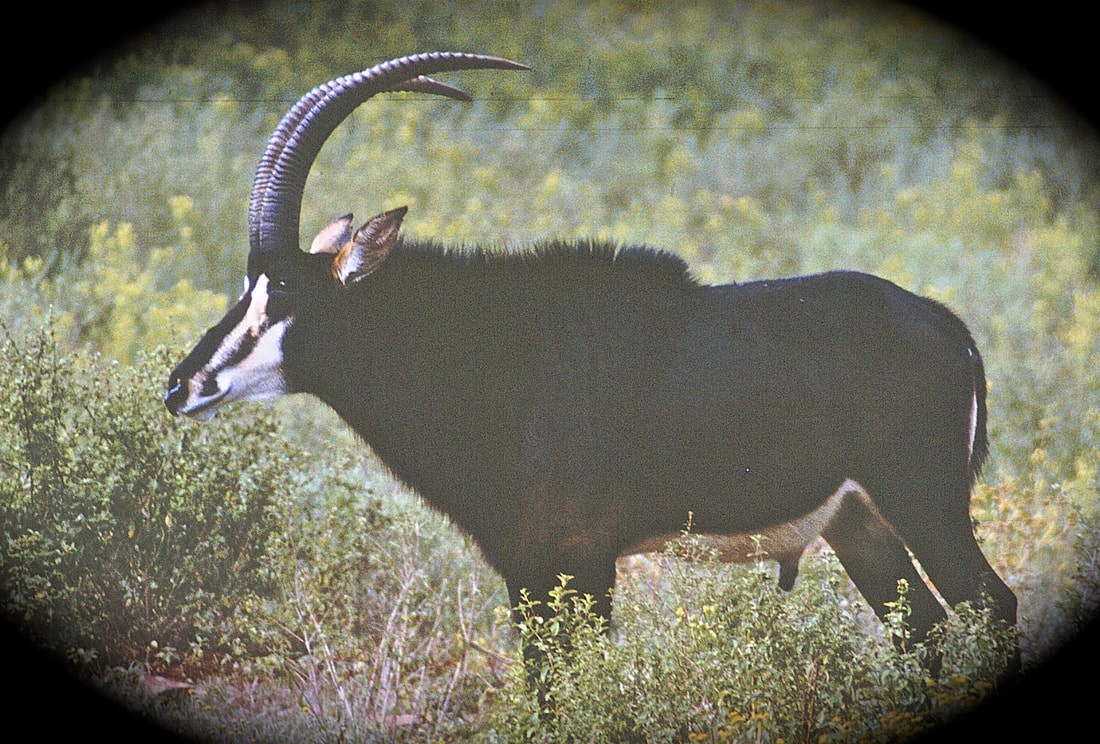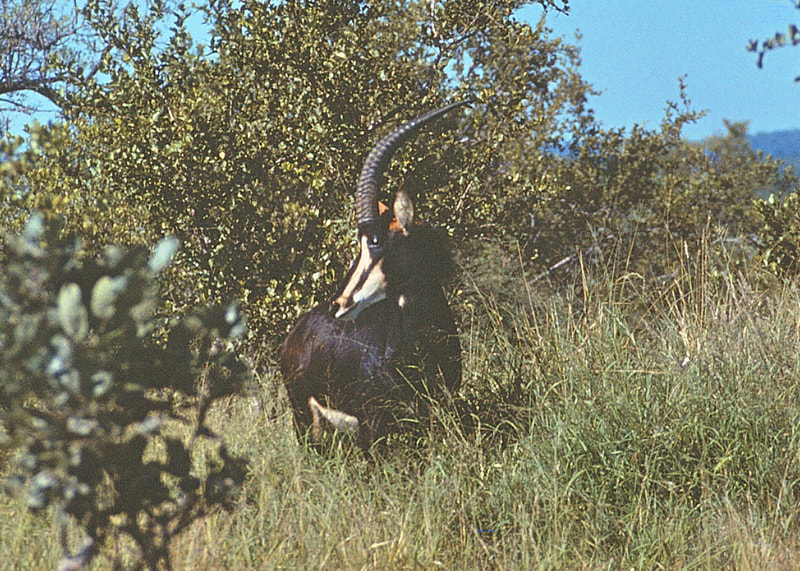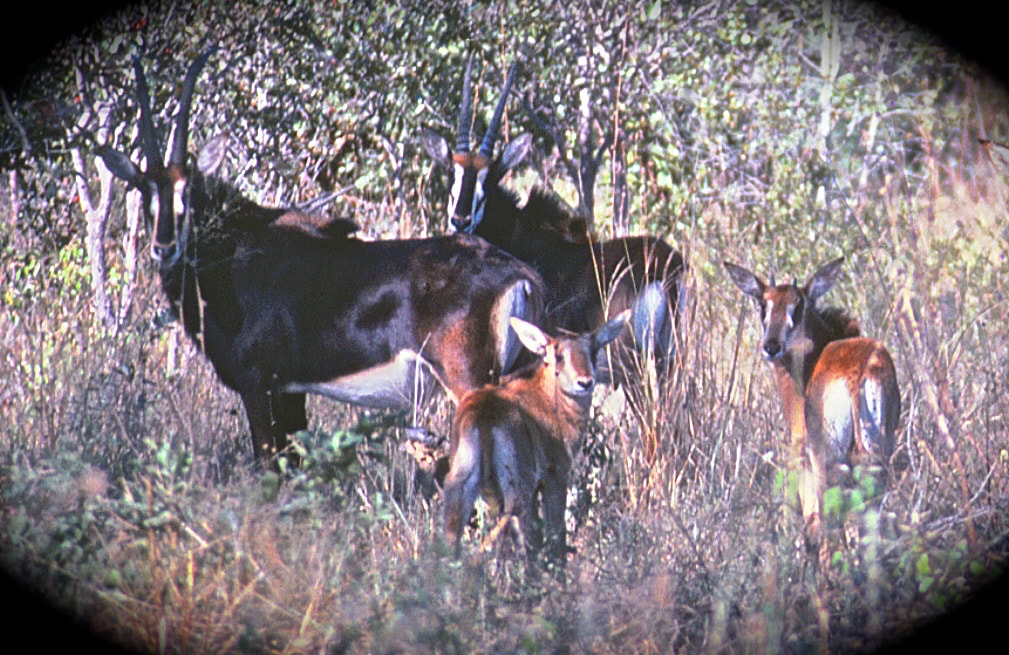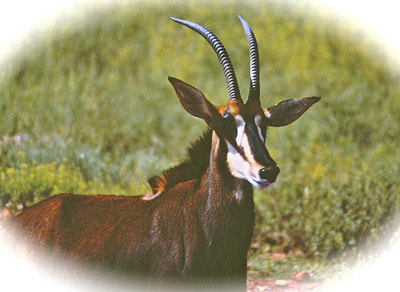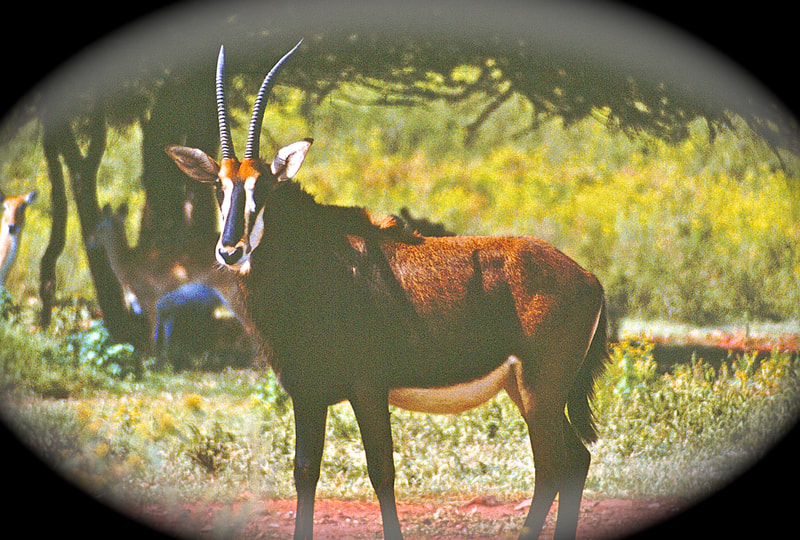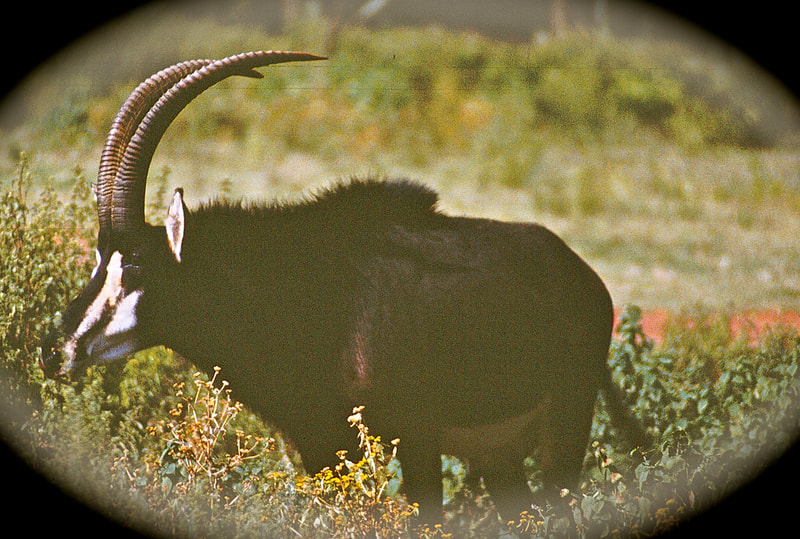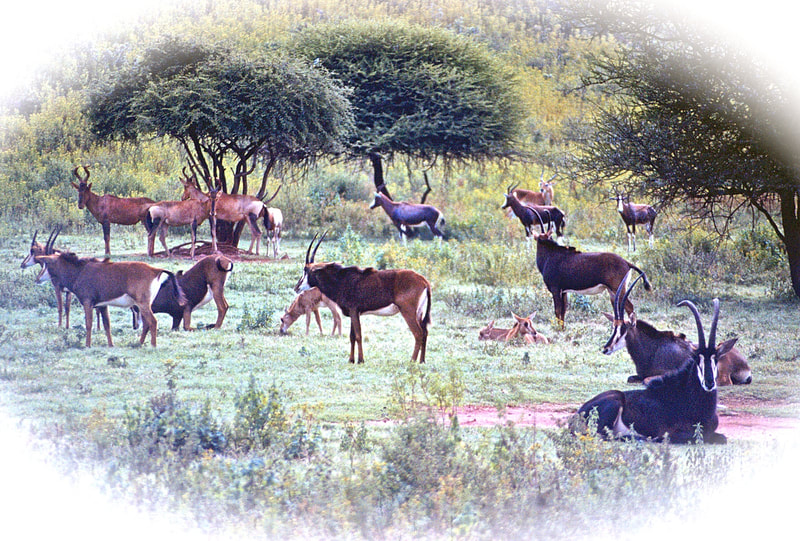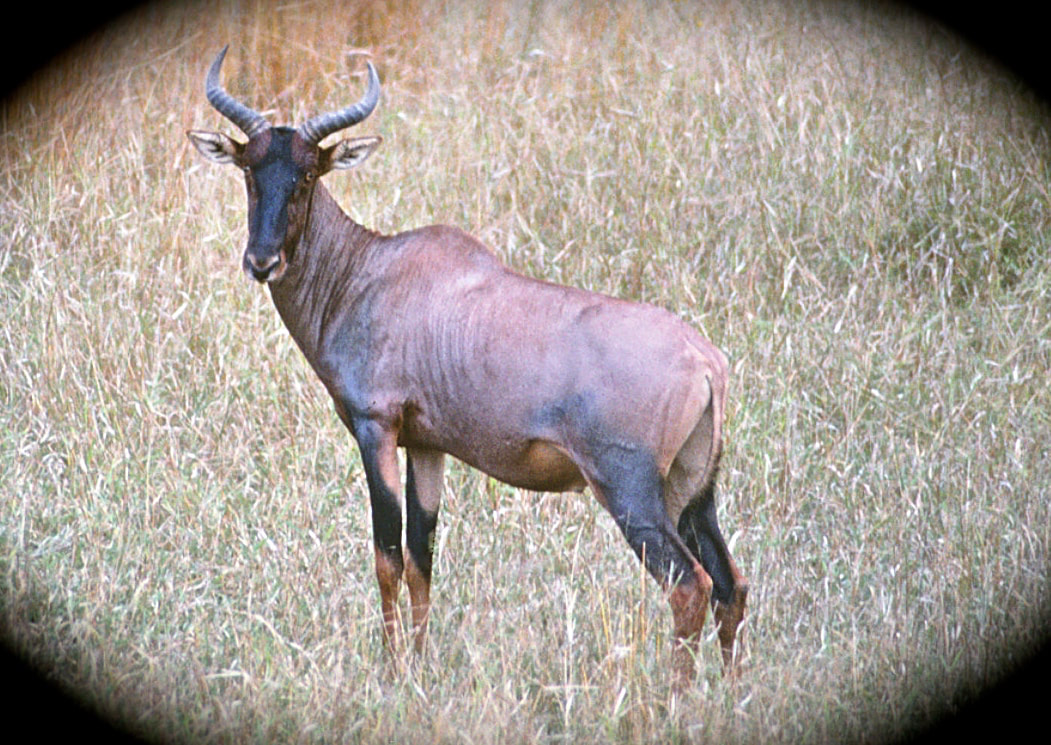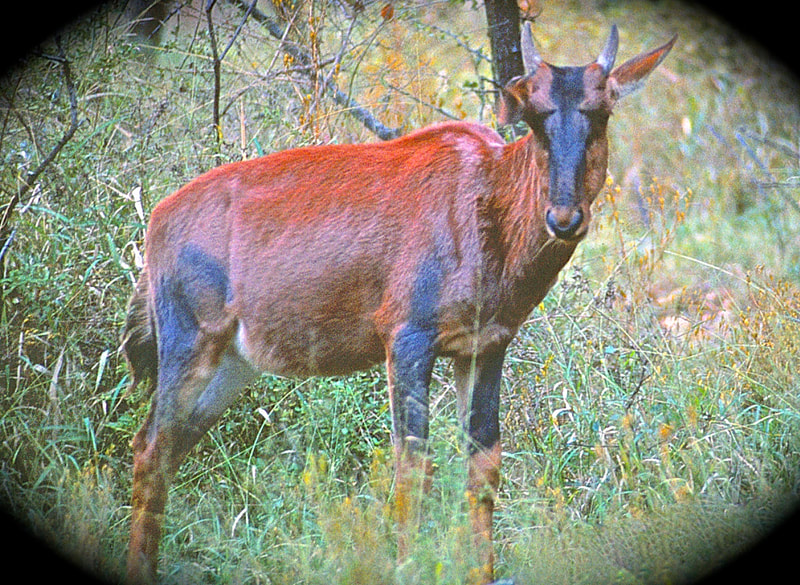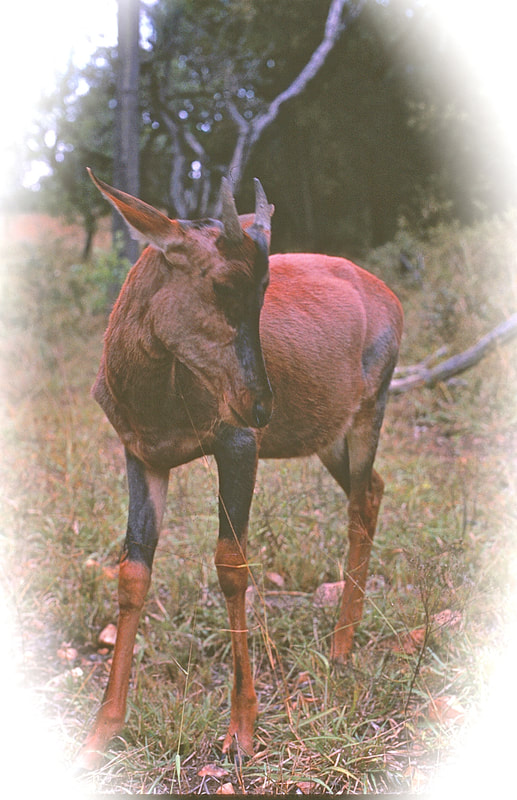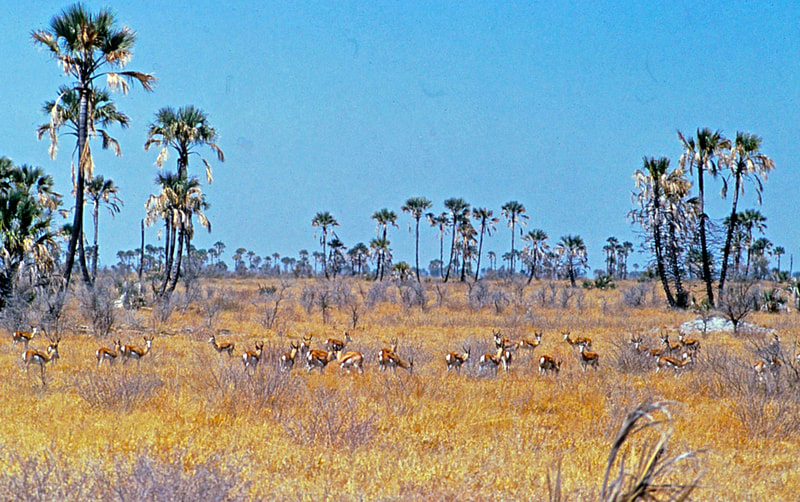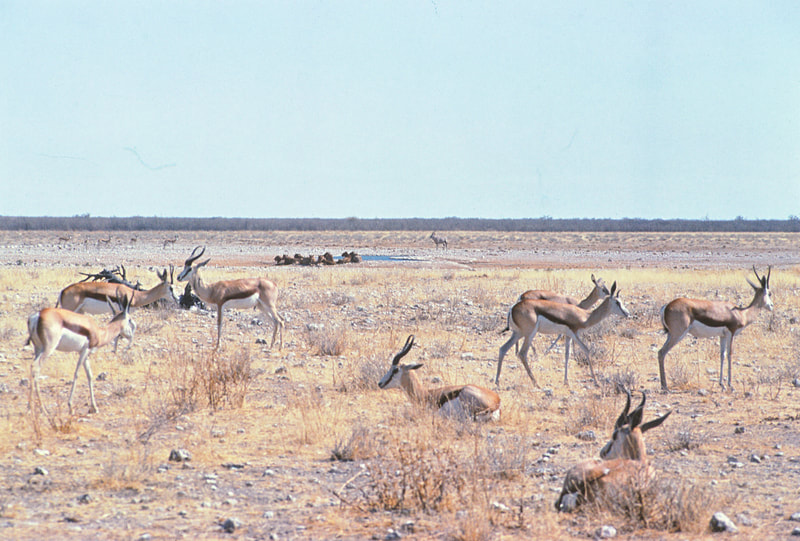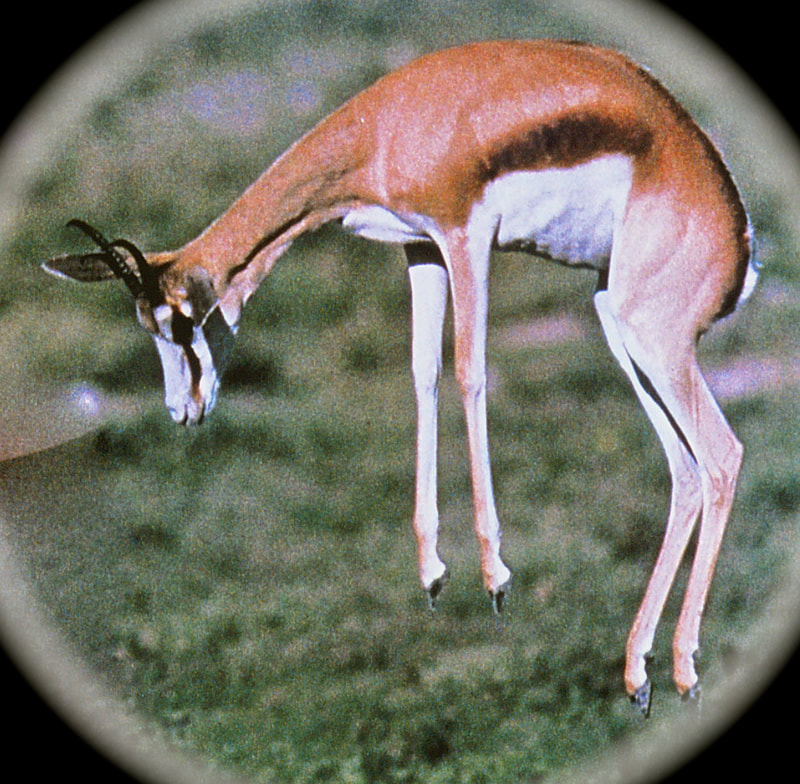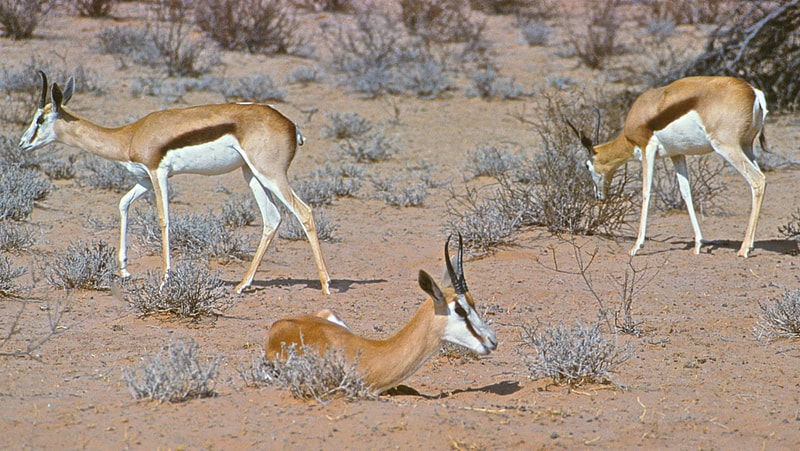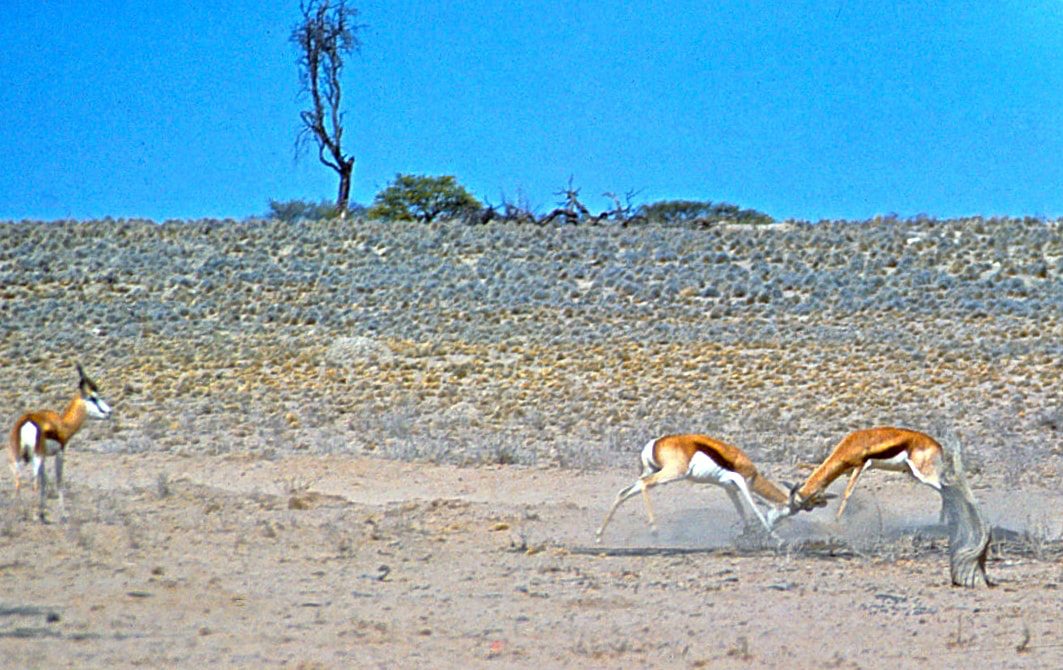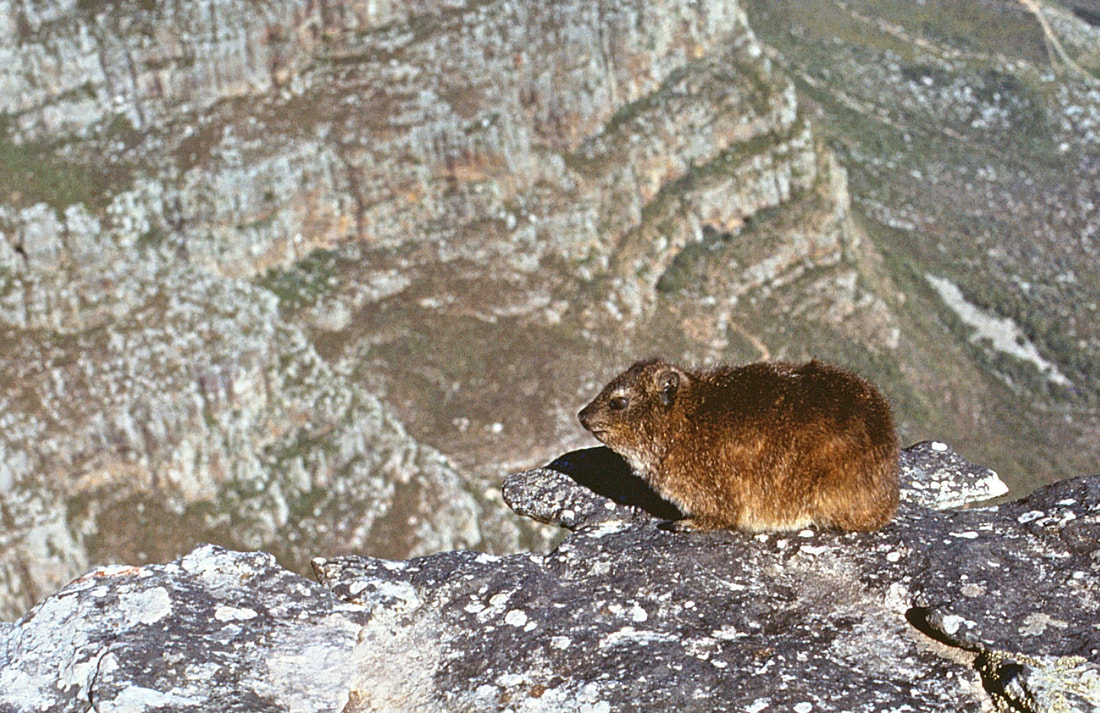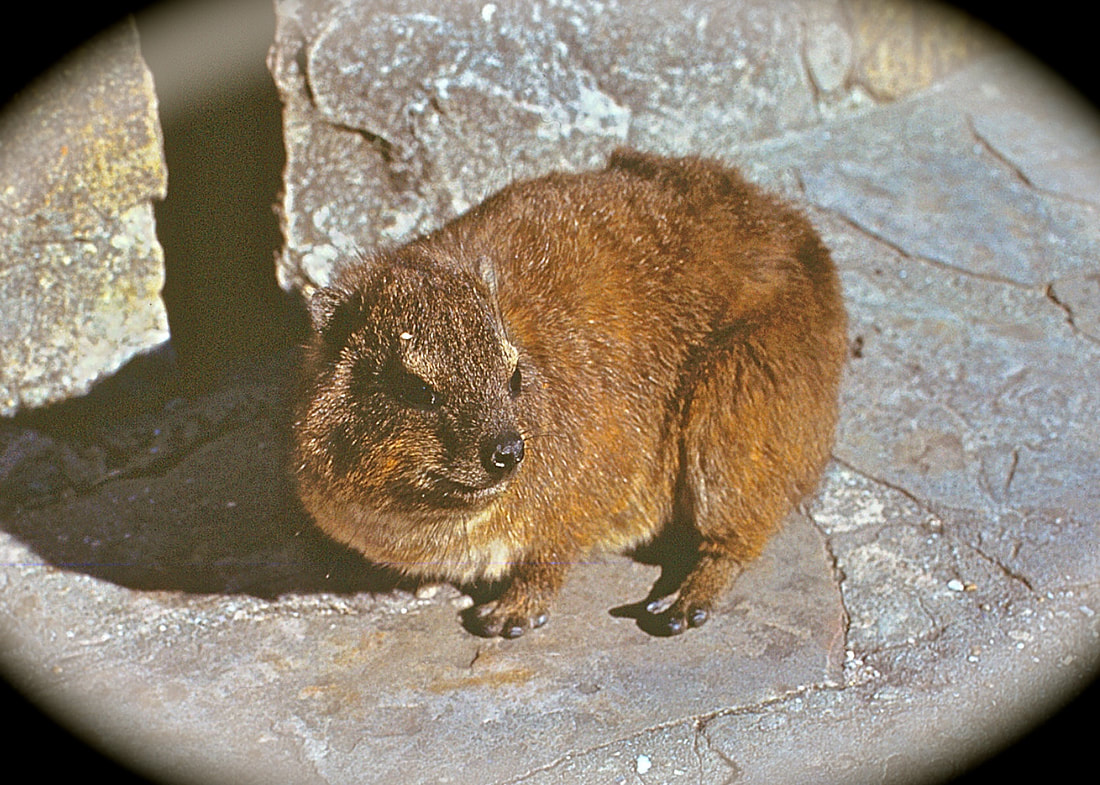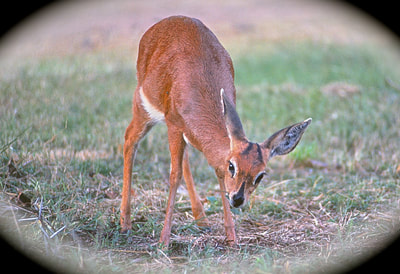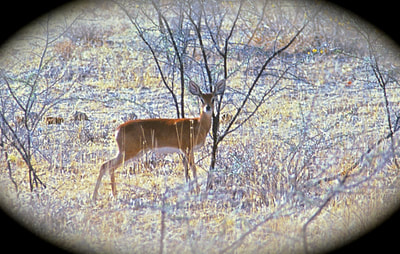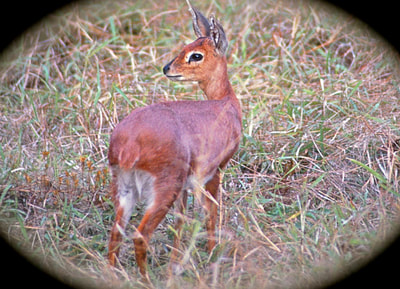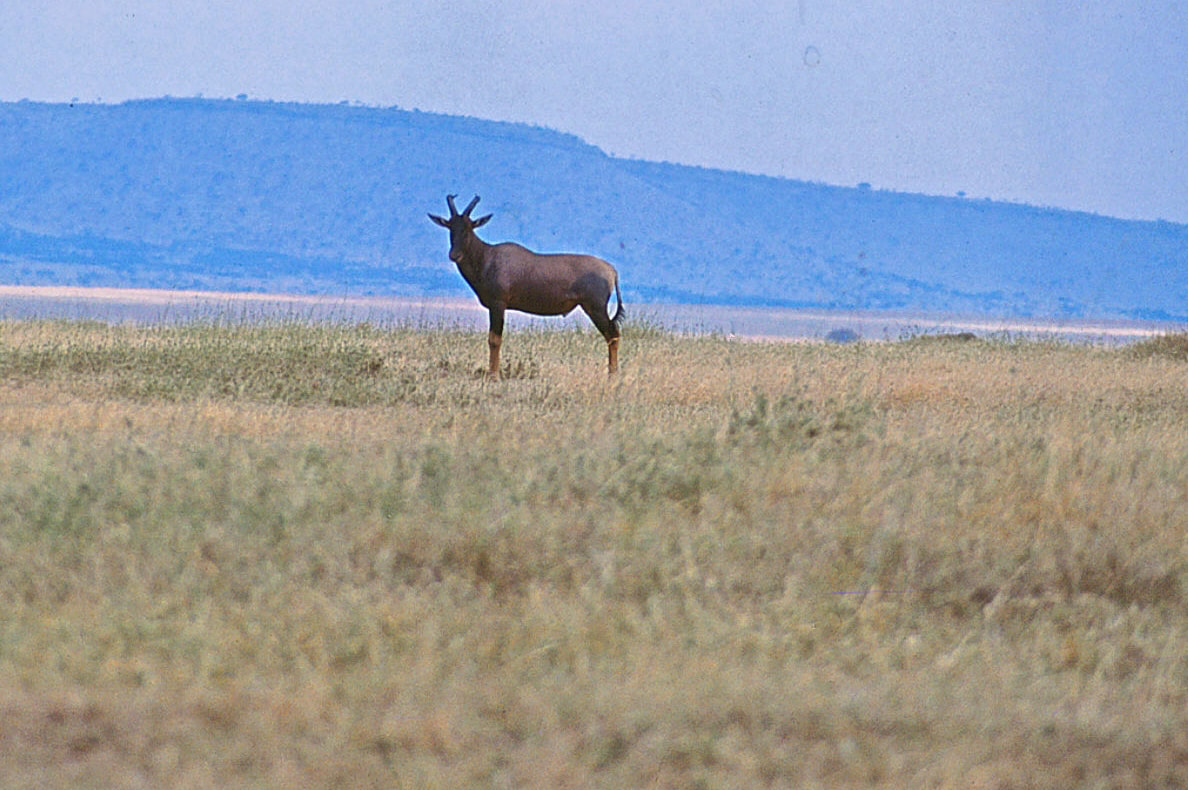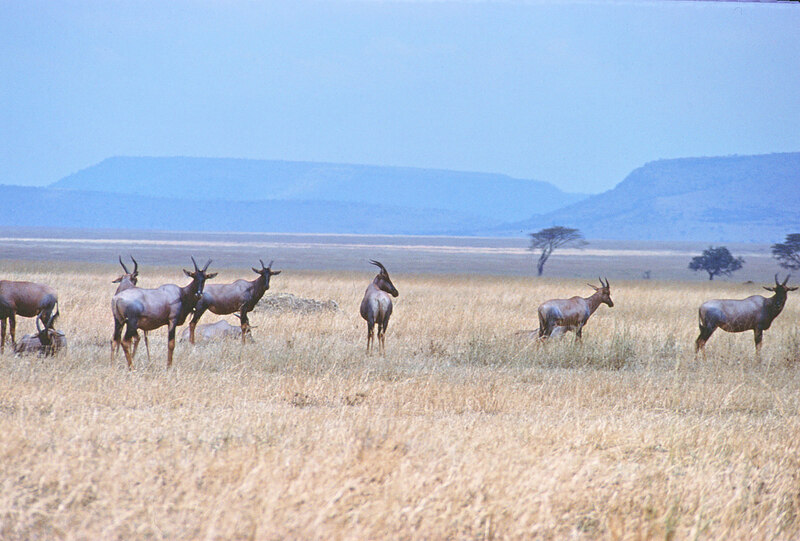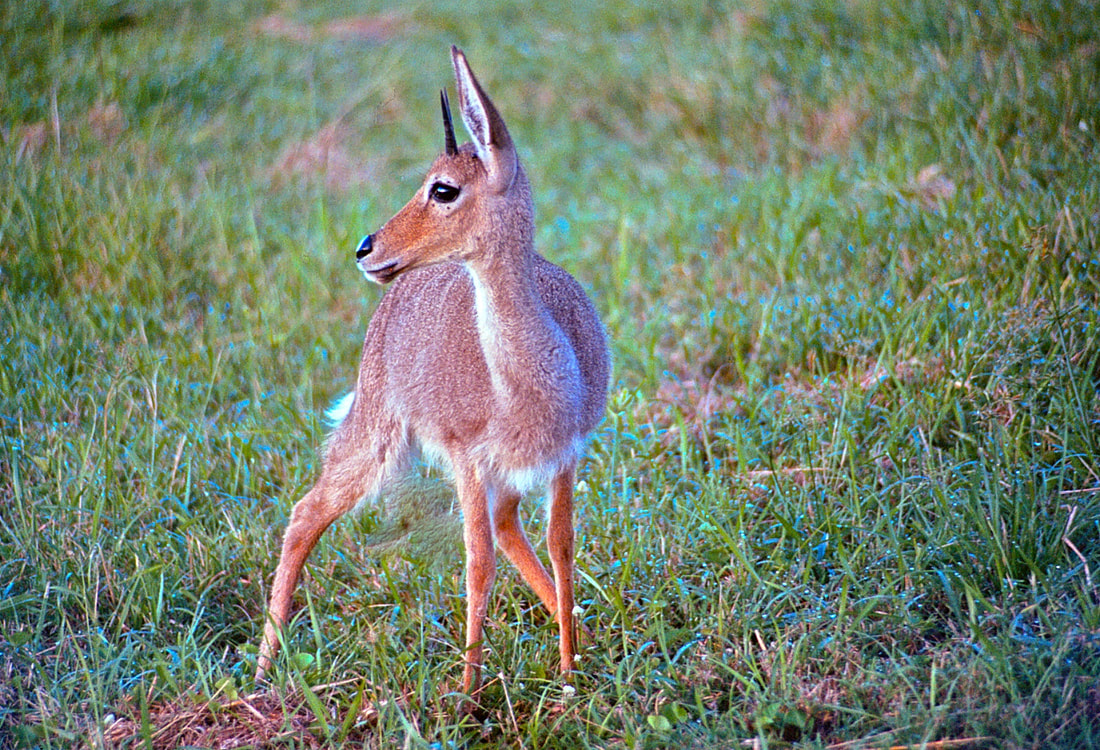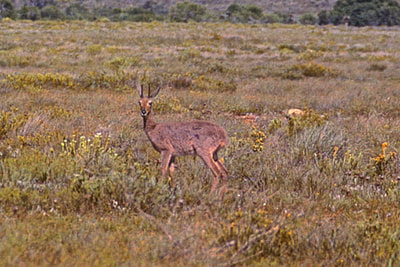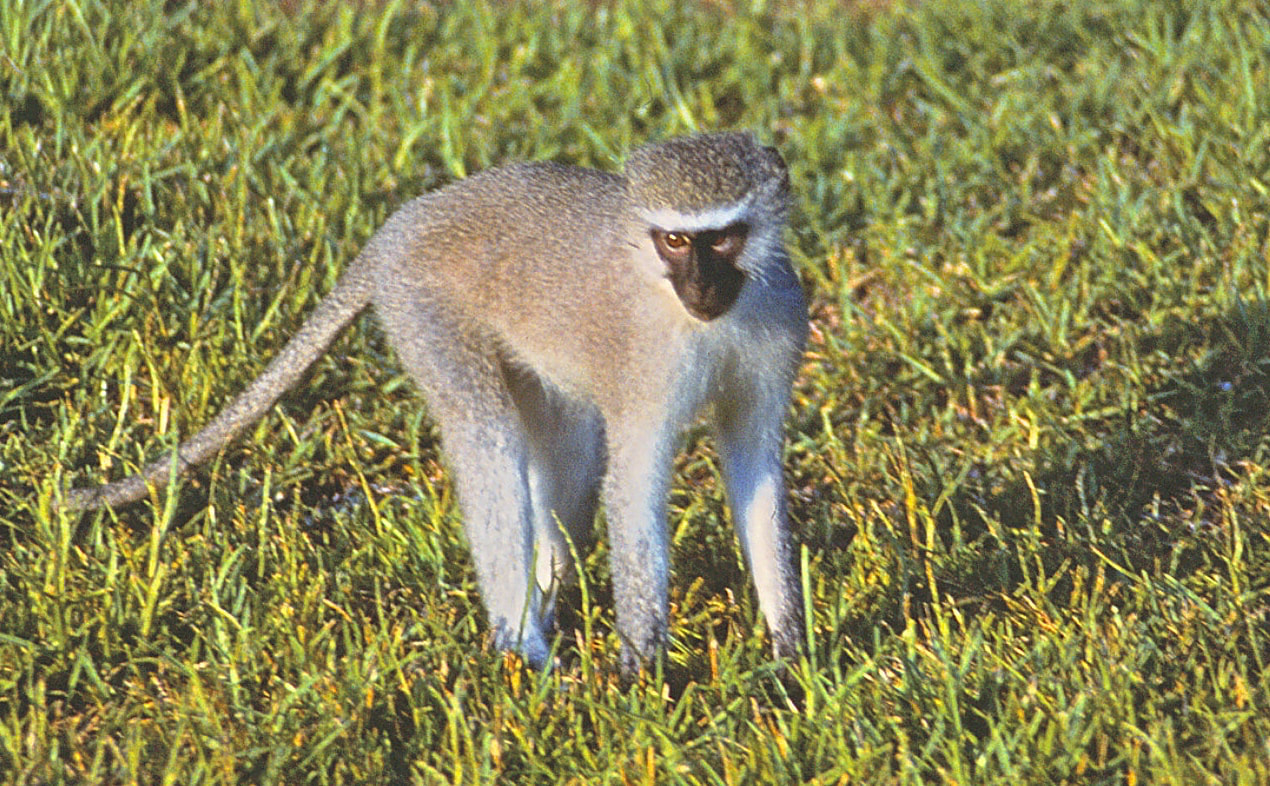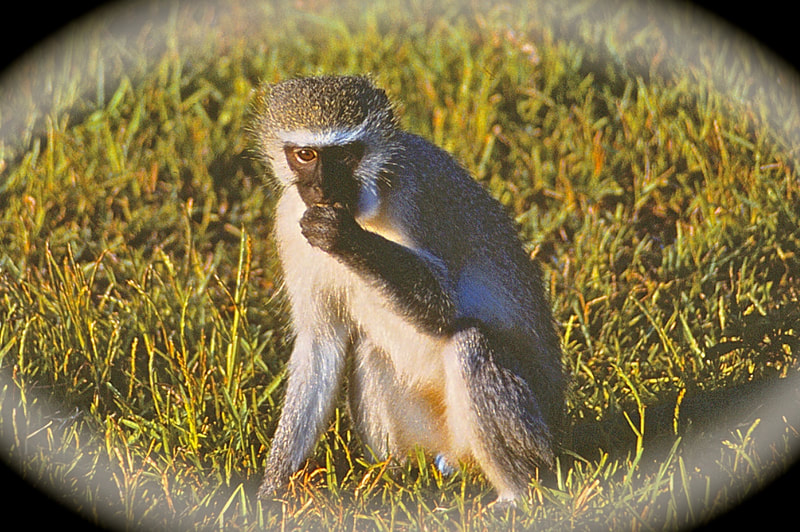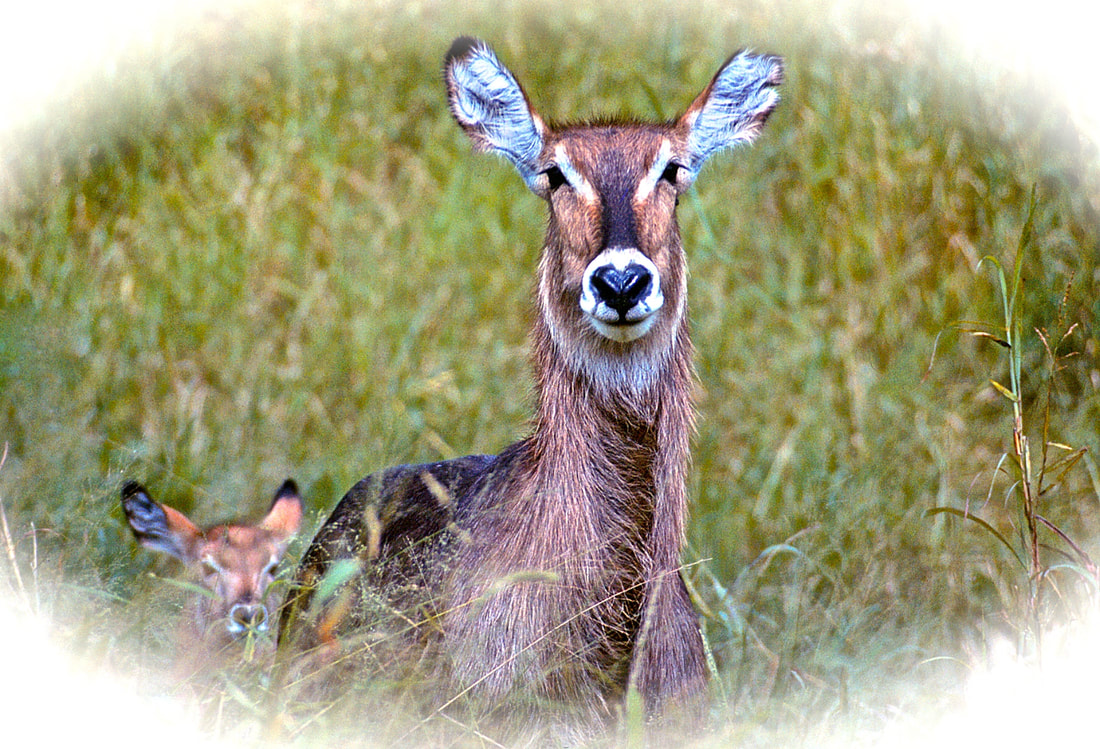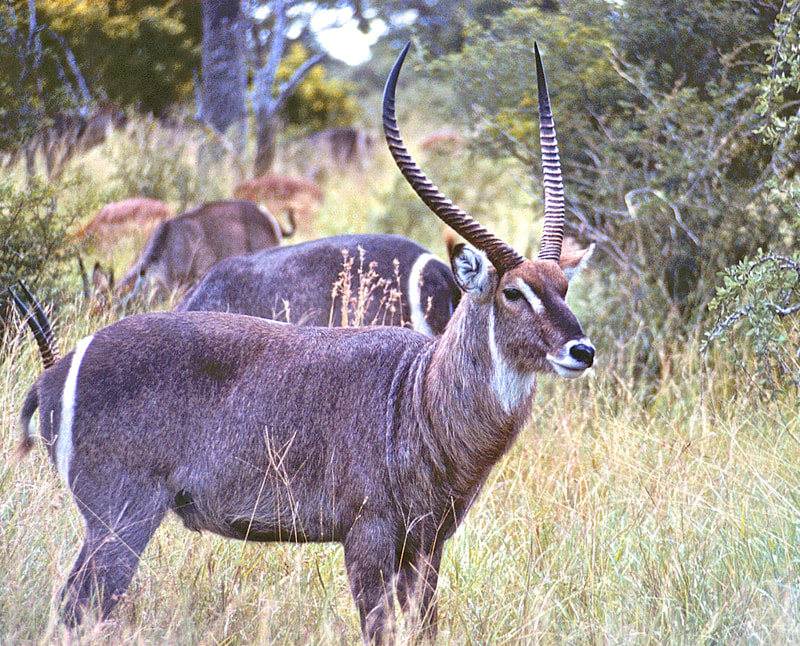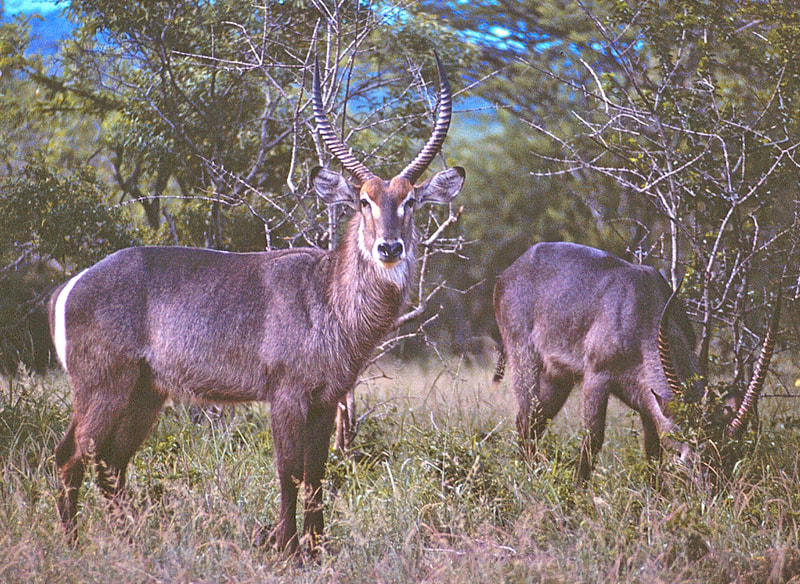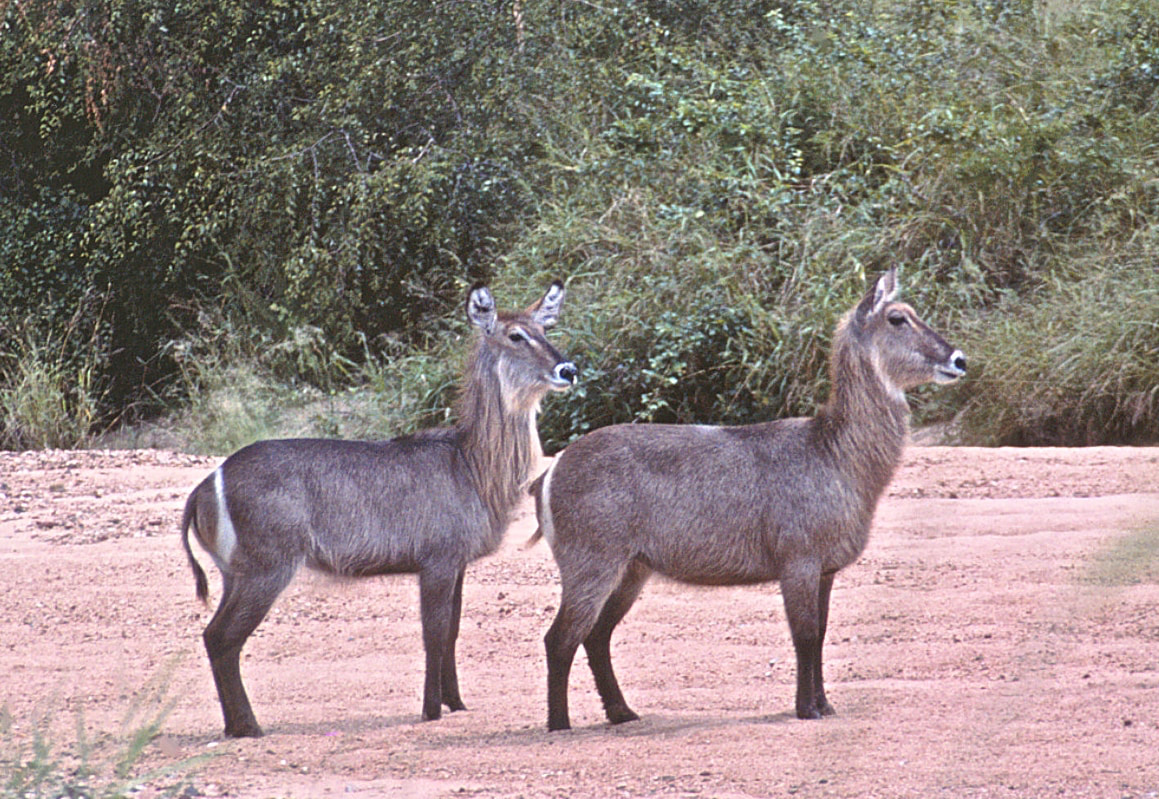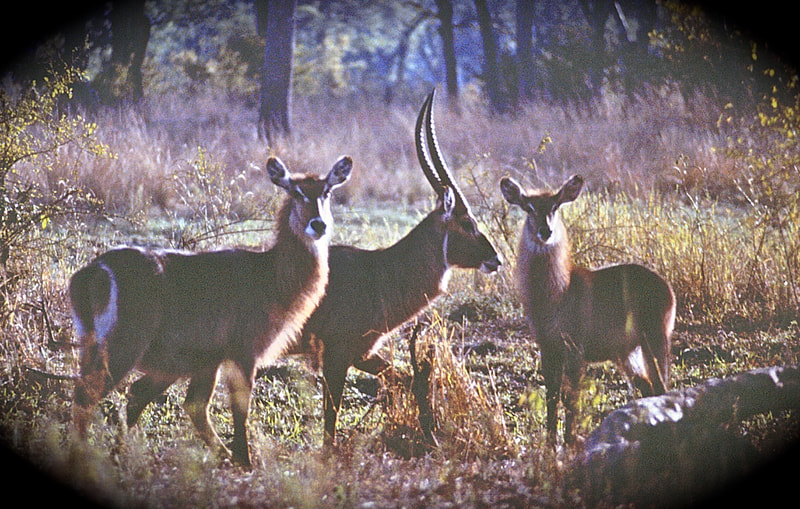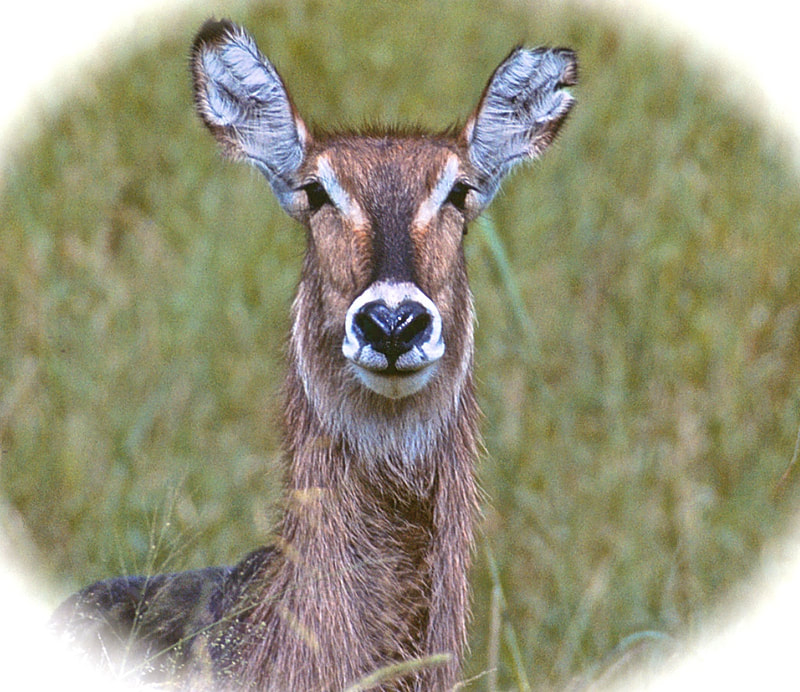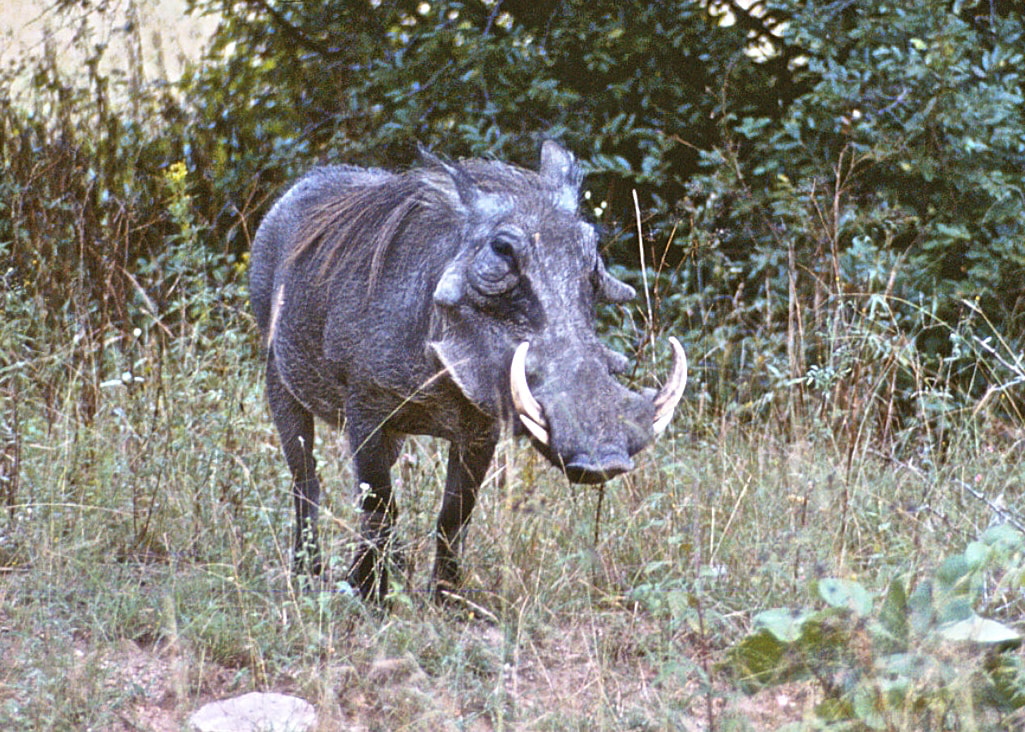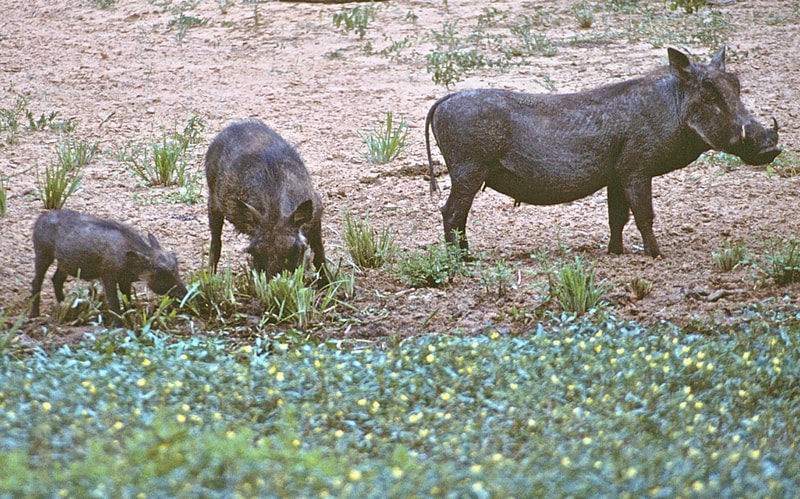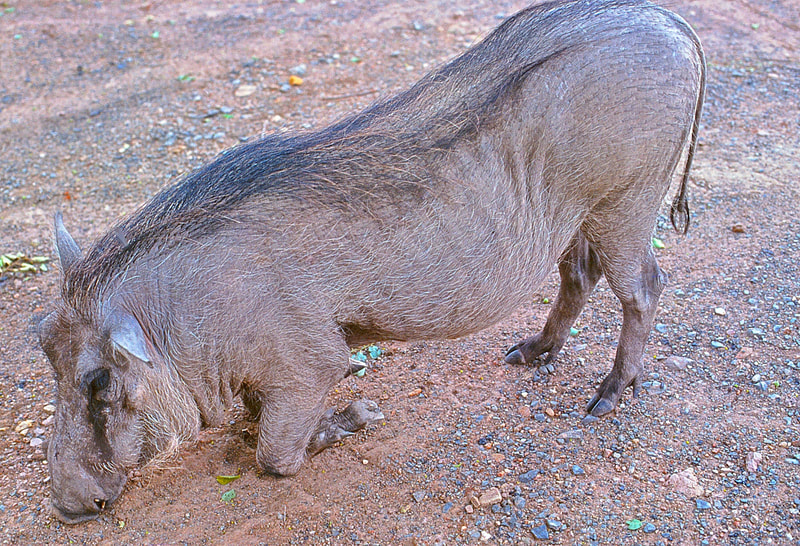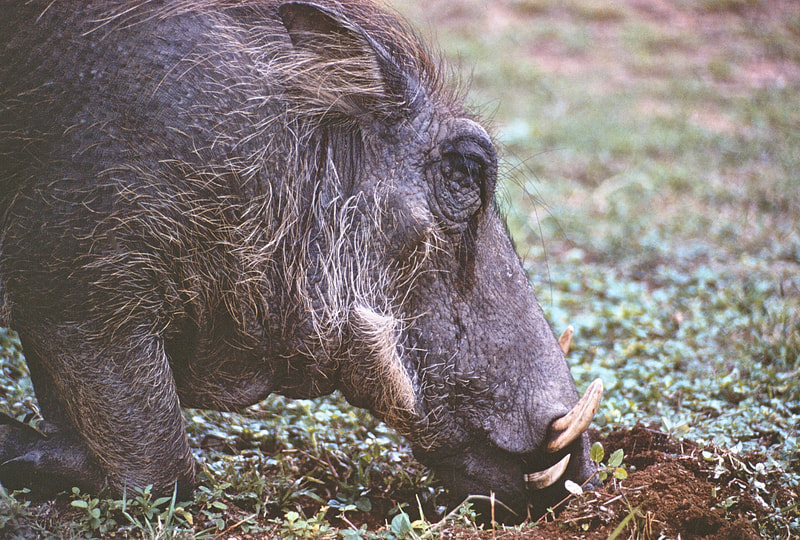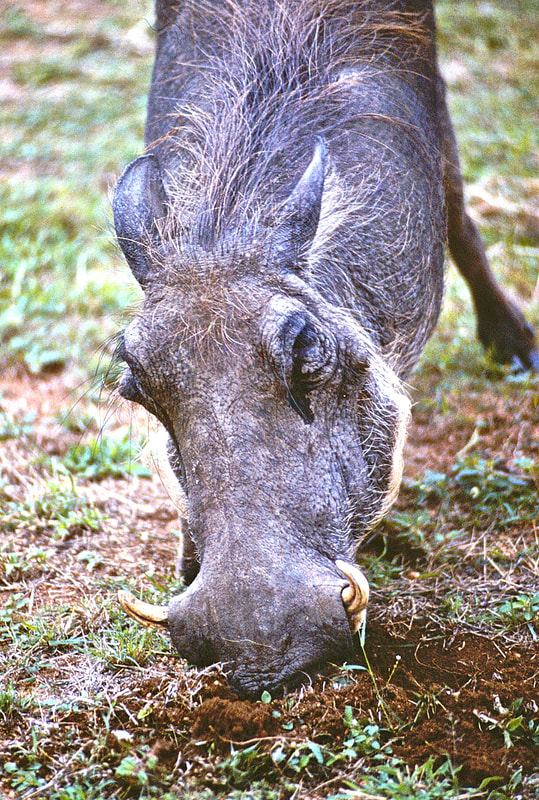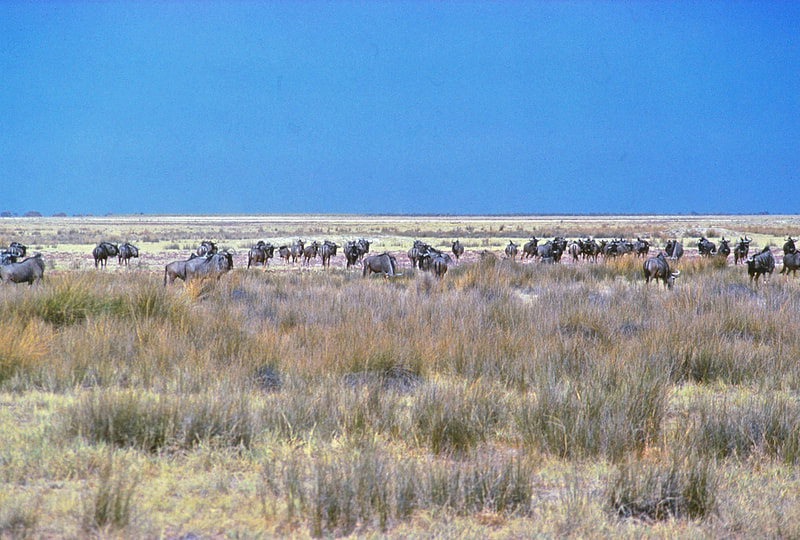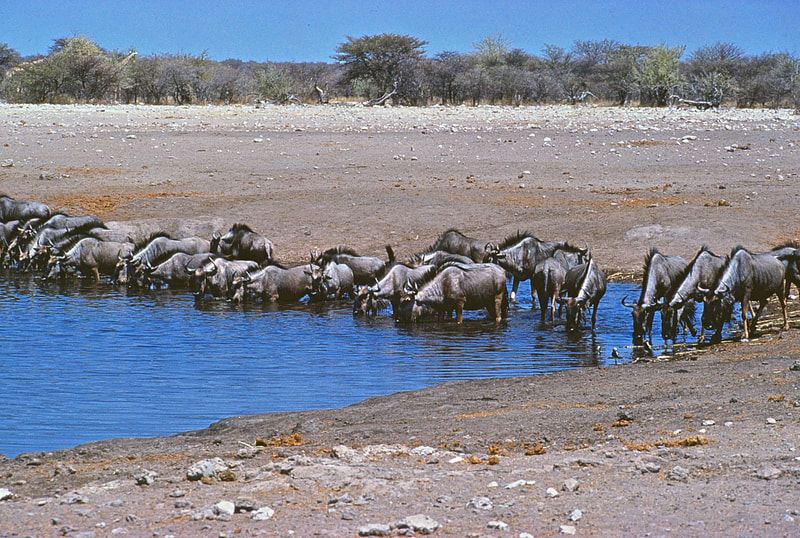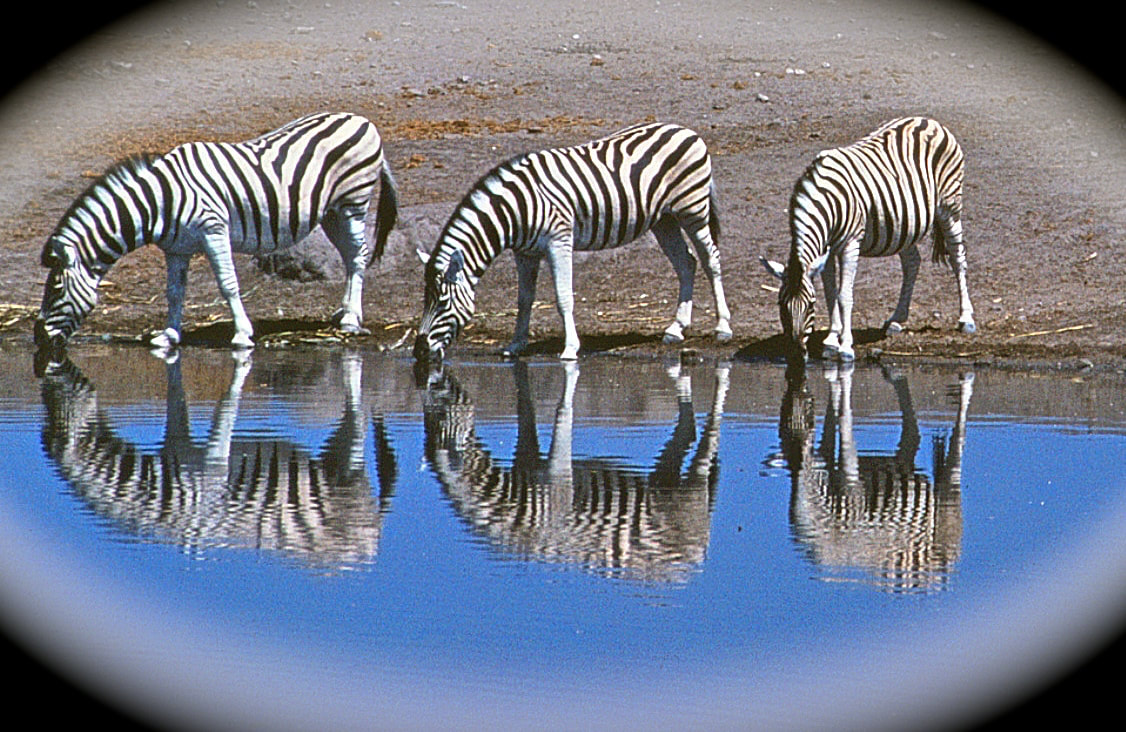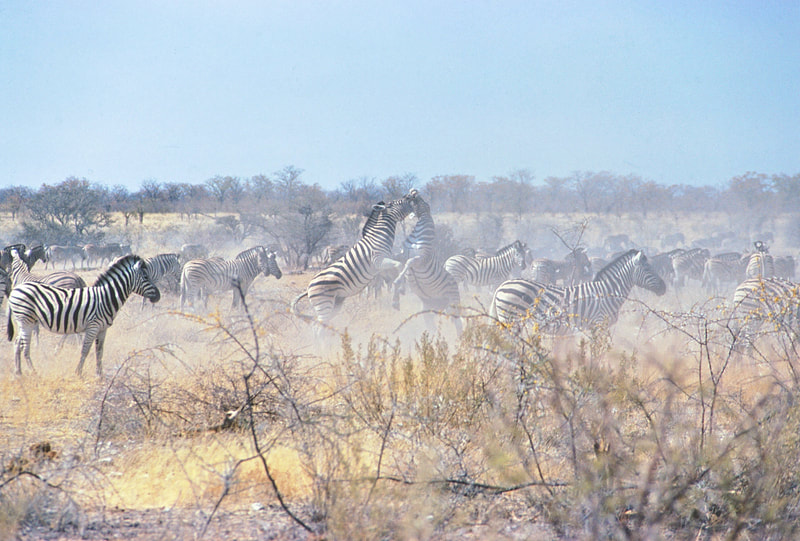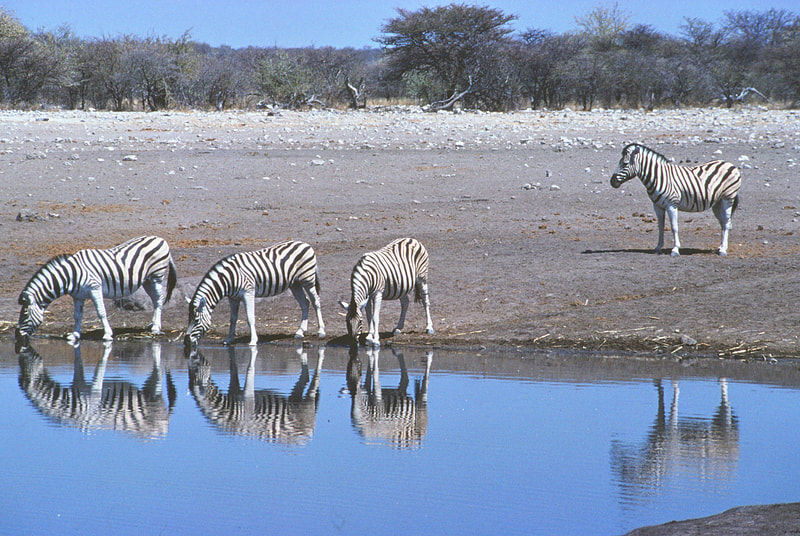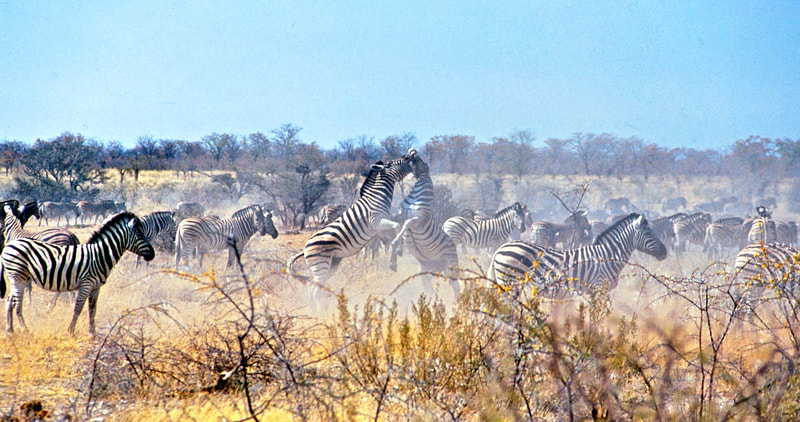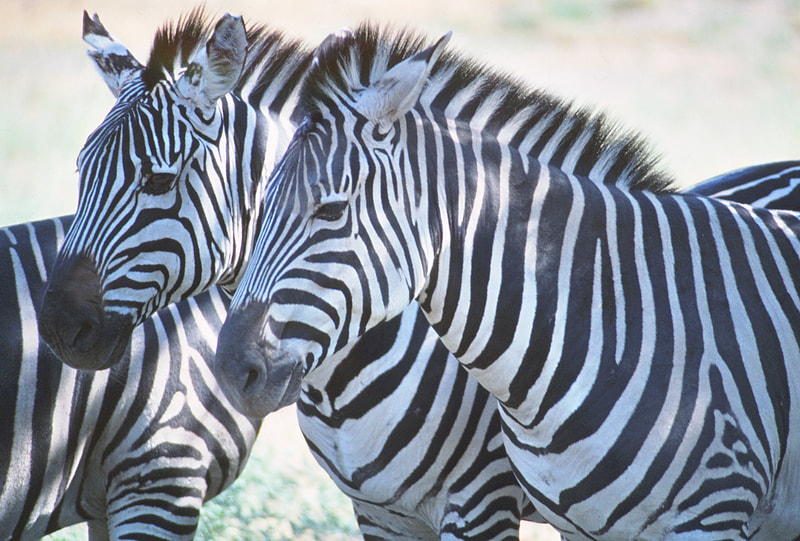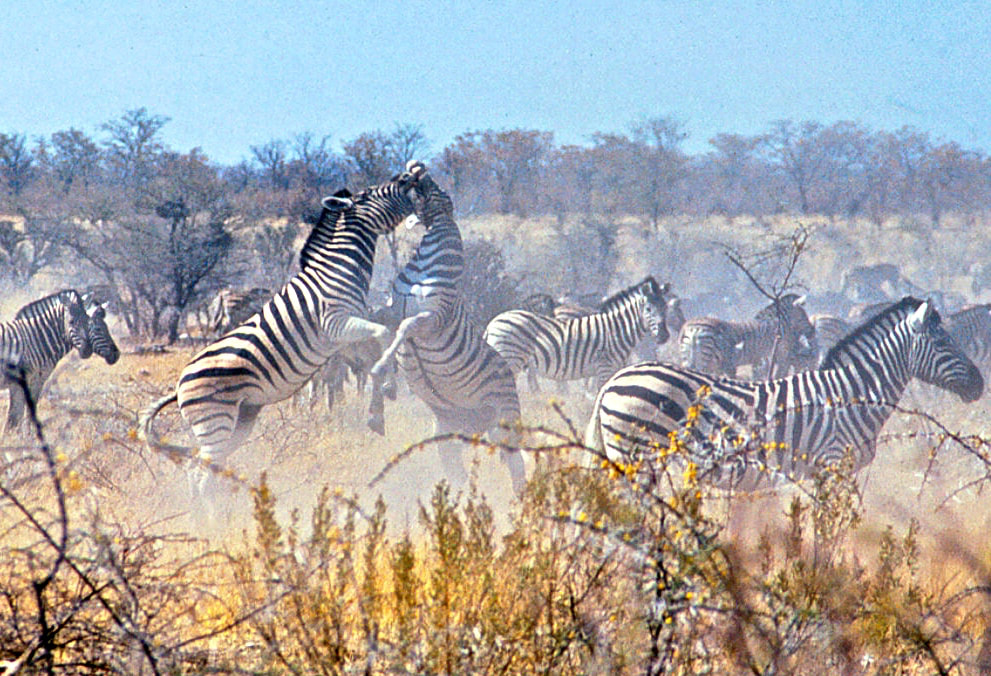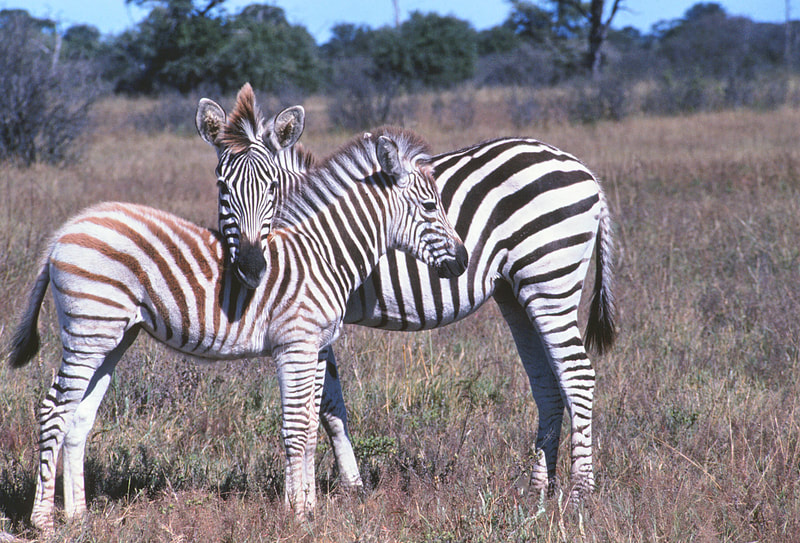If you are not an animal lover, spending time in Africa will soon change your mind. In so many ways they are superior to us; getting to know them, you soon realize they have their ways as we do but more often than not, they are predictable unlike ourselves. There are over 100 animal/birds in "Wildlife Encounters 1/2" that we have photographed in our travels and more pix are being added (with commentary) as I scan our 35MM library.
WILDLIFE ENCOUNTERS PART ONE
Place your mouse inside the right side of the below picture and use the arrows provided to move through the slideshow at your own pace; best to ignore the "Play" arrow on the left as the pictures will move through automatically every 3 seconds allowing insufficient time to read the commentary.
NOTE: Sometimes the "Play or L/R" arrows blocked some of the text; try moving the mouse off the picture for a moment till they go away and then resume using them again to continue the show.
WILDLIFE ENCOUNTERS PART ONE
Place your mouse inside the right side of the below picture and use the arrows provided to move through the slideshow at your own pace; best to ignore the "Play" arrow on the left as the pictures will move through automatically every 3 seconds allowing insufficient time to read the commentary.
NOTE: Sometimes the "Play or L/R" arrows blocked some of the text; try moving the mouse off the picture for a moment till they go away and then resume using them again to continue the show.
WILDLIFE ENCOUNTERS PART TWO
PART TWO USES A DIFFERENT FORMAT TO PART (1); I WILL INTRODUCE EACH NEW ANIMAL WITH A FULL PAGE PICTURE & INFO AND THEN FOLLOW THAT WITH A GALLERY OF SMALLER SUPPORTING PICTURES.
CLICK ON THE FIRST LEFT PIX TO OPEN ANY GALLERY AND MOVE THROUGH THEM USING THE MOUSE (EASIER TO USE THE KEYBOARD ARROWS); WHEN A GALLERY STARTS TO RECYCLE ITSELF, CLOSE DOWN THAT PICTURE TO CONTINUE.
PART TWO USES A DIFFERENT FORMAT TO PART (1); I WILL INTRODUCE EACH NEW ANIMAL WITH A FULL PAGE PICTURE & INFO AND THEN FOLLOW THAT WITH A GALLERY OF SMALLER SUPPORTING PICTURES.
CLICK ON THE FIRST LEFT PIX TO OPEN ANY GALLERY AND MOVE THROUGH THEM USING THE MOUSE (EASIER TO USE THE KEYBOARD ARROWS); WHEN A GALLERY STARTS TO RECYCLE ITSELF, CLOSE DOWN THAT PICTURE TO CONTINUE.
THERE IS A SPECIAL FEATURE ON ELEPHANT, LION, RHINO, LEOPARD, HIPPO, BUFFALO, CHEETAH, HYENA AND GIRAFFE IN THE AFRICAN SECTION OF "WINDOW ON THE WORLD PART ONE." .
AFRICAN GALLERY
A baboons is probably the most common animal you going to encounter in Africa, there deep guttural calls are very distinctive, something like a giant clearing his throat. The very first time we heard a baboon calling was while we were hiking in a dense, dark forest in the foothills of South Africa's Drakensberg mountains. The first call was quite nearby, a single loud call that reverberated throughout the forest and also managed to scare the hell out of us. It was repeated over and over and because it was so new to us, we thought it might be a leopard and decided to backtrack and get the heck out of the forest. We have since learned not to fear them but there were times when we encountered a mob of them while on foot; led by a particularly large male that made a mock charged towards us several times, the whole pack seemed to become very excited to the point where we felt we were about to be swarmed and attacked; we stopped, backed up and gave them a wide berth but have felt uneasy around them since that first occasion. An enraged baboon can be a particularly dangerous and vicious animal and you can see by the above picture how awesome their teeth are and in the Gallery, you will see one facing off a cheetah that ran off after a while rather than take him on. To open the GALLERIES, Click on the left pix and move through using the picture or keyboard arrows. JUST A REMINDER THAT ONCE AN OPENED GALLERY BEGINS TO RECYCLE ITSELF, TO CONTINUE, CLOSE DOWN THE CURRENT PICTURE (Top right corner); DON'T CLOSE THE SCREEN WINDOW OR THAT WILL TAKE YOU OUT OF THE WEBSITE.
The Blesbok is endemic to South Africa. It has a distinctive white blaze on its forehead which inspired the name, because bles is the Afrikaans word for blaze such as one might see on a horse. There was a time when the Blesbuck roamed the S.African veldt in the thousands (see below) but once white settlers arrived on the scene they shot as many as a hundred a day just for sport.
To my mind, the above Bontebok is one of the most beautiful animals in Africa but only if you happen to be in the Western Cape, South Africa will you see one, that is, if you are lucky as we we were. We were told there are a few in Lesotho and Namibia. A close relative to the Bontebok is the blesbok shown previously; the coloring and markings are different of course but a key difference is the blaze, see if you can spot it once you have clicked on the two GALLERY pictures below..the blesbok is on the left
I prize the few photos I was able to get of these beautiful bushhbucks as they are so rarely seen in the open and we were in Africa for two years before we even saw one. Shy and elusive, they are widely distributed over sub-Saharan Africa and have a variety of regional differences in their coat colors and patterns. That's a female hiding in the bush, lucky to spot her! (below right.)
We were camped in the Cederberg wilderness area 300kms north of Capetown, South Africa and woke up one morning to the chatter of a flock of Bishop birds that had descended on a bush outside our van. We opened our sliding door to watch them, cute little black/red, birdies that they are; suddenly they took off as one and just as suddenly, what looked like an oversize cat leaped out of the undergrowth and incredibly, swatted a bird out of the air. He didn't reemerge so I investigated and was able to get these three great pictures (2xGALLERY) of the Golden Caracal, a member of the Lynx family. It was the only time we saw one in Africa and I was lucky that he didn't take off with his catch; he growled at me but I used my telephoto & kept my distance....lovely animal.
We dearly loved the Clipspringers cute little antelopes that they are (60cm-2ft high), especially they would bounce from rock to rock like they were on springs. Shy and elusive and mostly night hunters, we parked by rocky outcrops and if we were lucky, they would emerge from nowhere. Check out the GALLERY to see how seamlessly one animal blends with the rocky habitat below.
Just two pictures of these beautiful but dangerous Wild Dog as they are so rarely seen let alone photographed as closely as these two pix taken from the safety of our van window. They make the most amazing sounds very much like that of a laughing 12 month old child. Feared hunters in Africa because once they set their sights on an animal, the pack will run it till it can run no more, taking chunks out of it as as they do so, weakening it even more because of blood loss. We discovered a pack of seven by driving off track to locate the source of their strange cross chatter. Four took off when they heard our van but thankfully, these three remained to finish off what was left of their kill. Strikingly colored, check out the color patterns on the legs of the far right animal.
Only 30-40 cm (12-15 inches) tall, the Dik-Dik is the smallest of the antelopes and is as cute as Disney's Bambi; they are very reclusive little creatures and rarely seen out in the open because they are easy prey for any number of African predators. We would spot them in the thickets and were only successful in photographing them by using the van as a hide and staying quiet sometimes for an hour at a time when they would very cautiously venture into the open. There are four different varieties and we only saw them in East and South Africa. Somewhat bigger, still reclusive but more widespread, is the brown Duiker (GALLRRY #4) Okay they may be plain but I will have to include my only pictures of the rarely seen or photographed Cape Grysbok (GALLERY #5) and the small, fast, alert and colored to blend in with the environment Vaal Rhebok, much prized by hunters. (GALLERY #6)
From the smallest to the biggerst antelope we were lucky to find this Giant Eland in the Congo or Zaire as it was called in out time in Africa. Make no mistake he might be big but this guy can run (70kmph) and as we found out, was more aggressive than his southern counterparts (GALLER 1 & 2). I was never concerned getting out of the van to photograph southern elands but when I tried that with the giant version he took off after me at a brisk run, Wendy came to the rescue by triggering our alarm systems that confused him. Giant elands stand approx. 130 to 180 cm (4.3 to 5.9 ft) at the shoulder and weigh 400 to 1,000 kg (880 to 2,200 lb).
Never saw Bat Eared foxes during the day as they are basically night hunters but we spotted a group of them, 5 or 6 in our headlights one night. We learned to recognize their dens so we camped near several one cold night in Tanzania and as they have excellent hearing, we hoped if we stayed very quiet, they would come out to warm up in the morning sun; sure enough, they did!
Hard to get close to Gazelles, they're very skittish; we saw lots of them in Tanzania's Serengeti; but they just kept moving away from us as as we tried to get close. So we just sat and waited hidden inside our RR2 and parked by a waterhole knowing they have to drink sometime. Most common are the Grant's & Thompson's, both splendid animals but I prefer the Grants above, the latter is below. The horns & markings identify them in the GALLERY.
We loved the Gemsboks from the very first time we saw them in Namibia; their long, rapier like horns and distinctive coloring singled them out from others immediately; lions beware if they tackle these guys yet we still saw them at kills, most likely a weak animal to begin with. We saw them often in East/Sth Africa; the Kenyan variety (below pix) were more sandy in color and called Beisa Oryx.
Thought we had our favourite antelopes all sorted out until we got to Kenya's Samburu Nat park and discovered the Gerenuks, long necked, cute as a button animals with-pixie like faces and large ears. Why we never saw them further south,we'll never know; what a welcome discovery they were. Open the GALLERY and last pix to continue.
To most people a zebra is a zebra but in reality, there are several types of them and we will visit with all three of the most notable. Kenya’s Samburu Park introduced us to the Grevy's version. It’s particularly mule-like in appearance; the ears are very large, rounded and the neck is short but thick. The mane is tall and erect; the stripes are narrow and close-set, being broader on the neck, and they extend to the hooves. The belly and the area around the base of the tail lack stripes which is unique to the Grevy's.
The glossy coated Impala ( we called them "Impis") is a medium sized antelope, bit like the Grant’s Gazelle we saw earlier. Favoutite prey of predators, they are chased by just about everything but fortunately, there are lots of them to go around, being daytime grazers, we often saw them in small herds up to 30-40. When they are chased, they are very speedy and as they run, they are known for two characteristic leaps that confuses a pedator making life difficult for the hunters. They were not shy but always highly alert.
Always sneaking or hanging around somewhere, especially if there is a kill around, the Jackals are not well tolerated by predators and get hunted off as they try to sneak in and grab a bite or two; they vary in colour between the north and south of Africa.
We had not seen a Kudu even though we had been in Africa game Parks for some time. We were sitting quietly in our RR2 watching a zebra out of our left window when suddenly, out of the thickets on our right, this beautiful buck appeared; we could only gape in awe at the splendor of the animal, it's regal look and its magnificent horns. Only for a moment we faced each other and then he was gone back into the thickets. We saw Kudu many times after that but that first time is the memory that stays with us. First Gallery picture is a female (no horns).
We only saw Red Lechwe the one time in Botswana and this is our only photograph of a small group we encountered by the Savuti river. Not a large animal and not all that appealing but still it was nice that we saw them.
The Meerkats are very social animals and we saw lots of them in the Kalahari often digging in the ground for insects, grubs, spiders, scorpions and geckos (pictured) or whatever they could find. They escape the heat of the desert by living under the ground in a vast network of tunnels but they do spend most of their day foraging always keeping one on the lookout which is what this one is doing; eagles and hawks, are their main predators. Meerkats are a member of the mongoose family one of which is pictured directly below. Mongoose were a lot more wary and difficult to photograph, a couple are shown warily emerging from their home in the gallery. we saw them a lot in Namibia.
To me, the prettiest animal in the zebra family, the Mountain zebra has a small dewlap, which is more conspicuous in the Hartmann's Mountain zebras that occupy a more arid region on the edge of the Namib Desert which is where we first heard them calling far below us in the Fish River canyon. Pictured here are the Cape Mountain zebras that occur up to 2,000 meters above sea level, but move to lower elevations in the winter. After hiking in rough country for nearly an hour, we were exited to find a small group that strangely did not run from us; most likely, they had become accustomed to seeing people on foot. Like all extant zebras, Mountain zebras are boldly striped in black or dark brown and no two individuals look exactly alike. The whole body is striped except for the belly. The smallest of the Zebras and unlike the Grevys seen earlier, the ears are not as large and the rump is broadly striped.
The first time that I saw a Nyala I could hardly believe my eyes, this was the most strange looking antelope I had ever seen and so unlike the others of Africa with its white mane, hairy beard, shaggy torso, yellow tipped spiral horns and bright orange legs, it looked like something from another continent but there was no doubt about the fact that it was a beautiful animal. The female was much smaller and as you can see in the the gallery, very different to the male, in the third gallery picture you can see a male sparring with a Puku, pictured earlier in our Gallery series, even that combo is strange and makes no sense to me. As a herbivore, the Nyala feeds upon foliage, fruits and grasses, with sufficient fresh water. A shy animal, it prefers water holes rather than open spaces First gallery pix is the female Nyala , half the size of the male and looking like another antelope altogether.
We can consider ourselves fortunate to have seen these impressive animals now almost extinct save for a few roaming herds in Saharan North Africa and by now possibly shot to pieces by the locals for fresh meat. The scimitar Oryx is about a meter tall at the shoulder and their splendid horns are even longer than that; wouldn't want to argue with these guys. spotted this small group at a bore hole in remote Tunisia. Not as attractive as their cousins the Gemsbok we saw in East Africa pictured below with a giraffe.
The Puku is not an animal that really grabs your attention, we didn't see them until we left South Africa and entered Zimbabwe; A medium-sized, stocky antelope it favours grazing in grassy wetlands. As with many of Africa’s antelope, they live in herds of females, youngsters and immature males headed by a dominant territorial male: a male much like the guy in my opening picture who came forward to challenge me as I approached the herd. We actually heard them long before we saw them; the male lets out a sharp, whistling blast, repeated 3-4 times with an impressive intensity for a creature that rarely exceeds 80kgs. The last Gallery pix was a rare find and that being a Puku clashing with a Nyala and for the life of me, I have no idea why; they are not even the same species.
We nearly ran ourselves ragged trying to get close enough to photograph a Southern Reedbuck in their natural environment but boy, are they skittish and take off long before you can get anywhere near them but once again our RR2 came to the rescue; it was late afternoon anyway so we just camped in the area where there was water nearby as Reedbuck need to drink several times a day. Sure enough, early in the morning, one came by close enough to get this fine pix but that's all I got; where would I be without my telephoto lens. Smaller than their southern cousin, the Bohor Reedbuck pictured below has a golden brown pelage typically shaggy and oily and their undersides are white; they hang out in floodplain and woodland habitats, with a preference for areas of tall grass near permanent water as you can see in the pix. We found this pair of males in Tanzania and that's a line of waterfowl behind them.
Woke up one morning in Zambia to find a herd of Roan antelope grazing contently around us, the only time something like that ever happened too us in Africa. Only because we had been asleep and all was quiet around our vehicle, the animals had treated us as nothing to be worried about. Not even daring to whisper to each other, I got some great pix out of our fortunately already open window but grimacing every time the camera shutter went off; as soon as they detected our presence they'd be off. One of the larger antelopes, the males can stand at nearly 5ft at the shoulders but the Sable antelope that follow this feature, are even bigger still. To me the two things that caught our attentio were their erect manes and splendid, arched backward, ringed horns that surely must have made a least a metre long. Roan form harem groups of five to 15 animals with a dominant male, most likely in this case the one you are looking at. The males commonly fight among themselves for dominance of their herd and it's a strange sight to see because they brandish their horns while both animals are kneeling on the ground.
We knew that Sable antelope were somewhere in South Africa but try as we might, we didn't discover them until Krueger, South Africa's biggest wildlife Park, and then it was just two days before we left the park and headed for Zimbabwe. How lucky we were and what a splendid animal they are, almost awesome in fact, large and handsome with glossy black coats and white underbelly's, we spotted a small herd of them males, females and young ones in Woodland not too far from a waterhole. They retreated into the bush as soon as we arrived so we just set up shop at a respectable distance from the waterhole, stayed quiet and waited because we knew that the Sable's like to drink about mid day. Definitely bigger than the Roan antelope, the dominant bull must've been at least one and a half meters at shoulder height and at a guess, something like 270 kg but it was his splendid scimitar-shaped horns that really grabbed our attention; heavy, curved way back with sharp pointed tips, I would not like to get on the wrong side of one of these animals and I noticed when they came into the waterhole, all other animals that were there left and may way for them. The biggest bull came in to drink first with his head down and swishing those massive horns from side to side almost like he was saying stand aside, the Sable's are coming.
The Sassaby is not the most glamorous of antelopes and even if you went on Safari with a tour company, you most likely would never see one. We never saw them until we hit Swaziland and who goes there to see wildlife. They do some strange things these guys; we watched them high stepping in a lineup with their heads bobbing from side to side, horning the ground for no apparent reason and even stranger, keep their nose on the ground motionless for a half minute at a time. Most people, if they happen to be lucky enough to see one, mistake them for a Topi to which they are closely related. A large antelope, they seem to like open grassland.
We saw Springboks everywhere in Southern Africa particularly in the Kalahari. The National animal of South Africa, it’s a speedy/agile medium size antelope that can reach 100 km/h (62 mph), leap 4 m (13 feet) into the air and jump a distance of up to 15 m (50 feet) yet the cheetah, its main predator, can still manage to run them downThey. A feature unique to the springbok is pronking, in which the springbok performs multiple leaps into the air, up to 2 m (6.6 ft) above the ground, in a stiff-legged posture, with the back bowed (see Gallery 5). Primarily a browser, the springbok feeds on shrubs and succulents; amazingly, Springboks can live without drinking water for years, meeting its requirements through eating succulent vegetation.
The two pictures above shows what the Afrikaners call a Dassie dumpy (4-5 kg) little guys that hang out in rocky outcrops where they love to come out and sun themselves early in the morning; actually more related to elephants believe it or not. The very first time I encountered these little animals scared the daylights out of me; Wendy and I were climbing the face of Table Mountain above Cape Town, it was a pretty steep incline and as I reached up and pulled myself over a rocky ledge, I came face to face with at least a half-dozen of them that got the shock of their lives to see something emerge from nowhere and scattered in all directions for safety including one over my outstretched hand; for a moment I didn’t know what I was dealing with but soon realized they were more scared of me that I was of them, we saw many throughout East and Southern Africa.
They are called Cape Ground Squirrels, bit of a misnomer really as they are wiespread throughout Sth Africa and on into Botswana. This guy we photographed in the Kalahari desert where they were prolific. Their underground burrows cover can cover very wide areas; Sometimes in the heat of the day, they shield themselves from the direct sun with their bushy tails. One of their main predators are snakes and we have watched a family group stand their ground against them in a mobbing behavior. Multiple squirrels rush at the predator while using their bushy tails to block it. When the snake strikes at them, all the squirrels back off uniformly and that can go on for a half hour or until the snake decides to hell with it and wanders off, it seems to work for the quarrels anyway.
We spotted very few Steinbucks, a small antelope with large ears, small tail, and smooth upright horns, being very shy, they were never easy to photograph; We spotted our first one in the Etosha Park, Namibia and thought it was a very pretty animal because of its small dainty size (45–60 cm (16"-24") at the shoulder); it was easy to miss one if they stand very still (part of their defense) and blend in withe the vegetation.
Topis are a gregarious lot and we often used to spot one alone on higher ground (see below) acting as guard for the others; mind you, there is nothing that can catch them once they start running they can reach 50mph (80km) which makes them the fastest antelope in Africa. topi live primarily in grassland habitats ranging from treeless plains to savannas but we photographed the above group in the confines of Ngorogoro crater, Tanzania. they are a tall animal, ranging in height from 100 to 130 cm (39 to 51 in) at the shoulder, males tend to be larger. We would often see a single topi (below) on higher while ground standing guard for the rest of the grazing herd.
Our feature picture (above) is a very young Vaal Rhebuck but as an adult, the Vaal is a very plain, strange looking antelope with its long, thin neck leading up to its head, larger than usual white ringed eyes, big rubber-like black nose very long pointed upright ears and spike-like straight black horns that stand upright. Had we not spent so much time hiking in South Africa between 1400 & 2500m, we may never have seen one let alone get a photo of one. Vaal Rhebuck are considered the most challenging South African antelope to hunt because hunters must be prepared to be patient and walk great distances to find one but for us, hiking was one of our recreations.
We could never really escape from the Vervet monkeys, they seem to be everywhere and usually found us wherever we camped and sometimes setting up home base on our roof. They are very intelligent, very pesky and very noisy sometimes on into the night in trees around us. But we can thank them on two occasions because they helped us to locate two leopards, one of their main predators. Vervets seem to have an alarm call for every type of animal they have taken a dislike to including us if we got out of the van. They eat just about anything and loved to chew on our wiper blades, that is till we hit our alarm systems and scared the hell out of them.
The Waterbuck is one of our absolute favourite antelopes and you only have to take a good look at the above example to understand why, you would almost want to keep one in your backyard for a pet. Predominantly a grazer, Waterbucks cannot tolerate dehydration in hot weather and thus inhabits areas close to sources of water and that was always where we found them sometimes 15-20 at a time. A good size animal at 127 cm (50 in) at the shoulder, its horns (male) are unusual in that they first curve backwards then forwards. We could always spot them a long way off because of the white ring on their rump.
On the other hand, who would want to take this critter home as a pet even though they can do without water for up to seven months? Often hanging round Waterholes mingling with other animals, the Warthog can be fearsome if cornered but usually ran off when we got out of the van to get closer for a pix. A heavy thickset anima they can weigh in around 60 to 150 kg (130 to 330 lb) but its deadly looking two pairs of tusks protruding from the mouth and curving upwards that first grab your attention. The lower pair, which is far shorter than the upper pair, becomes razor-sharp by rubbing against the upper pair every time the mouth is opened and closed. The tusks are used when foraging, often on bended knees; the lower tusk set can inflict severe wounds against predators..
If you travel in East or Southern Africa visiting wildlife Parks you’re bound to see either the Blue or Black Wildebeest or Gnu as they are sometimes called, especially the Blue variety; definitely the most prolific ungulates of the open savanna but in my opinion, the least attractive to look at with their heavy four quarters compared to their hindquarters, broad muzzles, Roman noses, shaggy manes and tails and less than intelligent look. Wildebeest always seemed a little dithery to me and it’s hard to describe exactly what I mean by that, it’s just that they seem to me to be not all there; ungainly, they often sought the company of zebras that were much more aware of what was going on around them and also, the Gnu seemed to rely on the alarm calls of other animals to alert them that there was danger nearby. We saw very few Black wildebeest but encountered the Blue in the thousands in Tanzania’s Serengeti where the lions really sort them out as a favourite prey; if the lions managed to avoid those wicked horns, they could get a good feed out of a wildebeest; a large animal, the Blue stood around 150cm(5ft) at the shoulder and weighed in around 250 kg (552lbs). In the gallery, sharing a water hole with a giraffe, you will see red hartebeest a cousin to the “blue” but a different animal in many ways; smarter, agile, smaller, always alert and one of the fastest antelopes, on the continent, the “red” were numerous in Namibia but we saw a few in East Africa. Our last gallery picture shows the white tailed Black wildebeest which we were very fortunate to discover in a smaller herd in South Africa, the only time we ever saw them in Africa. Couldn’t get any closer though, they scattered in all directions as we drew nearer.
We will end our African series with a last look at the zebra. We have seen the Grevy’s and the Mountain zebra (our favourite) but the most common zebra that we encountered were the Burchell’s or Plains zebra as they are sometimes known. Whichever way you look at it, the zebra is a striking looking animal with his multiple stripes and in the case of the Burchell’s, you’ll notice how broad and widely spaced the stripes are on the hindquarters in comparison to the earlier two varieties but really, regardless of the type, no two zebras are ever identical in their striping. Smaller than the Grevy's but larger than the Mountain variety, the Plains zebra were a noisy lot and didn’t seem to make any effort to disguise their presence; they were always in numbers of 20 to 30 and rarely, did we see a single zebra on its own. The zebras striping is unique to ungulates and there are a lot of theories as regards the purpose of the stripes; the one that appeals to me the most is that it must be very confusing for a predator when it attempts to move in on a herd and they all start running, the maze of stripes running in all directions must makes it difficult to tell what particular animal that the predator had previously set their sights on bringing down. In the Gallery, I have placed a Grevy's image last to illustrate how the stripes vary between varieties.

